
“Our heritage and ideals, our codes and standards – the things we live by and teach our children – are preserved or diminished by how freely we exchange our ideas and feelings – Walt Disney“
Fellow travelers… Welcome back to this exploring world filled with wonderful moments of my ever exciting expeditions. As you all know, my explorations had covered the natural wonders, ancient architectures and serene spiritual centres of incredible South India. Now, its time to change my path, not my destiny. Taking the leap into the unknown is scary, but you aren’t the first person to travel the world. You aren’t discovering new continents or exploring uncharted territories. So, come with me… together, we will see and relive those mesmerizing moments, i had in my latest trip to the infamous land of Northeast India – “The Nagaland” .
A land filled with myths and mysteries, inhabited by vibrant people zealously guarding their culture – warriors, headhunters, dancers, singers, mountains, hills and valleys, forests and grasslands – all these form the portrait of Nagaland the moment the word is uttered. When you heard stories about Nagaland, You may feel scared and nervous, the first time. But, from extreme mystery to hosting a globally famous cultural festival, Nagaland has come a long way over the years and etched a name for itself in the list of world’s best destination spots.

A 21st century creation of Nagaland is the Hornbill Festival, an event which is now getting known globally. During Hornbill, which takes place on the first week of December, the entire Naga culture is showcased in full splendor at the Kisama village of Kohima district. The Nagaland government welcomes one and all to this mega event for a preview of what the state has to offer in terms of culture, traditions, tourism interest and industry.
Contents of Part 1
- Nagaland
- Who are Nagas ?
- The Hornbill Festival of Nagaland
- Story of ‘My Long Journey’ to Kohima
- Exploring the cultural extravaganzas of 19th Hornbill festival 2018 (Includes only the 9 tribes of Nagaland, selected alphabetically)
- Other interesting traditions, competitions and art performances in Hornbill festival
‘Nagaland’
Guidebooks are useful for a general overview of a destination, but you’ll never find the latest off-the-beaten-path attractions in them…

View from the top of Naga heritage village at Kisama, Kohima district.
Nagaland – One of the ‘Seven Sister’ states at India’s remote northeastern corner, came into being on 1st December, 1963 as the 16th state of the Indian Union with Kohima as her capital. With a geographical area of about 16,579 sq km, she shares her borders with Assam in the North and West, Myanmar and Arunachal Pradesh in the East and Manipur in the South. Topography of the state is nearly all hilly, the highest peak being Saramati (3841 m) in the district of Kiphire. Many rivers cut through this mountainous terrain, like sharp swords slicing through rocks, the main ones being Dhansiri, Doyang, Dikhu, Milak, Tzu and Zungki. The climate of Nagaland is nothing but perfect. With pleasant summers where the temperature rarely rises above 31 degrees and winter temperature averaging 10 degree Celsius, making it a “perpetual holiday destination”.

Blue sky with puffy clouds shadowing the green Naga hills… The hilly areas have a cool and bracing climate; the scenery in many parts of the hills is breath-takingly fine and several writers claim that for sheer grandeur and beauty it is unmatched.
The best months to visit Nagaland are between October and May, when the landscape wears a green carpet and flowers light up the skies with their bright hue. Rhododendrons (State flower) and Orchids cover the landscape of Nagaland and one cannot miss them even as he is driving or trekking the challenging terrain. Traditionally the Naga people have been hardcore hunters, but awareness in conservation has resulted in common sighting of endangered birds and animals. The rare Blyth’s tragopan (Tragopan blythii) is a resident of Nagaland and can be observed in plenty. Another important species that you need to look out for is – The Amur Falcons (Falco amurensis).
Not many states of India’s ethnically rich Northeast perhaps as vibrant and colourful as Nagaland is. This is a lustrous land of once brave warriors who fiercely protected their land, natives who has held on to traditions amidst changing times with great pride of their respective ancestry. For a true Naga nothing matters more than the word-of-mouth, nothing matters more than their tradition which has taught them to extend warm hospitality to a guest who knocks at their door with an openness of being. With changing times tigers may not dance across the Naga terrain, Hornbills still do, when they woo.
‘Who are Nagas?’
Fierce headhunters from the wild….. oh, no!… That isn’t exactly correct. I can explain…..
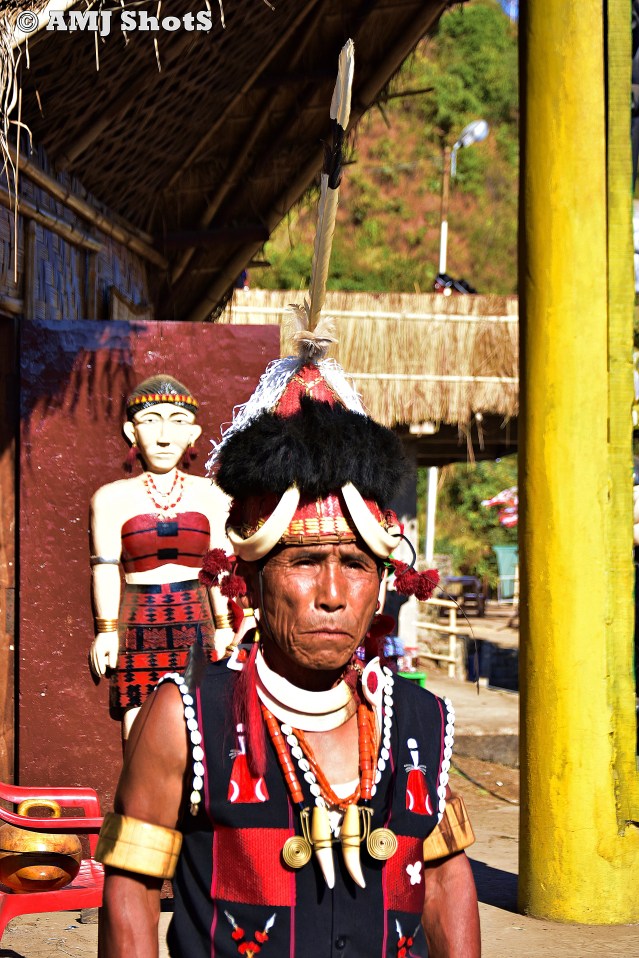
‘Sangtam Naga’ in front of his Morung.
Naga traditions and Cultures are the two main conduit pipes through which one can smell the odours of and peep into the social, political and religious systems of the people and their societies. The Nagas are the ones whose conduit pipes were sealed to the outsiders until the white missionaries changed their hearts thoroughly in the earlyparts of the 20th century and thereby opened up their sealed covers to a few white writers. The term ’Naga’ applies to all people living in compact area between the Brahmaputra river and the Chindwin river. The area of present Nagaland state is only 16,579 Sq. Km. and the Naga areas in Manipur State measure 15,519 Sq. Km. Many Nagas such as Konyaks, Khiamniungans, Yimchungers etc. are living in the Naga Hills of Burma, the exact areas and population of which are not available. Most of the Naga villages stand at a height of 1000-2999 meters. The name Nagas of “Nagaland” as used here, has only one connotation – the present state of Nagaland and not the entire Naga areas including those which are outside Nagaland.
Origin
The origin of the word “Naga” has been a source of much debate among different scholars. The two largely accepted view points are taken from the etymology of the word “Naga” and its varying connotations in the Burmese and the Assamese languages. The basic groups of human race are Caucasoid, Mongoloid and Negroid. The Nagas belong to the Mongoloid group. The hypothesis that the Nagas must have came from the sea coast or at least seen some islands or the seas is strengthened by the life-style of the Nagas and the ornaments being used till today in many Naga villages. The Naga being left undisturbed for such a long time, have retained the cultue of the most ancient times till today. The fondness of Cowrie Shells for beautifying the dress, and use of Conch shells as ornaments (precious ornaments for them) and the facts that the Nagas have many customs and way of life very similar to that of those living in the remote parts of Borneo, Indonesia, Malaysia, etc. indicates that their ancient abode was near the sea, if not in some islands. The long war-drums hewn out of huge logs also feature very much like the Canoes so common with the islanders. It is also a fact that the Nagas ate almost all living sea creatures. It is difficult to say as to when this word came into existence. There are various theories as to the origin of this name ‘Naga’. It is surprising that the Nagas, who are so conscious of the meaning and connotations of their personal names, do not have any meaning for the word ‘Naga’. It is therefore, quite probable that this name ‘Naga’ is not a Naga origin but named and popularized by outsiders to give an identity to those tribes. Different scholars, basing their surmises on the Naga art, material culture, language tonals etc. have theorized that the Nagas have had some links with Indonesian and Malaysia, they belong to the Tibeto-Burma family; are the first stage migration group from North-West China; they constitute a return group of migrants from the Polynesian islands, etc. However, these theories are remotely inferential theories and in the absence of substantive evidence these theories remain inconclusive. In spite of various theories with more or less logical evidences provided for to find out the origin of word Naga and publicized over the centuries is a guess work and it is known to nobody. No Naga living in Nagaland and Manipur state can give a substantial evidence and say as to why they are called Naga. Definitely the word ‘Naga’ is given by the outsiders to these people. But what is the key to this name is nobody knows.
Tribes of Nagaland
Officially there are 17 main tribes in the state of Nagaland. The are Angami (Kohima district), Ao (Mokokchung district), Chakhesang (Phek districk), Chang (Tuensang district), Garo (Dimapur district), Kachari (Dimapur district), Khiamniungan (Tuensang district), Konyak (Mon district), Kuki (Peren district), Lotha (Wokha district), Phom (Longleng district), Pochury (Phek district), Rengma (Kohima district), Sangtam (Tuensang and Kiphire districts), Sumi (Zunheboto district), Yimchunger (Tuensang and Kiphire districts) and Zeliang (Peren district).
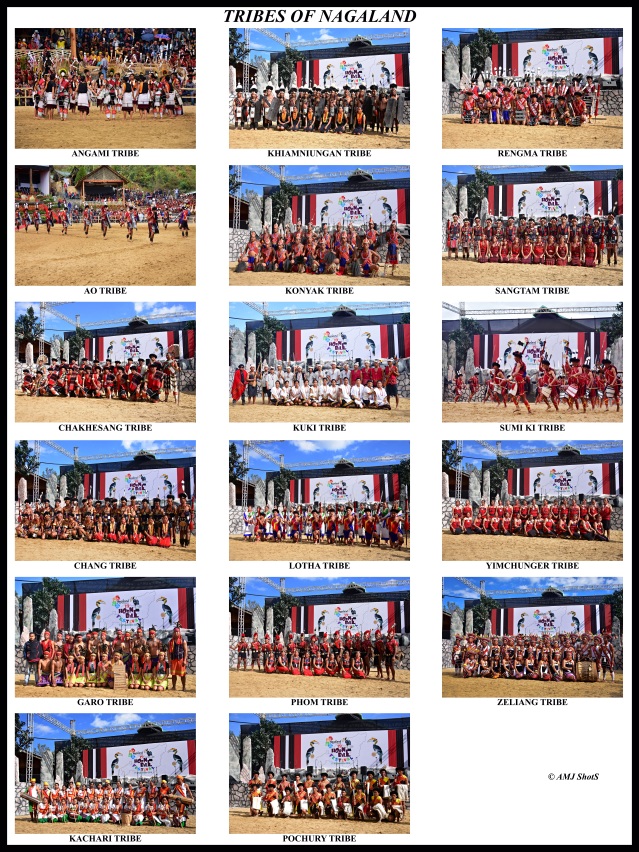
Language
Language is the principal means of communicating culture (a word which itself commonly embraces the entire life of a people. The language of a people provides the means by which they express their way of perceiving things and of coping with them. In the entire North-Eastern states about 8 million tribal people speaking hundreds of different languages. In Nagaland, the Nagas speak their own tribal languages and dialects which vary widely from one another even though their languages, from sufficient evidences, are derived from the same cognate stock in the remote past. Today Nagamese (a hotch-potch of Assamese, Nepali, Bengali, Hindi), Manipuri, Hindi and English are the media of expression among the Naga tribes as well as the outsiders. English is not only the official language of Nagaland but also the medium of instruction and examination in Schools and colleges.
Naga culture and oral history flourished without any written script of their own. Yet they had an effective medium of communication and records that have been preserved for many centuries through the oral tradition based on deep-rooted and time-tested foundations. Any oral narrative of traditional history, origin and migration of the
people (tribe, clan, individual, etc.), formation of the village, events of war, peace, festivals and so on are transmitted by word of mouth from one generation to another through songs, poetry, ballads, prayers, sayings, stories and tales or as public oration when the situation demands. Through such means youngsters were trained
not only to learn but to master them.
Main Occupation
The bulk of the communities in the North-East are still at pre-agricultural stage of economy depending largely on shifting cultivation. Agriculture and animal husbandry have been the basic occupations of the Nagas since time immemorial. Agriculture, both terrace and shifting cultivation is the Primary basis of agrarian economy of the Naga people. All Nagas tribes are primarily agriculturists. Their main crop is rice, millet and maize. Besides, they grow vegetables, like pumpkins and gourds, the latter for use as containers also. The most striking difference between the Angami and their neighbours on the north is their cultivation of wet-rice while other tribes of Nagaland such as AO, Lotha, Rengma and Zeliang cultivate by “Jhuming” (that is, by clearing land and growing crops on it for two years and then allowing it to return to jungle), the Angami has an elaborate system of terracing and irrigation by which he turns the steepest hill sides into flooded rice-fields, and in dealing with his cultivation, this terraced cultivation and ‘Jhuming’ must be treated separately.
Religion

Baptist Church inside the Heritage village at Kisama.
Forms of belief and evolution in the tenets of faith of a people play an important role in the history, growth and development of the people. If we look in to the early history of the Nagas and pay our attention to the traditional beliefs and forms of worship of these people, and how these have changed over the different stretches of time, we can catch an illuminating glimpse into the evolving psyche of these people. Religion, whether in its earliest form of animism or in the modern form of Christianity, has played a vital role in the history of the Naga people. Thus, any view of the Nagas, whether sociological, economical or historical cannot be complete without an effort at tracing out the changing religious patterns of these people. The early Naga tribes believed in spirits. These spirits were teneficient as well as maleficient. A very, important part of the Naga belief in all these spiritual beings was the large number of “gennas”, or ceremonies, for the propitiation of these spirits. These gennas varied from tribe to tribe and from region to region. The intricate system of beliefs and rituals of the Nagas suggests that their religion was a mixture of Animism and polytheism. The two great religions of India – Hinduism and Islam never reached the Nagas, and did not bring them under their influence. Thus, the religion of the Nagas was branded- by the early Christian missionaries as ‘Animism’. It is now a little over one hundred years since the Nagas accepted Christianity as their lives.
Culture and Arts
An average tribal may be shy of contact with the outsider but when the ice is broken he takes no time to deal with any one on terms of equality. Nagas without exception are Xenophobes. They have always been suspicious of all outsiders. One of the first characteristics that strike a visitor to the Angamis, Rengmas and Zeliang is their hospitality. Both men and women are exceedingly good-humoured and always ready for a joke. Their staunchness, too, was proved in France (During second World War) where men who had volunteered to face the utterly unknown and served well in labour corps”.

A Zeliang Naga performing Honey Bee Dance
The art of dancing, partially, was eroded when Nagas accepted Christianity. Nagas usually dance in groups, and sometimes the whole village joins in during their festivals. Dancing enlivens their social life. It promotes unity and brotherhood and looks charming with their colourful ornaments, costumes, cowries, ivory, scarlet hair and brilliant hornbill feathers. These dances now a days take place during their important festivals, including Christmas and New—Year, marriage ceremonies etc. All Naga tribes are full of folklore. They are found of seasonal songs, solo, duet and choric, songs in praise of ancestors, warriors and other heros are the most popular. All Naga tribes are full of folklore.
Headhunting Days of Nagas

Wooden sculpture of a Konyak headhunting warrior with muzzle loading gun
All Nagas love hunting, both for the sport it gives them and for the meat it brings, and a petition for success in the chase finds a place in most ceremonial prayers. Sambhur and barking deer are the animals most frequently hunted by Nagas. Besides this Nagas were champion of head-hunters. The Nagas were head hunters as late as 1858. It was not a rare adventurous action. They collected heads as our children collect stamps. In fact, the practice of head-hunting which existed at different times in various regions of the world, usually originated in the superstition that the human head contains the ‘Soul-Force’. This was believed to govern the rise and fall of a community and thought to be transferable. The slain man had to belong to a different village if his ‘Soul—Force’ was to benefit his killer. An increase in population, cattle or pigs, better crops and other material improvements were believed to demand as accretion of ‘Soul-force’. When the ‘Soul-force’ diminished, the tribes were promoted to embark in head-hunting expeditions to replenish this intangible asset. Head-hunting was a part of every day life of the Nagas, and to a great extent, conditioned their life in the villages. Successful headhunters enjoyed the privilege of wearing special dresses and ornaments. They were distinctively tattooed and accorded with coveted social status. However, inter-villages and inter-tribal clashes were the main cause as well as effect of headhunting in those turbulent days. During the headhunting days, the prettiest girl in the village would consider herself fortunate if she marry the man who had taken the most head during a raid. He automatically became a leader and was respected by the entire village. However, since the embracement of Christianity, things have been changed and animism with head-hunting has been pushed to the background. It became part of Naga history only.
Customs
Naga society is patriarchal, and as such, inheritance is always in the male line. A woman can possess property but she cannot inherit it. All sons equally share the patrimony. Although each Naga tribe has distinct characteristic of its own, they have certain features in common. They are truthful, honest, brave and believe in hero-worship. The Nagas have no prejudice against any kind of food. If a non-Naga refuses their food or dislikes their way of living, they cannot take a liking to him. They will at once feel that he cannot be one of them, if he criticizes or shows his dislike of their way of life, or in any way suggest inferiority of their status. If the objective is to induce them to better modes of living and thinking, it can only be achieved by gradual stages, the first of which is to assure him of one’s sincerity of purpose and not by force or disapproval of these ways of life.
Dress and Ornaments
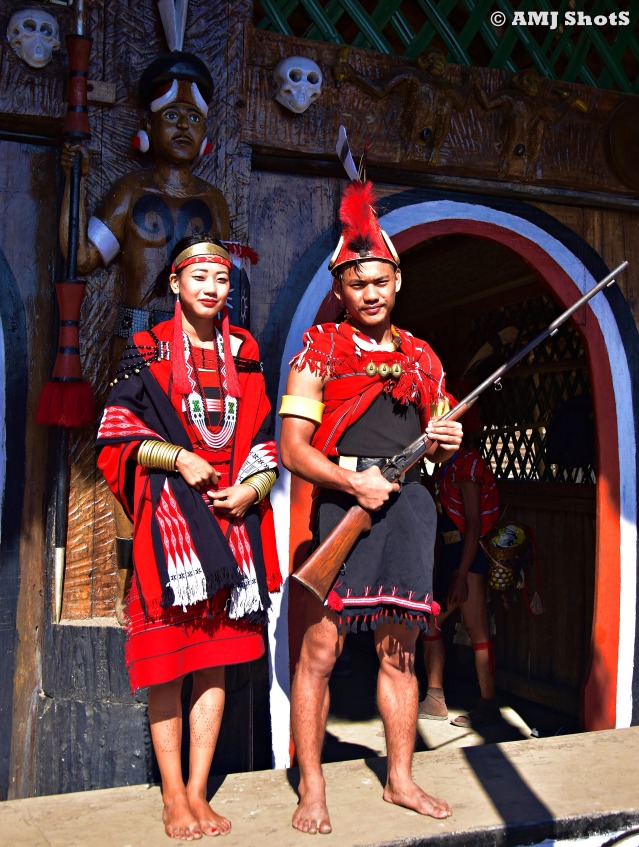
A Phom lady in her traditional attire with a Warrior, who is holding a muzzle-loading gun
The most prominent item of Naga dress is the shawl. It is different for every tribe and, besides, there are varieties and sub-varieties in every group. In the past it was possible to identify, by simply looking at the shawl of the wearer, the tribe he belonged to and occasionally even the group of villages he came from, his social status etc. Nowadays, with the spread of education and civilization almost touching the tribal life. Almost all tribal youth imitating the western style dresses. Every Naga youth has a old or new Jean pant to wear whether it is a villager or urban youth. In spite of this transition, the wearing of shawl is still exist. The cowrie decoration is quite popular among the Nagas. The ornaments are simple but pretty. A necklace of beads is generally worn round the neck. The beads may be made of some kind of stone or shelIs. Dancing dress is yet more colourful. Men’s head dress is a coronet of hornbill feathers, circle in shape, the feathers positioning a convex canopy frame. However, these coronets vary in form according to the status of the wearer. They are fastened at the head by the white cotton robes, held out by a circular shingle.
The men in Nagaland perform War Dance with an outburst cry and humming tune. It can be said, this dance form mocks war scenario by involving dangerous war movements. A single wrong step could ruin an entire act, it’s martial and athletic style requires a performer to whirl his legs while keeping the body in an upward posture. Besides the traditional attire worn by the performers are simply unique. Thus a blend of vibrant hues, great music, cultural dance and delicious food, the week-long Hornbill Festival celebrates the traditional values of Nagaland’s 16 tribes. This colourful festival is also one of the major crowd-pullers for the state and falls in what is believed to be the best time to visit the state. Not many are aware of the fact that the Hornbill Festival is named after a bird mentioned earlier – “Tragopan Blythii”.
“The Hornbill Festival of Nagaland”
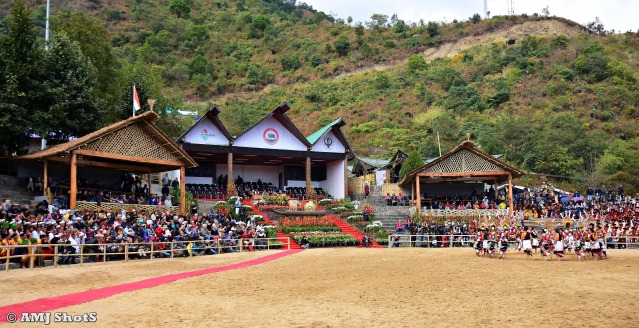
Angami tribe performing Melo Phita Dance in the main arena of Hornbill festival 2018
Spirits, fertility, social bonding and purification are the key elements that form the the essence of the Naga festivals – the custom that each tribe follows, translates into a festival. These traditional events, combined with life in the rural areas, are exceptionally engaging and distinctive. All of them are annual events with fixed dates; hence, before visiting Nagaland, the interested traveler can arrange his or her calendar accordingly. The first festival takes place in January and the last in December – no matter what the season is, some festival is always around the corner.
It was in the year 2000, that the State Government desirous of promoting tourism embarked upon an ambitious project with the help of BASN (Beauty and Aesthetics Society of Nagaland), to exploit the cultural assets of Nagas, through a week long festival to coincide with the celebration of Nagaland Statehood Day on 1st December. Thus, the inception of the Nagaland Hornbill Festival so named in collective reverence to the bird enshrined in the cultural ethos of the Nagas to espouse the spirit of unity in diversity.
The Hornbill Festival takes place between the 1st December, which happens to be the Nagaland Formation Day, till the 10th of December, annually. Recently, seeing its grand success and achievement at attracting tourists from far and wide from across India and abroad, the Hornbill Festival has been extended by another three days till the 10th of December. The aim of the festival is to revive and protect the rich culture of Nagaland and display its extravaganza and traditions. Organized by the State Tourism and Art & Culture Departments of Nagaland, Hornbill Festival showcases a melange of cultural displays under one roof at a model village built at Kisama, a western Angami location situated 12 kms away from Kohima, the capital of Nagaland. History abounds in every nook and corner of the terrain here. Kisama falls on the historically famed Kohima-Imphal Road, now a busy highway cutting through Angami hamlets connecting Dimapur with Manipur, once the theatre of the fiercest of battles fought between the defending British forces and an advancing Japanese army during World War II.
Dotting the hillside of the Kisama Heritage Village, the location of the Hornbill Festival each year, are these hubs of warmth, food and easy camaraderie where visitors can seek out a Naga meal with sticky rice, smoked pork and pickled bamboo shoots, each morung offering its own varieties of meat and spices and Zutho, their fermented rice beer. As temperatures dip with sundown by 4.30 pm, visitors huddle around the coal and wood fires in the morungs, tall bamboo tumblers of beer in hand, as musicians start tuning up for the evening performance at the amphitheatre.
For visitors it means a closer understanding of the people and diverse culture of Nagas, and an opportunity to experience Naga food which is no less varied, as are the songs, dances and customs of the place. This colourful festival is a certain paradise for a foodie, particularly if one happens to be a non- vegetarian. Nagas love to feast and feed, and at Kisama one can try all kinds of Naga traditional food and also watch them being made during the Hornbill Festival days. Tourists are welcomed warmly to the traditional huts of each tribe showcasing respective traditions. For those interested, one may seat with the youths and elderly people of the tribes alike and interact with them. One can also take part in various contests such as Naga chilly eating, pork eating besides traditional games and other traditional competitions.
Heritage Village, Kisama, Kohima District
The nomenclature of KISAMA is derived from two villages namely, Kigwema (KI) and Phesama (SA) and MA which means Village, on whose land the Naga Heritage Village is established and commissioned by the State Government of Nagaland.

Entrance Gate of the Heritage village at Kisama
The Heritage Village was set up with an objective to protect and preserve all ethnic cultural heritages by establishing a common management approach and comprehensive data base for perpetuation and maintenance for promotion of tourism. It also aims to uphold and sustain the distinct identity of dialects, customs and traditions of all the ethnic tribes of Nagaland.
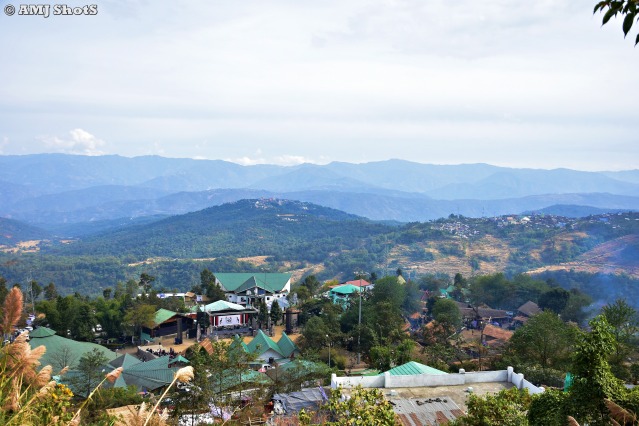
Kisama Heritage village and surrounding Naga hills…
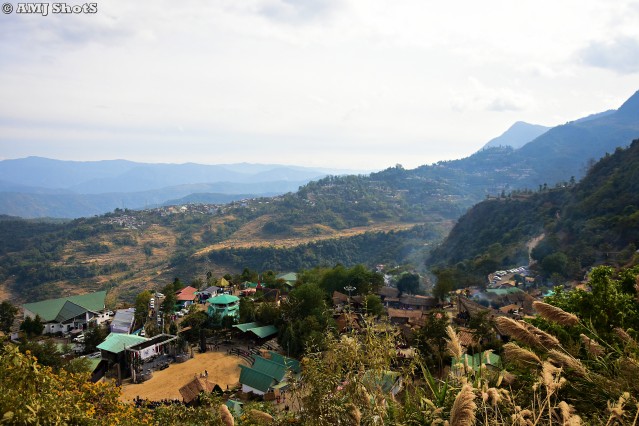
The Naga heritage village placed on the foot hills of a magnificent green valley

The Main Arena of Naga Heritage Village.
Contrary to what many people believe, the actual site of Hornbill festival is located at about a 20-minute drive from Kohima (if the traffic isn’t brutal, 12 kms from Kohima town) in the Kisama Heritage Village. And those not bitten by the idea of staying in the capital city of Kohima, like me, should consider staying in the town of Kigwema (the next village at only a walking distance from Kisama) to avoid bleeding unnecessary time in the traffic. Compared to Kisama, which more or less offers a crowded and bustling city experience, Kigwema is, moreover, less-crowded, laid back and provides all necessary comforts for a tourist. Buf if you want to experience the night carnival in Kohima town during hornbill days, you should consider staying there…

Shots from the surroundings of Kisama Heritage village.
Heritage Complex, Naga heritage village at Kisama
The Heritage Complex consists of a main arena with central stage and a cluster of 17 house of each tribe created in the indigenous typical architectural designs and concepts with significance. The tribal house is also called “Morung or Youth Dormitory.” Colorful life and culture are a vital part of the 17 officially recognized Naga tribes. They are different and unique in their customs and traditions. These customs and traditions are further translated into festivals. Songs and dances form a soul of these festivals through which their oral history has been passed down generations.
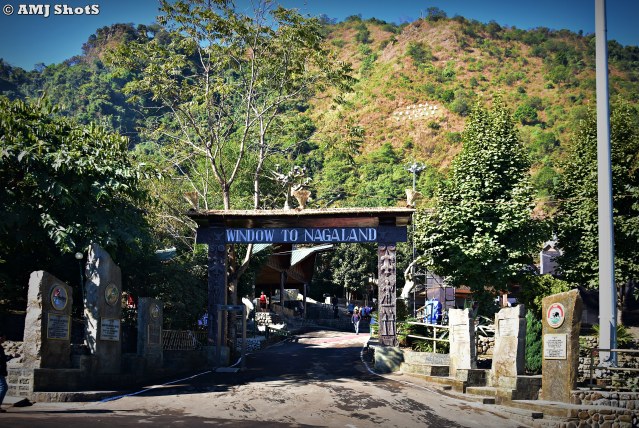
Entrance Gate of Hornbill Festival Main Arena.

Main Arena with VVIP Rostrums, Central stage and Audience pavilions…

Hornbill Tree – In recognition of the State bird and as a tribute to the ‘festival of festivals’, placed on the occasion of 15th Hornbill festival, 2015. The majestic hornbill is a Nagaland emblem which represents loyalty, because of the female bird staying in the high nest and relying on her male to feed her. In the past, the right to use hornbill feathers had to be earned, feathers were not for sale, and only those that excelled in warfare received the honor to decorate themselves with the feathers. The Naga tribes recently realized the damages they have done on the species, so they stopped hunting them and now protect them instead. It could be already too late thou to avoid total extinction.
The Heritage Complex also house World War II Museum (World War II Museum that houses relics from the 1944 battle of Kohima, which first put Nagaland on the global map), Bamboo Heritage Hall, Bamboo Pavilion, Kids Carnival, Horti-Scape, Food Courts and Stadium for Live concerts, Naga Idol, Beauty Pageant, Fashion Shows, etc.
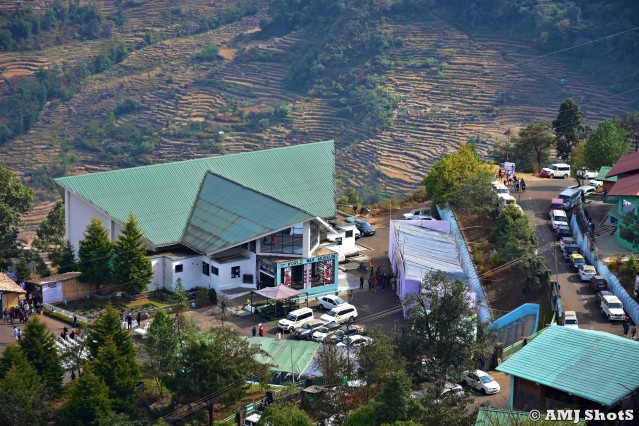
Second World War Museum

Dodge Power Wagon – Exhibited in front of the Second World War museum, which was used during the Great Battle of Kohima by British military forces.
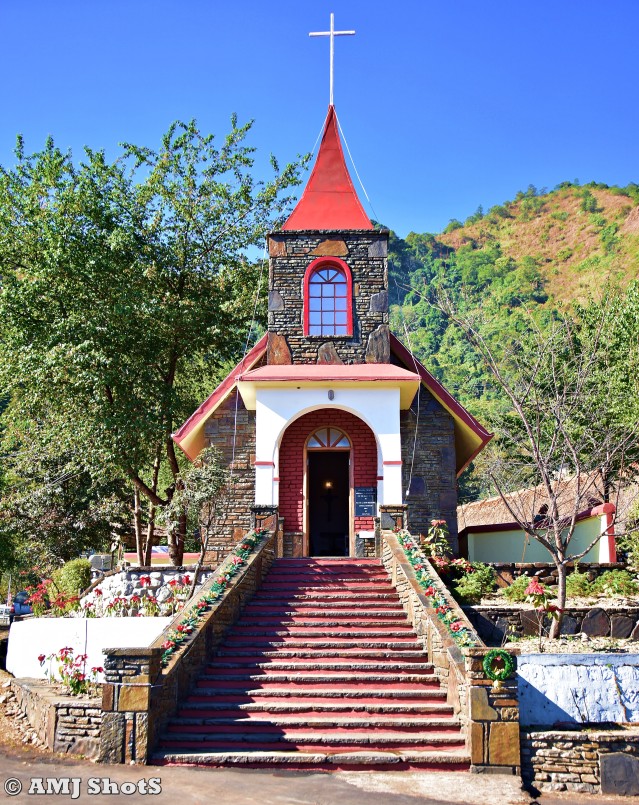
Baptist Church in front of Naga Heritage village at Kisama

Bamboo Pavilion with the bamboo heritage hall. This pavilion comprises numerous stalls selling a plethora of items such as handicrafts, tribal ornaments, ethnic food items, Naga dresses, artifacts and souvenirs.
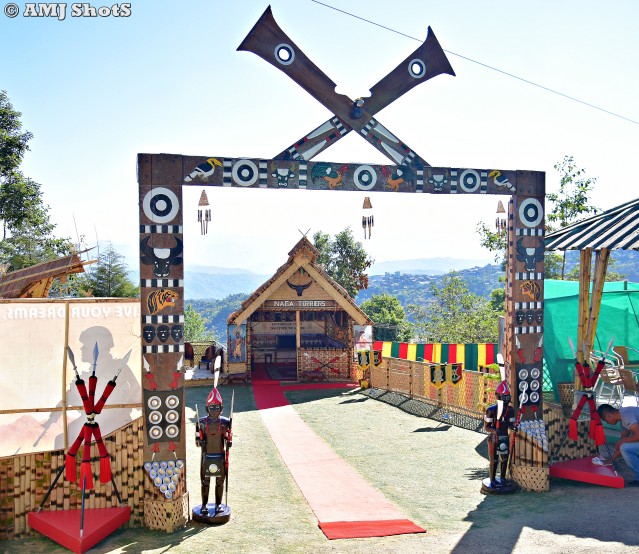
An exhibition of Naga Terriers
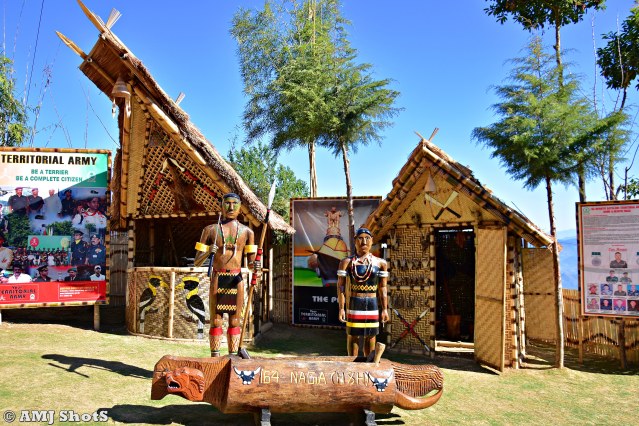
Wooden sculptures of a Naga warrior with a tribal woman, standing in front of their traditional hut
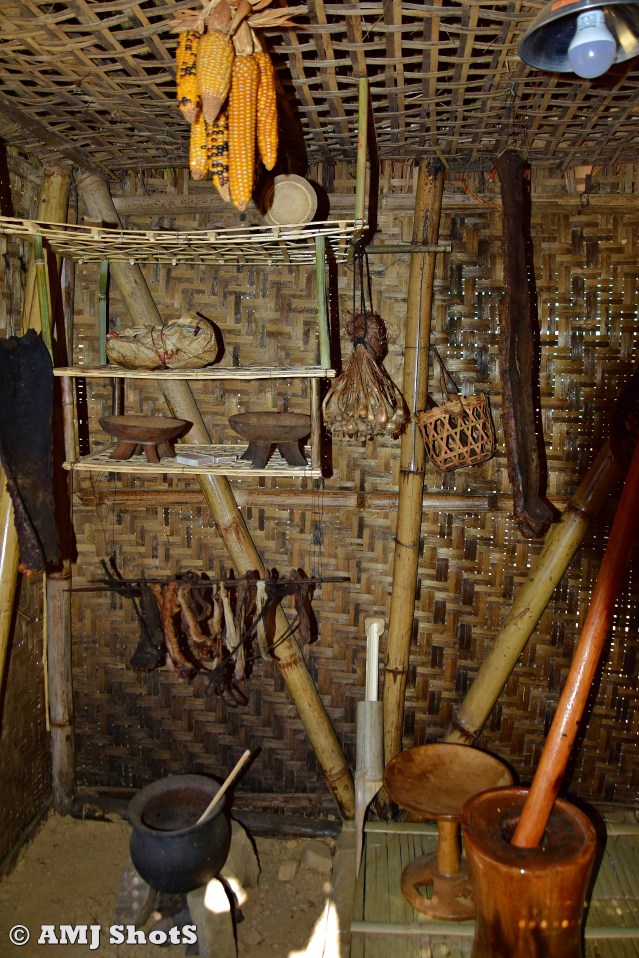
Inside of a traditional Naga hut with household equipments and utensils
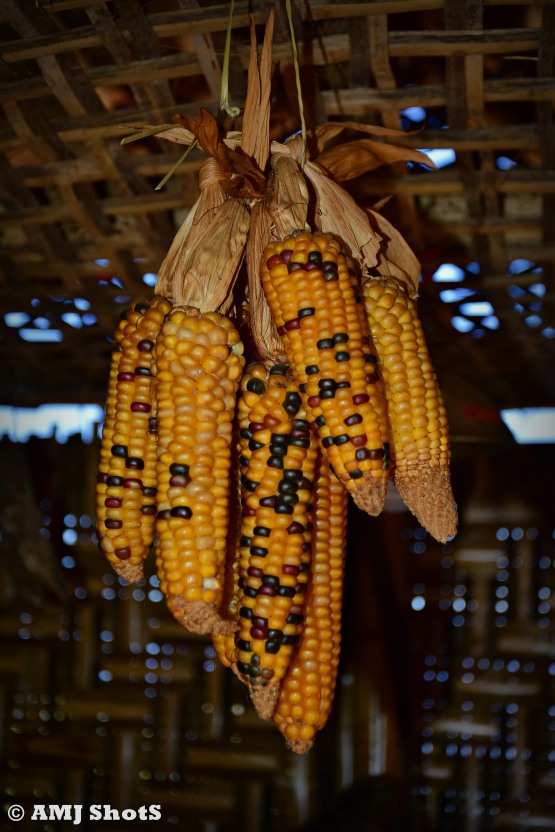
Stalks of Corn seeds hanging from the ceiling – Inside a traditional hut of Nagas.
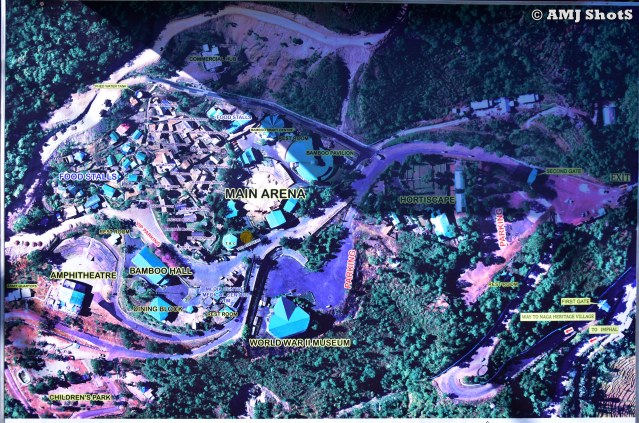
Map of Naga Heritage Village, Kisama
Altogether, this festival highlights include Traditional Naga Morungs exhibition and sale of Arts and Crafts, Food Stalls, Herbal Medicine Stalls, Flower shows and sales, Cultural Medley-songs and dances, Fashion shows, Beauty Contest, Traditional Archery, Naga wrestling, Indigenous Games, and Musical concert.
Story of ‘My long journey’ to Kohima
As a traveler from South Kerala, a journey to Nagaland wasn’t that easy, especially when you wanted it to be cost effective. My plan was to spent 7 days in Kohima, from December 2 to December 9 and a 4-day train journey was needed to reach, the only available railway station in Nagaland state, Dimapur. So, in total, the entire trip lasted for 14 days. Being Indian railway as the only option for me at that time, i booked a sleeper ticket in Chennai – Dibrugarh express, which can take about 60 long hours to reach the Dimapur railway station.
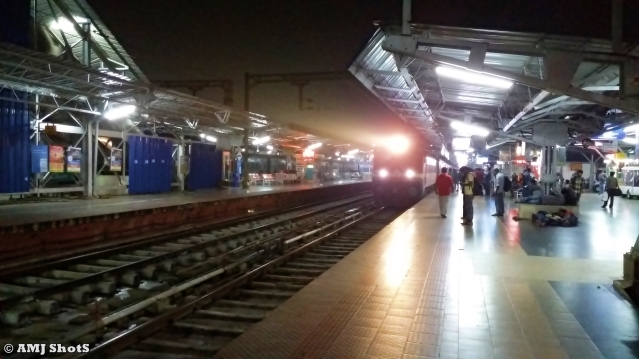
Traveling up to Chennai in Guruvayoor – Chennai Egmore express, on 29th November was really a smooth journey. No real hardships in that Journey. But on the same night, that Dibrugarh express leaving the Egmore station, shocked me, with the worst overcrowding I can remember each and every moment of that hectic journey, even today. The sleeper compartment, where more than 150 people are crammed into a space fit for just 72. Bodies dripping sweat, satchels welded to the arm and voices raised to holler at those stepping on their toes: the compartment was filled with migrant workers from Northeast at Chennai itself. For the first few hours, i couldn’t even touch the floor of my compartment because berth i reserved was side upper and also the compartment got packed so tightly. Those migrant workers were going to their homes for spending the upcoming holidays. There was no concept of personal space in crowded compartment like this. What made things fun was that, as soon as you talk to a passenger it turns into a group discussion. It was crowded and noisy throughout the journey. Sometimes even an entire market will pass through that crowded space. How it happens?… Nobody knows that!

For the first 2 days, i was so tensed because of security issues. As my trip was solo, i needed to be feel secure in every moment of it. There were some precious cargos like camera, its gears etc in the bag. That’s the reason, i was worried and couldn’t even shut my eyes properly during nights. The wash basins and toilets were so dirty as people who use it, most of them don’t even bother to flush them. Oh! that was hell of a journey. The only positive thing happened in that train was getting acquainted with a brother from Assam, who is currently working in the oil fields of Tamilnadu, Mr. Debabrat. He, too was going back to his mainland for spending the vacation with his family. By the time train reached Dimapur railway station, i was really tired and needed to reach Kohima, so fast.
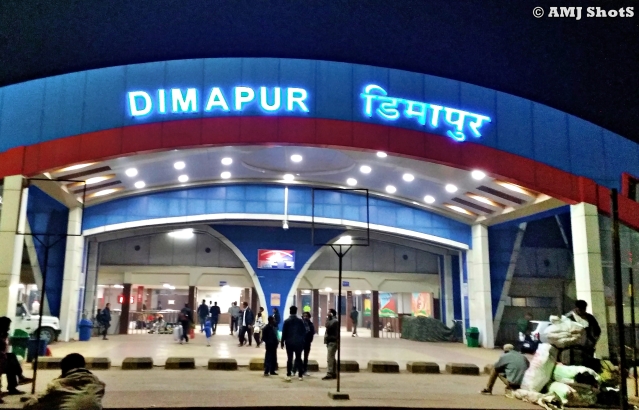
Dimapur Railway Station – The only available railway station in the state of Nagaland. The Dimapur district also houses the sole airport in Nagaland with scheduled commercial services to Kolkata, West Bengal, and Dibrugarh, Assam.
Dimapur-Kohima road wasn’t very good in shape and took about 4 hours for just a 76km distance. During winter, daylight in this part of India is moreover very limited and often gets dark before 5pm. driving from Dimapur to Kohima turned out to be a nightmare, because of the poor road condition. The road was under construction transforming a seemingly narrow dirt-track into a four-lane highway, and with that, changing everything bit of a beautiful green into a dusty yellow. You have to hire a private cab or find taxi to arrive at your final destination – Kohima. Luckily, i got a share taxi and it costed me 500 rupees (normally 300 for a person) because of the bulky luggage with me.

Taxis of Kohima
Permits for Nagaland
As you must already be knowing, Indian tourists need to get Inner Line Permits (ILP) for Nagaland. Interestingly, the same is not required for the foreigners (in an effort to encourage tourism). The international tourist however still have to register themselves at the Foreigner Registration Office once they enter Nagaland. You can get the permit at designated offices in Delhi, Guwahati, or at Dimapur on arrival. If you could not make it earlier, the best way is to reach Dimpaur and visit the DC (Deputy Commissioner) office as early as possible, so that you get it sorted by noon. You need valid ID and photographs. The process is not very strict for tourists and I have seen that they become lenient during the festival as nobody asked for my permit on the road.
Where was I stayed in on those 7 Days ???
As you already know, my plan was to spend a whole week with the Hornbill festival of Nagaland. So, I really needed to stay in Kohima town center and find a budget hotel with optimum facilities.

Expanded Kohima Town center in front of the War cemetery. It is the historical landmark, where the infamous Battle of Kohima during 2nd World War took place.
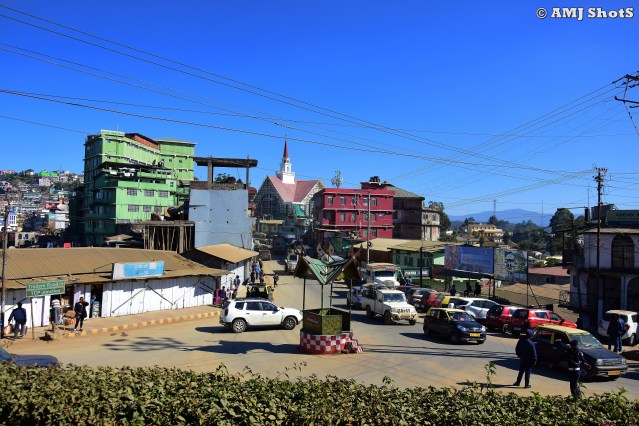
War Cemetery junction of Kohima town center.
Thankfully, because of the contacts and efforts from my uncle, Mr. Mohanan, who has been working in Nagaland as a high school teacher for more than 30 years, the accommodations for the next 7 days was arranged in the Hotel Galaxy, just 200 metres from this war cemetery junction.
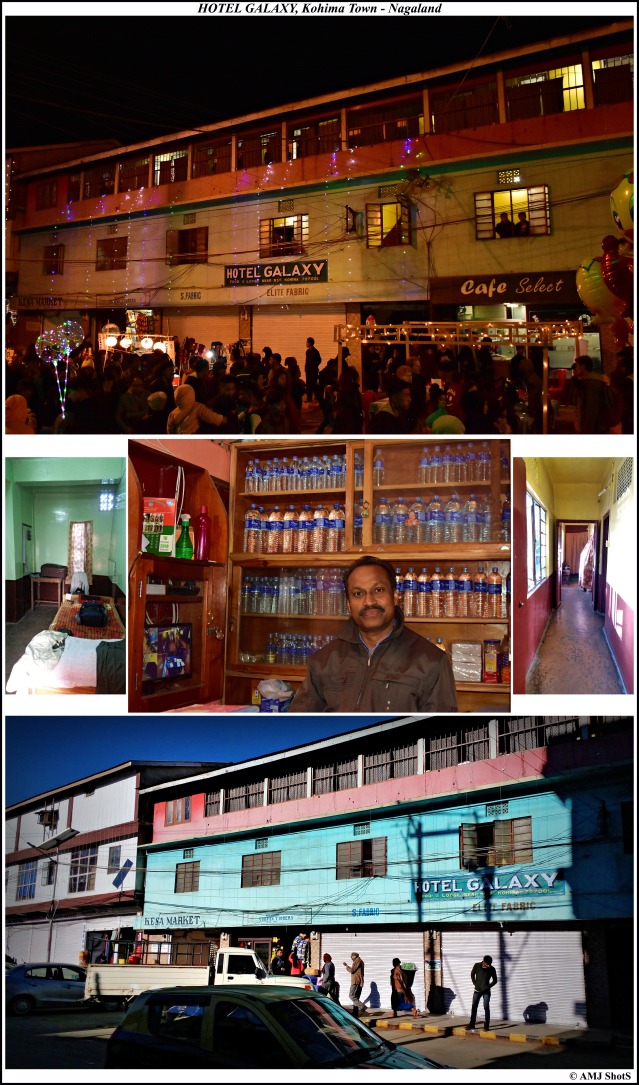
Hotel Galaxy – A perfect budget hotel for a solo traveler with enough securities to free from all tensions. Single rooms with TV (almost all hindi, english and malayalam channels are available) cost Rs 500 for a night (with separate toilets)… that’s an awesome pick in Kohima town, especially during these festival days. And this hotel is located just 100 mts from the NSTC bus station (Razhu point)… that’s a bonus. Last, but not the least, a friendly and helpful reception to do whatever you need to have a comfortable stay….

Mr. Shaji, Owner of Galaxy and Evergreen hotels – A friendly and gentle person who is proud in sharing his 33 years of life experiences of Nagaland, without any hesitation to a complete stranger like me. That’s how humble, he is. He is from Kottayam district of Kerala. So communicating with him made me confident enough to travel anywhere in Kohima town.

Razhu Point near the Hotel Galaxy – A 100 mts straight walk towards north will lead you to this point. You will get short bus services from NSTC (Nagaland State Transport Corporation) to the BOC junction in this point. Actually Hotel Galaxy is located mid-way between Old NST junction and Razhu point.
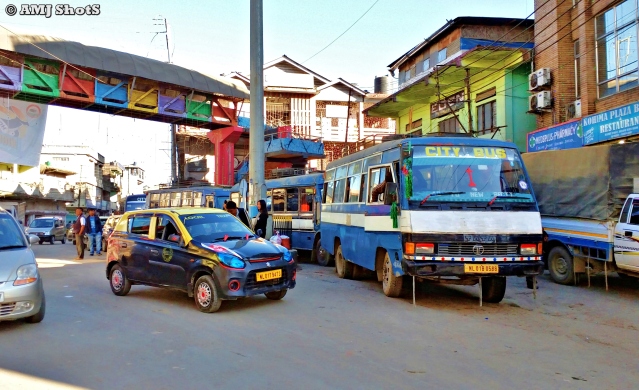
Bus services of NSTC and Taxi services are available in this Razhu point.

A look at the flourishing Kohima town on these Naga hills…

Map of Kohima District
If you want to travel to the Naga Heritage village at Kisama from Kohima town center, first, you need to get a bus service from the Razhu point (Rs 10 per person, end to end service) to reach BOC junction. Then find a share taxi (4-5 persons per taxi and Rs 50 for each) to reach the final destination – ‘Kisama Heritage Village’.
Now I have to get into the details of those mesmerizing moments from the 19th Hornbill Festival 2018…..
Exploring Cultural Extravaganzas of the 19th Hornbill Festival 2018 – Nagaland
Following content focuses on the exciting moments filled with vibrant colours of Nagas, during my expeditions of Hornbill festival 2018 (from December 3rd to 8th, in Naga Heritage village at Kisama). Morung exhibitions and cultural sessions happening in the main arena are the two major things that you need to look out for, while you explore the festival days at Naga heritage village……

Way to Naga Morungs…. If you are interested in photography, visit these morungs in the early mornings, especially before 9am. It can enhance your chances in getting some real life shots…
All the Naga tribes have dormitory organisation known as Morung, a sort of the bachelors’ club where boys are gathered to spend the night. Morung is a vital corporate village institution as a centre of the village ceremonies, arts, music and folk-songs, and field of training, to young men in undertaking duties for the village welfare . In modern term, the village morung is a club-house, a reformation centre, a museum etc. Every village of the tribes like Angamis, is divided into ‘Khel’ of which the boundaries on the ground are exactly known often the ‘Khels’ are called after clans. Each ‘Khel’ had its own ‘morung’. It was a place where no crime be committed. Property could be left lying about in one with absolute safety, for to steal was taboo. An admirable institution, the morung disciplined and educated the young. Now a days ‘morungs’ are no longer seen in the villages. It is, of course, seen in a few villages unused. But it still gives the picture of sanctity, and it is looked as a museum for the present generation. It symbolises the unity of the clan or of a particular Khel. It is now-a-days standing as the pride of the village.
1. Angamis of Nagaland
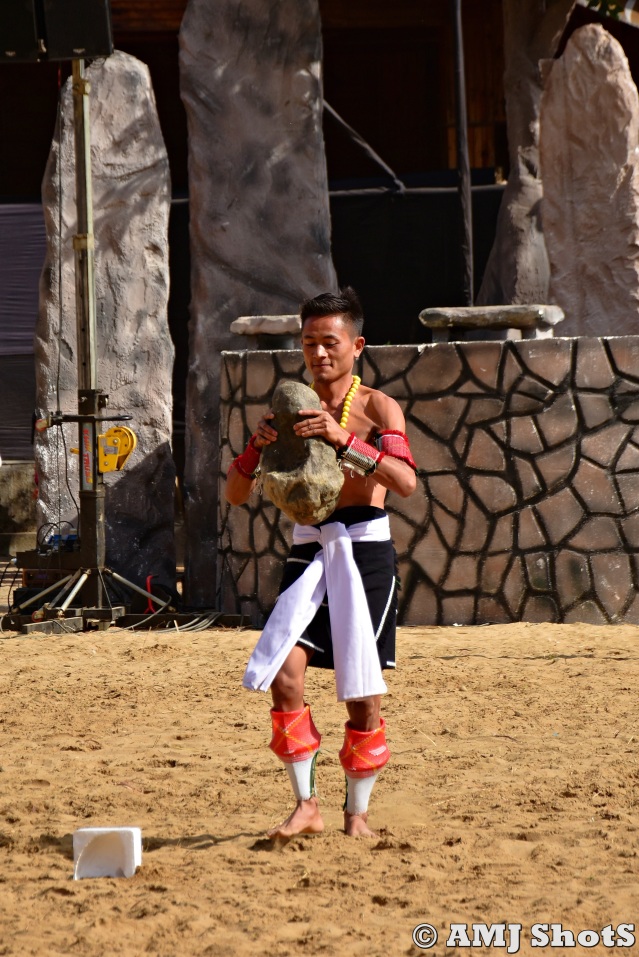
An Angami Naga performing “Neiyie Tsupre” challenge (A test of strength and maturity among Angami youth)
Angami people are the first tribal society to have settled in Northeast India. They are listed as a Scheduled Tribe, in the 5th schedule of the Indian Constitution. According to one legend, the ancestors of the Naga tribes were brothers who lived together with their parents in Khezhakenoma village. When the three brothers spread out, the Angamis came to the present Kohima area. In another legend it is believed that Maikel Stone (Present day Manipur) was the place where ancestors of the Angamis emerged from the earth. Many festivals are also observed by the community according to their culture and tradition. Tendydie, Gnamei, Angami and Tsoghami are mother tongue of Angami Tribes. Tendydie is the one most commonly used. The domination by this tribe of their hills is further understood by their sub-divisions in land, such as Southern Angami (south part of Kohima located on the foothills of Mount Japfu); Western Angami (west side of Kohima) and Northern Angami (northern part of Kohima). The former Eastern Angami have separated and are now recognized as Chakhesang.

Traditional Angami Morung
Angamis prefer to live in the top of hills, which probably has to do with observing a line of sight to invading enemies. Their villages vary in size and observe democracy. Though there’s a village headman, decisions are made with the consent of elders and important persons of the village. Their staple food is rice and drink is Zu (rice beer) which is brewed in every home. The Angamis are also one of the earliest Naga tribes to end their practice of headhunting, which was once a test of bravery, in 1905.
The hill people depend mostly on cultivation and livestock-rearing. They are one of the only 2 tribes out of the sixteen Naga tribes who practice wet-rice cultivation on beautiful terraces carved out on the hill slopes. Due to this labor intensive method of cultivation, land is considered as the most important form of property. Woodcrafts and artworks are the other common means of livelihood, which are performed with great skill. This can be observed in the variety of house doors and clan-gates found in a village. Spinning, weaving, pottery and basketry are also pursued by the tribe, whereas weaving is a must for every Angami woman. The Angamis are also rich in folk-songs, folk dances and folktales.
Sekrenyi (sometimes also called Phousanyi) is the most significant festival celebrated by Angami people. The festival is observed for 10 days in the month of February every year. Literally, Sekrenyi means ‘sanctification festival’ (sekre = sanctification; nyi = feast; thenyi = festival) . The festival falls on the 25th day of month Kezei (according to Angami Calendar) and is celebrated after the harvesting of fields. It is observed in a very traditional and religious manner. The most interesting day of the festival is the thekra hie, when young and old people wearing their traditional dresses sit together and spend the day singing songs, performing dances, have feasts, drinking beer and merry making. All the work ceases during the ten days of feasting and song. It is no wonder that Nagaland is called the ‘land of festivals’.
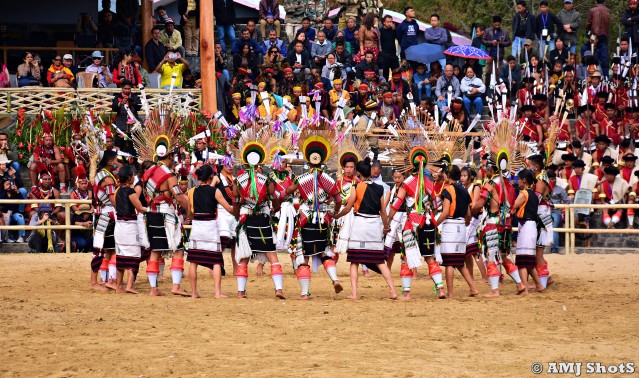
“Melo Phita Dance” of Angamis – A warrior dance performed by men folk. Dancers form a circle and perform rhythmatic steps in accordance with folk songs.

Melo Phita Dance – This dance is performed as a part of the friendship ritual ‘ Phita thenyi ‘ between the inter-villages of Angami tribe. During this ritual, the friendly villagers hosts each other with folk songs and dances.
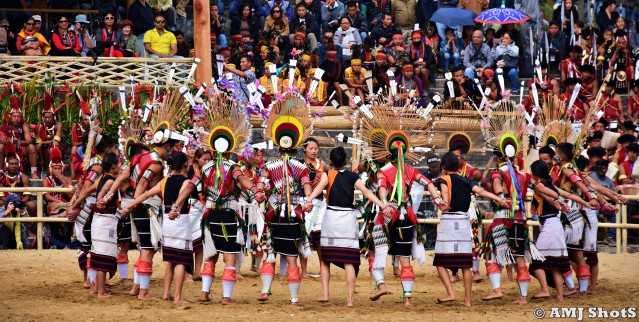
Melo Phita Dance – The citizens of one village hosts the guests from other villages, in process of making friendships between them.
Neiyie Tsupre (test of strength and maturity) – In olden times, young lads attempted to carry a stone held above their head without touching their body around a yard to show their strength and eligibility for marriage. Failure to accomplish this was interpreted to mean immaturity.

After doing the test, the Angamis challenge the members of other Naga tribes and audiences to participate in Neiyie Tsupre.
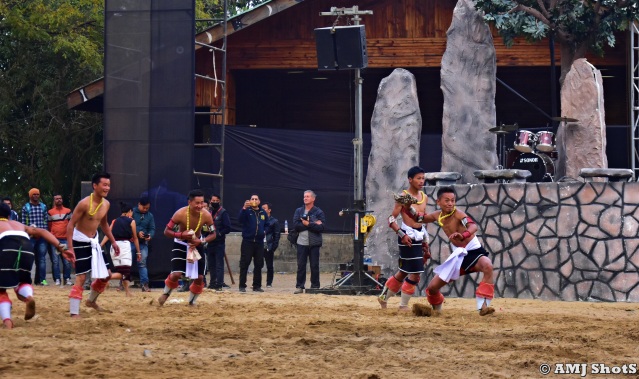
A moment from the traditional game of Angamis – “Khwe Mele Pwe Kejo” , two groups of Angami youngsters will stand opposite and then, throw small cloth balls (made from shawls) and try to hit at the members of opponent team to score points.

Angami men and women folk together performing ” Nyokro Kewa Khwe “ – A song with dance performed during the rice pounding occasions in agri fields near the villages.
Currently, Angami tribes are divided into five major types namely Seventh Day Adventist, Baptist, Pentecostal, Christian Revival and Roman Catholic. Eighty percent of the population of Angamis follow the Baptist, with churches in the Angami region being owned and operated by Angami Baptist Church Council. It is to be noted that there are still some Angamis who follow an animist Pfutsana religion, thus denying to convert to Christianity. Historically, Angami religion was that of tsana (meaning ‘way of ancestors’), which was characterized by belief in spirits. Above all creature, the chief, was Kepenuopfu, who was considered the creator and supreme being of all living creatures. The literal meaning of Kepenuopfu is simply ‘birth-spirit’. The Angamis also had deities as ‘terhoma’ meaning spirits, but when the missionaries came and translated the word terhoma, they termed it as ‘satan’. This made the notion of all the terhoma be considered as evil in the minds of the people, even when the qualities of some of them were definitely benevolent.
2. Ao Tribe of Nagaland
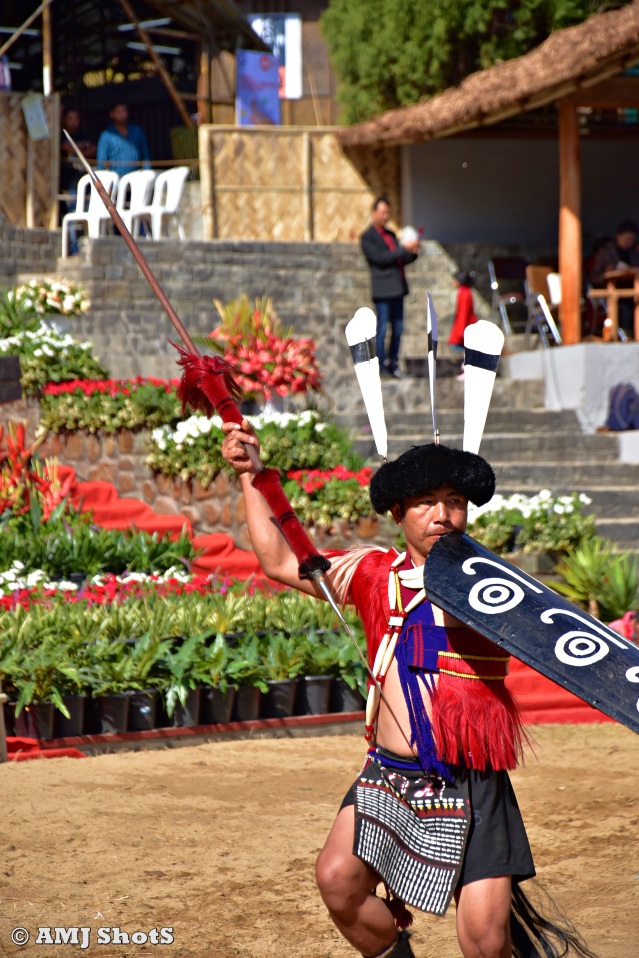
Ao Naga performing ” Tsungremong Dance “
The Aos are one of the major Naga tribes in Nagaland. They are first among all the Naga tribes to embrace Christianity and by virtue of this development the Aos avail themselves to Western education that came along with Christianity. In the process the Aos became the pioneering tribe among the Nagas in many fields. Christianity first entered into the Ao territory when an American Baptist missionary Edwin W. Clark reached an Ao village called Molungkimong in 1872. Their main territory is from Tsula (Dikhu) Valley in the east to Tsurang (Disai) Valley in the west in Mokokchung district. They are well known for multiple harvest festivals held each year.
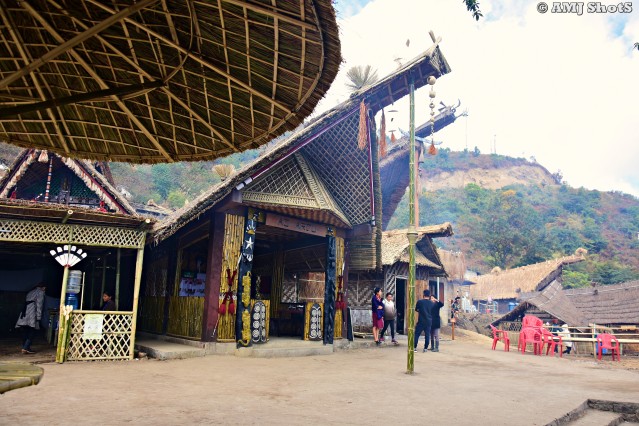
Traditional Ao Morung
Ao Nagas are found in the north-eastern part of Nagaland, mostly in the central Mokokchung District and also a few are found in the adjacent Assam state. Mokokchung, one of the districts in Nagaland, is considered as the home of the Ao Naga tribe. It covers an area of 1,615 Sq km and is bounded by Assam to its north, Wokha to its west, Tuensang to its east, and Zunheboto to its south. The physiography of the district shows six distinct hill ranges which are more or less parallel to each other and run in the south-east direction.
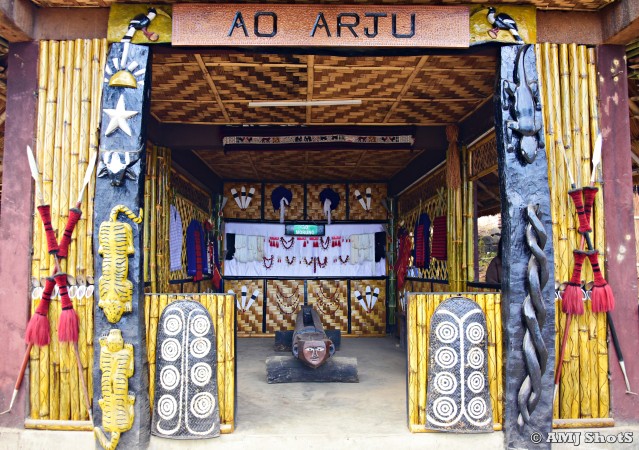
Inside of an Ao Morung – There is a traditional log drum of Ao Nagas placed at the centre.
According to the folklores, the Ao Nagas emerged from ‘six stones’. These stones symbolise their forefathers and that location is named as ‘Longterok’ which means six stones. These stones are still intact at Chungliyimti in Tuensang district. From this village, the Ao tribe moved towards northern region crossing a river named Tzula and settled at Soyim, also known as Ungma today. This was the first Ao Village ever known. After a few centuries, a group of people moved further to the north-east of Soyim and settled at a place named as Mokokchung, or today’s Mokokchung village. Many other Ao Naga villages came into being when people migrated out from this village including Ungma in the later part.
The main annual festivals that were popular in the past are the Moatsu Mong and the Tsungremong. The Moatsu festival is celebrated on 2 May in honour of Lijaba, the creator of the whole earth, to appeal for his blessings in the cultivation that immediately follows after the sowing season. It is celebrated with vigorous singing and dancing, continues the customary practices f making the best rice beer and rearing the best pigs and cows for slaughtering during the festival. The womenfolk, dressed in their traditional fineries, join the men folk in composing warrior songs. Villagers sing songs to eulogize the lovers and the village folk as a whole. the elders encourage the youth to be bold and heroic for defending the villages from enemies, a custom continued from the head hunting days.
The Tsungremong festival or the ‘festival of blessing’ is a celebration for harvesting, which is held during the 1st week of August. Tsungremong, named after the man who started the ritual, is a thanksgiving festival.

Tsungremong Dance of Aos – This dance is performed during Tsungremong festival. The natives wear their colourful traditional garbs, sing traditional songs and perform their ritualistic dances to express their gratitude to god for giving a high yield. The festival also provides opportunities for the budding generations and other villagers to display their skills and physical strength. the festivity is symbolic of a good harvest and members of Ao community gather to thank God for blessing them with a rich harvest.
“Man knows since primitive days that without God, there is no blessing. And Ao Naga tribe has understood it very clearly. This Tsungremong is to particularly ask God to bless and to invoke God’s blessings in one’s life.”
Next one is the “Hornbill Dance of Aos” ……
Hornbill dance performed by the Ao tribe honouring the grand hornbill bird which is regarded as a symbol of valour, faithfulness and noble disposition, much admired for its majestic movements and instinctive alertness. The dance imitate the footsteps of the bird as it feasts leisurely on top of the tree with pride, hoping from one branch to the other selecting and feasting on their choicest fruits.

” Tenem Sungjok or Hornbill dance “ – The Hornbill bird is regarded as bravery, valour and beauty. It is developed in synchronizing with the mystical movements of Hornbill bird. In this dance the forward and backward movement of the dances imitate how bird moves on the branches of the trees. This dance is performed during all the major festivals of Ao tribe. Hornbill dance occupies a high place of honour among all the traditional dances of Nagas.
Now look at the Head Hunter’s Dance of Aos….

Ao Nagas performing ” Head Hunter’s Dance “ with an outburst cry and humming tune.

Head Hunter’s Dance of Aos – It can be said, this dance form mocks war scenario by involving dangerous war movements. A single wrong step could ruin an entire act, it’s martial and athletic style requires a performer to whirl his legs while keeping the body in an upward posture.
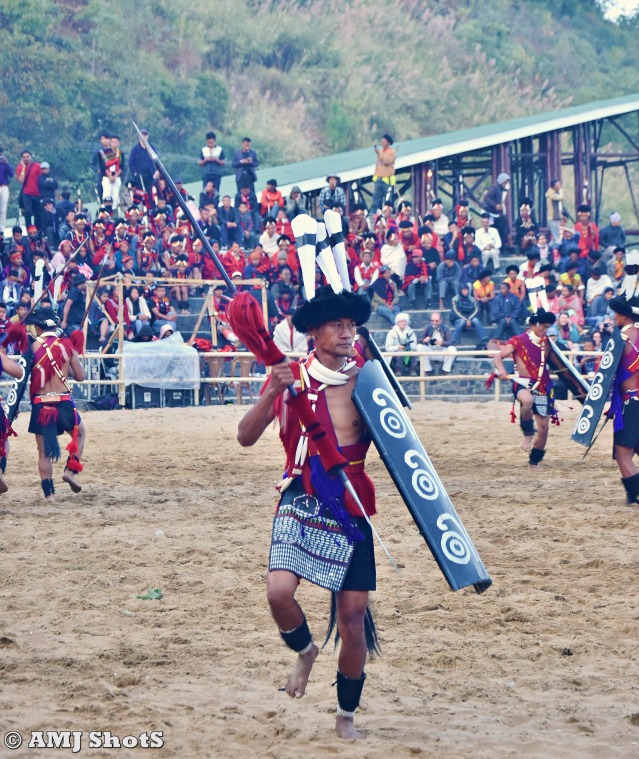
Ao Naga performing Head Hunter’s Dance – The traditional attire worn by the performers are simply unique and they carry weapons such as Dao and long spears. The ‘Dao’ is the life-long
companion of Nagas. The weapon consists of a blade about twelve inches long, its breadth being more at the tip (about four inches) than at base (about one inch). The blade is fitted into a wooden handle which is tightly bound with cane or iron. The dao is carried in the holder at the back.

Head Hunter’s Dance of Ao Tribe – Chanting, clapping and shouting of words, thumping of feet, gracefully endowed with traditional headgear and clothes inspires every member of the group and the spectators as well. In order to add vigour to the dance, the performers are garnished in metal ornaments.
Their is an interesting indigenous game played among the Ao nagas – The Go Kart Race...
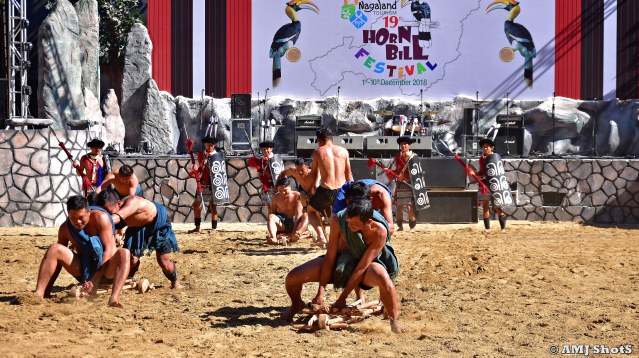
” Go-Karting “ of Ao Nagas
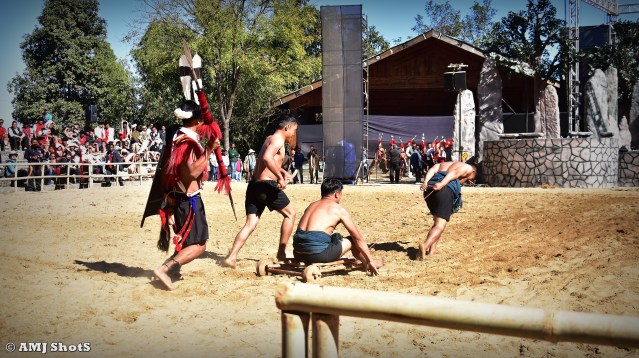
Traditional Go-Kart Race of Ao Nagas – Played two players in a team. One has to pull and the other has to sit and push the Go-Kart (Wooden car), towards the finish line. The car is made up with 3 small wooden wheels. As the festival’s main arena is filled with sand, the racing gets even tougher than usual.
Racially the Ao Nagas are Mongolians, therefore all Mokokchung villagers are Mongolians and is believed to have migrated from the far east ‘through’ Chungliyimti. There are five clans within the village – Pongener, Longkumer, Jamir, Atsongchanger and Kechutzar. Marriage within the same clan are prohibited and monogamy is practiced. Each clan is treated equally. The village is divided into two khels (or sectors) – the upper khel and the lower khel. Although this division is normally based on the Ao dialect(“Mongsen” and “Jungli”) spoken by the people in other Ao villages, the case is different in Mokokchung Village. Both the khels speak only “Mongsen” dialect.
3. Chakhesangs of Nagaland

‘ Chakhesang Naga ‘
Formerly known as the Eastern Angami, the present Chakhesang is one of the most progressive and remarkable tribes of the Naga families. The three syllables: Cha-Khe-Sang represents Chokri, Kheza and Sangtam people respectively. The recognition of Sangtam as a separate tribe did not disturb the original word – Chakhesang- till today. It is obvious that the pioneers of the formation of Chakhesang tribe had in mind the existence of diverse sub-tribes (communities) within it. No other Naga tribe matches Chakhesang tribe in its composition inter weaved with many communities. It is not just Kheza and Chokri people who are Chakhesangs. Along with them are the smaller communities like Poumai (Sapuh) predominantly settling in four villages under Razeba Range and in Pfutsero town. There are some Sumi (Sema) villages which fall under Chakhesang tribe. In some Chakhesang villages, one also will find Rengmas and pochuris. Therefore, Chakhesang is a conglomeration of Kheza, Chokri, Poumai, Sumi, Pochuri and Rengma. One can also trace the origin of few Tangkhul families as in Jessami. This made Chakhesang a unique tribe among the Naga family.
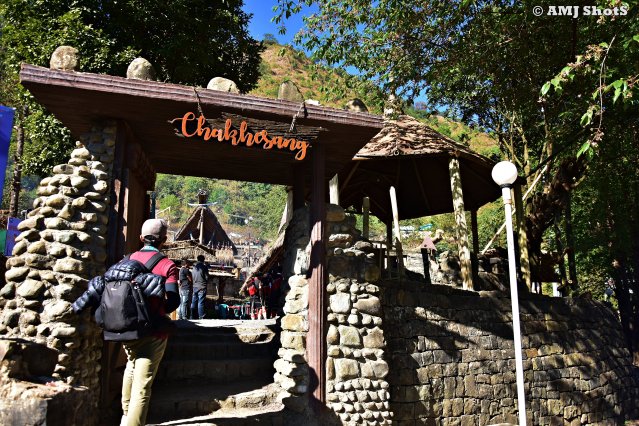
Entrance Gate of Chakhesang Morung
With diversity in its social composition, there are different dialects spoken among the Chakhesang people. Apart from English and Nagamese, naturally Chakhesang people could easily converse in other tribes’ dialects/languages. They use Angami’s Tenyidie Bible and Tenyidie Hymn Book as official language in the Church. It provides them easy means of communication with the Angamis. Many Chakhesangs are conversant with Poumai and Mao dialect too. Others are equally comfortable with the dialect of Sumis, Rengmas and Tangkhuls. With all these advantages, it is not a surprise that this tribe has rich traditional folklores, songs and other traditional practices. The other uniqueness of this tribe is its geographical location. It has its border with the land of Mao (Tobufii, Shajouba, Chowainu), Poumai (Tunggam, Tungjoy, Liyai, Katafiimai, Laii), Tangkhul (Jessami area), Sumi (Satakha-Poghoboto Area), Angami (Kedima-Chakabama area) and Pochury. Hence, it has easy access to many neighbouring tribes both in Manipur and Nagaland.

Chakhesang Morung
With all of the above privileges, Chakhesang people are progressing in all spheres of life: social, political and religious life. Being neighbours to many tribes and diverse in its social composition, and conversant in many dialects, they are readily accepted by others. This, apart from hard labour, is the reason why you find many Chakhesang leaders in the churches and in civil society. They are also contributing many good leaders to the state politics.

Chakhesangs are simple yet possess great sense of humour and love cracking jokes
Majority of Chakhesang people are hard working and economically self reliant. Chakhesang tribe might at the top when it comes to mixed marriages with other tribes. One can look to this tribe as the future model of Naga society.
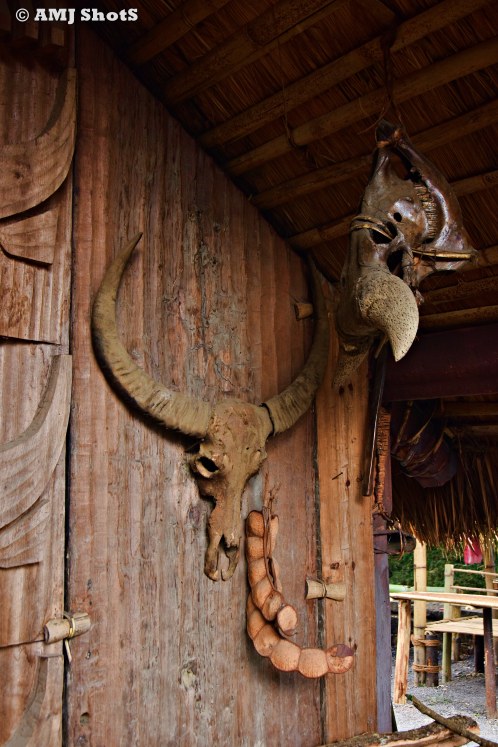
The skull of an Indian Bison (Wild Buffalo) – On the walls of Chakhesang morung

For a foodie, particularly if one happens to be a non- vegetarian, this is a real paradise – Look at those slices of Smoked pork hanging from the ceiling of a Chakhesang morung and filled bamboo cups with rice beer, arranged on the ground.
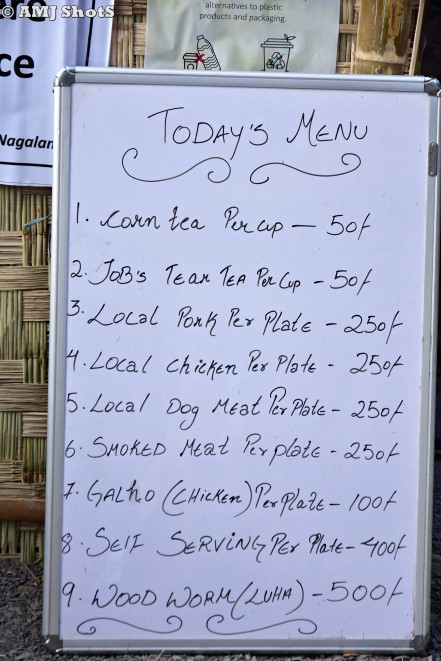
A traditional Chakhesang breakfast. You can try these in temporarily arranged restaurants near these morungs.
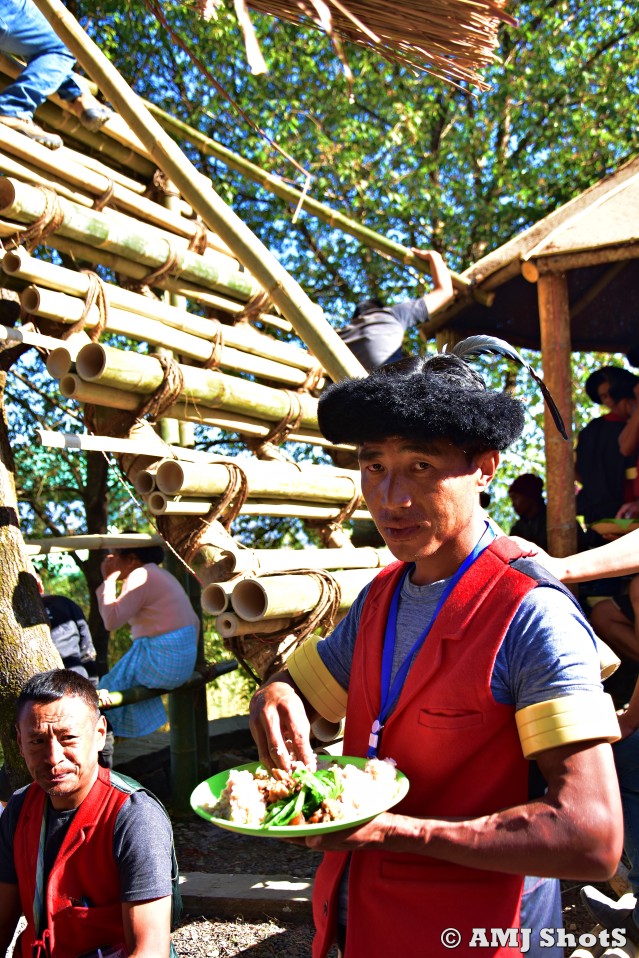
Traditional lunch of a Chakhesang consists of Rice, Sliced bamboo shoots, Smoked pork, Boiled vegetables, King Chilly chutney, Dry colocasia etc. with a cup of rice beer.
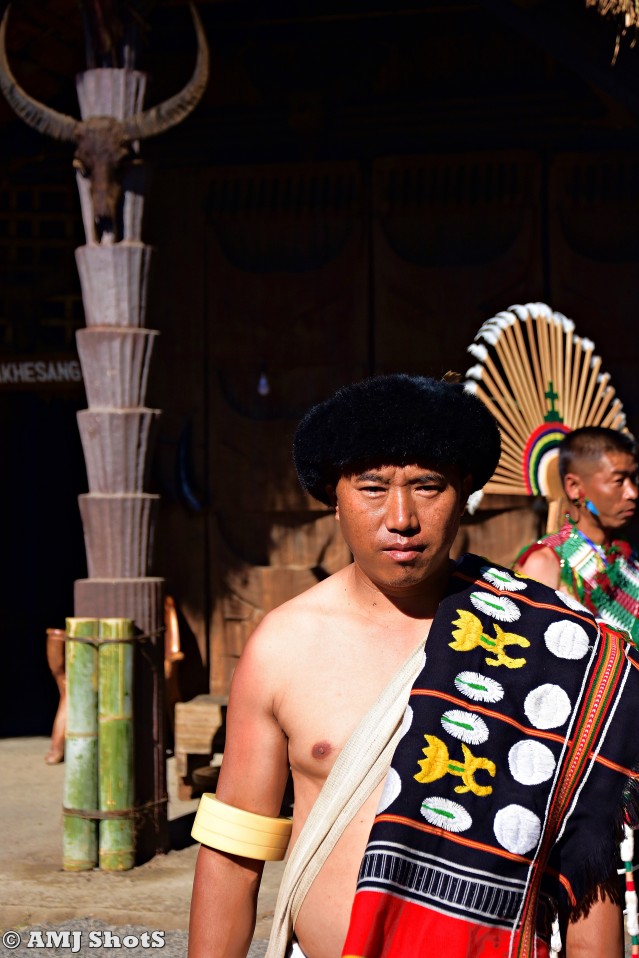
Another Chakhesang showing his traditional Shawl, which is made out of the stinging fabrics from Nettle leaves. The weavers have put so much effort in creating this beautiful vibrant shawl with the most gentle precision. According to the Chakhesang custom, this shawl is worn only by men of the high class or those who have done something honorable for the society like holding feasts for the entire village. The patterns are added in batches as the number of feats they hold increases. It is said that each batch of embroidering the motif should be completed within a single day before the sun sets.
In earlier days, Chakhesangs and Khiamniungans were the only two Naga tribes producing yarns made out of Nettle plants for making their clothes.

” Thbevo Do “ – Chakhesang Women showing their traditional art of Yarn production from Nettle leaves. The fibre, extracted from stinging nettle barks and transformed it into clothes like shawl and sarong (mekhala) during olden days, before they came into contact with the outside world.
Stinging nettle does not sting after being put under a series of treatment but it is a herculean task. It takes almost a year to weave a shawl (including the overall process).
Nettle plant is harvested and left to dry for 4-5 days so that the thorny stinging bark can be stripped from the stalk. The long nettle strips are then split into narrow slivers before boiling in water along with ashes to break down the fibre and make it flexible. The fibre is then pounded on a stone surface with wooden clubs until it is softened and easily separable. The fine nettle strands are then twisted and reeled into hanks. After this treatment, the thread is bleach-bathed in rice starch, dried in the sun and then rolled into a ball. The refined fibre is finally ready to be used for weaving beautiful clothes.
For Chakhesangs, a new year of activities begin with the arrival of spring; all activities related to sports and entertainment that begin after the harvest, cease along with the Tsukhenye festival. The festival lasts for four days in the first week of May – on the first morning, the village priests sacrifices the first rooster that crows. The men folk purify themselves by bathing in a designated well where no women are allowed. After bathing they invoke the almighty for strength, long life, good harvest etc. Another important festival of Chakhesangs is the Sukrenye festival, which happens on the 15th day of January and lasts for a period of 11 days. It is a festival of sanctification and is a form of baptism in the Chakhesang culture. Ceremonies and rituals performed at the time of the festival are religious in nature. The first few days are spend in the joyous preparations for the main events and feast. People pray to the Almighty to bless and purify their souls and hence the initiation of various rituals for the purpose is carried out. Runye Lu is such a folk song, sung during festival times of Chakhesangs…..
“Ronye Lu” is an emotional folk song describing the emotions and tragedies of a villager, who is facing many problems in his life. Folk dance can be an art, ritual or recreation. It goes beyond the functional purposes of the movements used in work or athletics in order to express emotions, moods or ideas; tell a story; serve religious, political, economic, or social needs; or simply be an experience that is pleasurable, exciting, or aesthetically valuable.
Folk dramas are integral part of the Chakhesang tribe. Ancient myths, love stories, heroisms etc can be the theme of these folk dramas. One such folk drama is Tekhezuso….
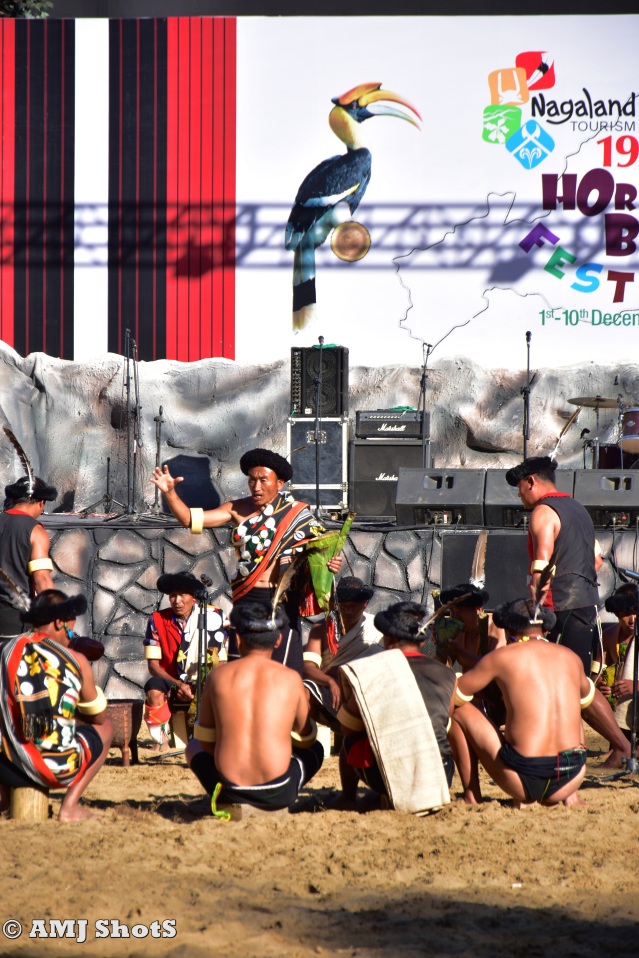
Chakhesangs performing a folk drama or enactment related with their lives in the villages – Tekhezuso
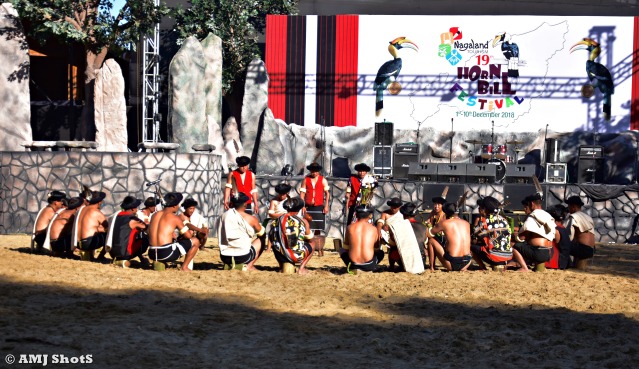
During this folk drama Tekhezuso, Chakhesangs gathered around the leader in circles and listen to him.
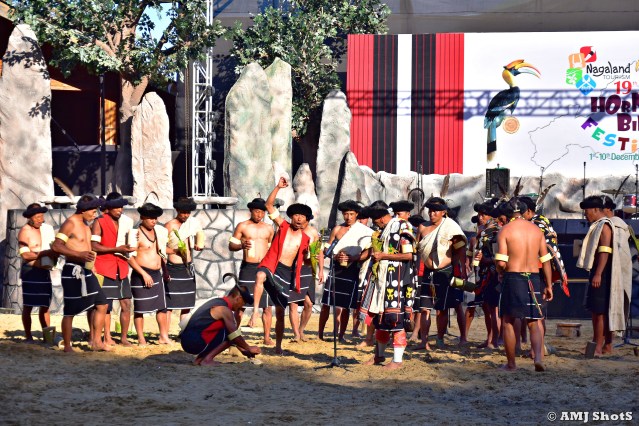
Tekhezuso – A folk drama by Chakhesangs. It is a traditional assembly held every year during the Run time festival which falls in the month of December.
4. Chang Tribe of Nagaland

‘ Chang Naga Warrior ‘
Chang Naga is one of the recognized Scheduled Tribe in Nagaland. The tribe was also known as Mazung in British India. Other Naga tribes know the Changs by different names including Changhai (Khiamniungan), Changru (Yimchunger), Duenching (upper Konyak), Machungrr (Ao), Mochumi (Sema) and Mojung (lower Konyak).
According to oral tradition, the Changs emerged from a place called Changsangmongko, and later settled at Changsang. The word Chang is said to have been derived the word Chognu (banyan tree), after a mythical banyan tree that grew at the now-abandoned Changsang. Another theory says that the Chang migrated to present-day Nagaland from the east, and therefore call themselves Chang (“Eastern” in the local dialect). Some Changs also claim the Aos as their ancestors.[5] The Chang folklore is similar to that of the Ao.

An old Chang warrior with fancy sea shell earrings and colourful beaded necklaces, getting ready for the cultural sessions in their morung.
The traditional territory of the Changs lies in the central Tuensang district. Their principal village was Mozungjami/Haku in Tuensang, from which the tribe expanded to the other villages.

Traditional Morung of Chang Naga – Back in the days, the tribesmen would carve a nearly-possible image of their deceased family members on the wooden frames of doors and windows, as a memory; the only way to remember them.
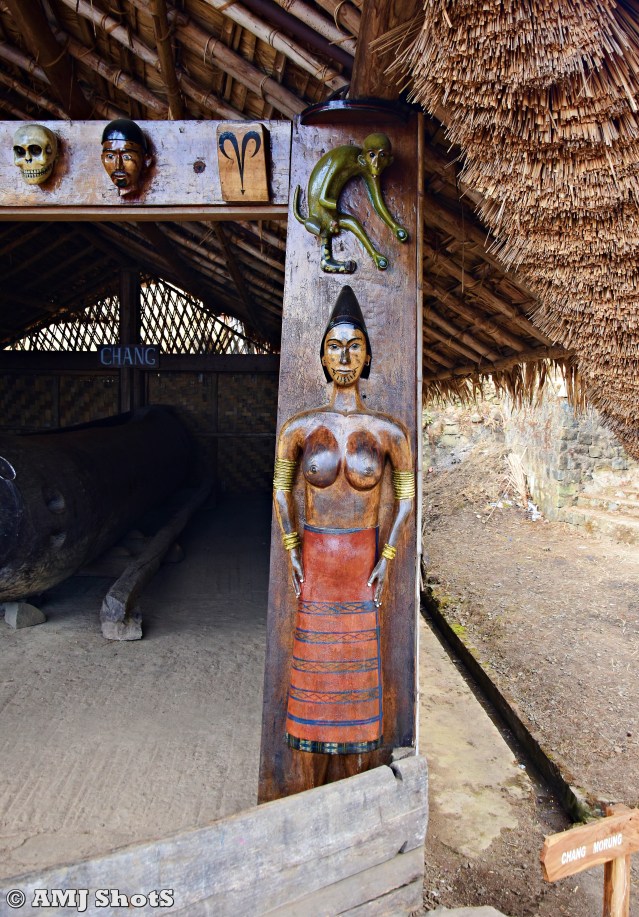
Wooden Sculpture of a Chang lady. And also, you can see the sculptures of human skull, severed head of an enemy, a green monkey.
The Chang, like several other Naga tribes, practiced headhunting in the pre-British era. The person with maximum number of hunted heads was given the position of lakbou (chief), who would settle the village disputes. He was entitled to maintain special decorative marks in his house, and to wear special ceremonial dress during the festivals. After the headhunting was abolished, the village disputes were resolved by a council of informally elected village leaders. Such councils also selected the fields for jhum cultivation, and fixed the festival dates. The Changs constructed a platformed called “Mullang Shon” in the center of the village, which would serve as a public court. Issues such as village administration, cultivation, festivals, marriages and land boundaries were discussed on this platform. The official interpreters (dobhashis) are recruited from important villages by the Deputy Commissioner of the district. These dobhashis help settle tribal cases, and fix the fine rates for some of the cases. The traditional village judges (youkubu) also help resolve the land disputes.
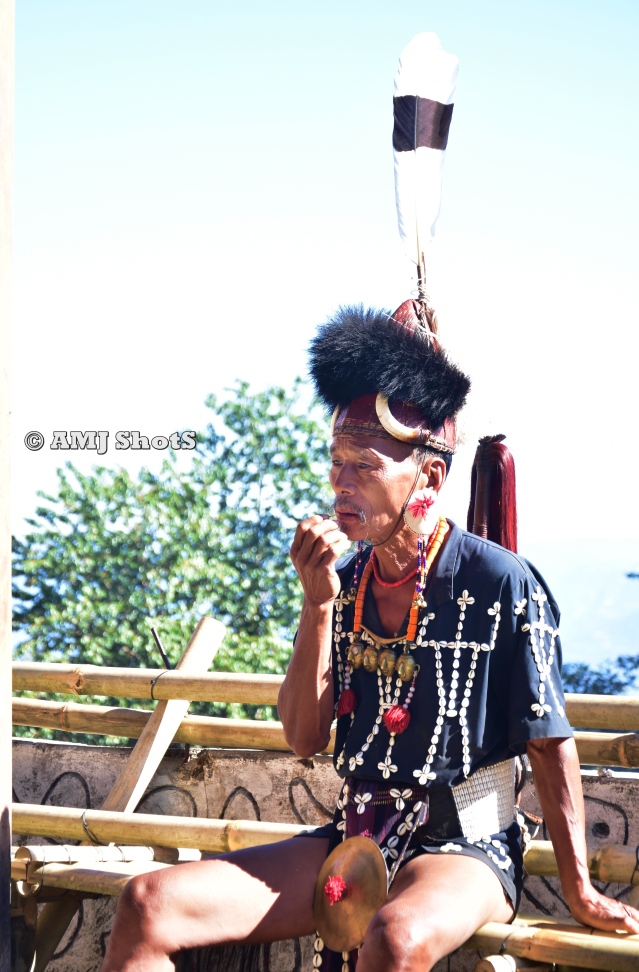
A Chang Naga in his traditional dress and ornaments; includes dark coloured cotton shirts stitched with small sea shells, long necklaces with broad beads and tribal head-shaped metal lockets. The head dress is a coronet made out from leathers and decorated with woolen fabrics and hornbill feathers.
After the advent of Christianity, several Changs have adopted modern clothing. The traditional Chang dress features distinctive shawl-like garments and ornamented headgear. Chang shawls “surpass all the Naga shawls in beauty and eye-catching patterns”. The shawl designs are different for different age groups and clans. Mohnei, a cowrie-ornamented shawl, could be worn only by a man who had taken more than 6 heads.
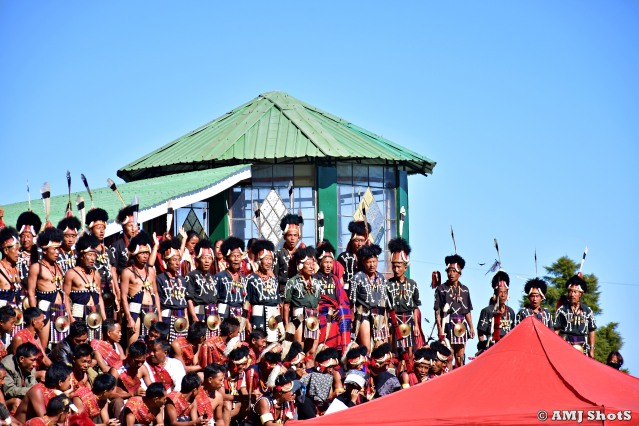
Chang Nagas proudy displaying their soulful War cry during the roll calling process in the main arena.
The Changs speak the Chang language, which belongs to the Tibeto-Burman family. Nagamese is used for communicating with the outsiders. The educated Changs also speak English and Hindi languages.

The men folk of Chang tribe playing log drum ‘Antimonyu or Sungkong’ , as a display for the tourists.
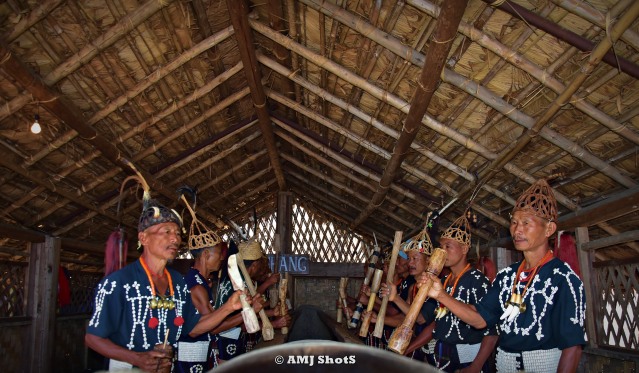
This log drum is very integral part of Naga life. This is created out of huge tree trunk sometime going upto 30 to 40 mts. in length and 5 to 6 feet height. The drum is flattened from the bottom to place it on the ground firmly and from the top through carvings a hollow is made and on hitting from top the sound emits. Some times those are highly decorated with human motif. It is not only restricted to create martial music but on all occasions from birth to death from festivals to the death news and from announcing time of the elders meetings to declare emergency when the rival group attacks are the function of this log drum.
As such there is no formal codification of these sound beats. But through oral tradition everybody understands as a peculiar sound emits on all different occasions. This is more on the communication mode than a simple ritual of Naga people. The traditional instruments also include xylophone, various drums (made by stretching animal hide), bamboo trumpets and bamboo flutes.[3] The traditional instruments have been replaced by guitar among the modern Changs.
Let’s see the moments of a traditional ritual followed by Chang Nagas in selection and pulling of log drum from the wild – ” Tongten Senbu “……
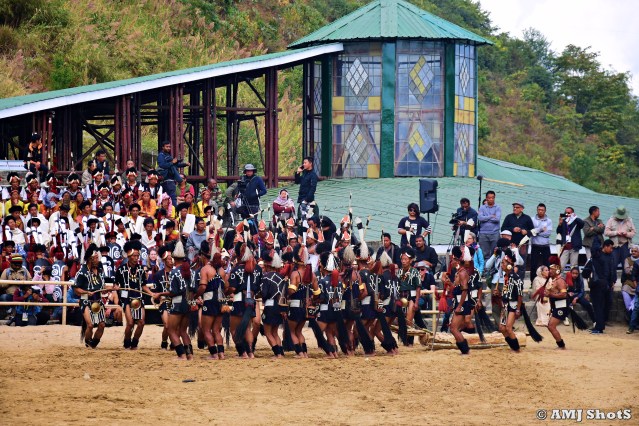
‘Tongten Senbu’ (Pulling of log drum) – This is a very elaborate process. First of all one of the Naga man has to volunteer to donate a tree from his own forest area. Then youth go to cut the tree and after performing a ritual they start the tree-falling process.
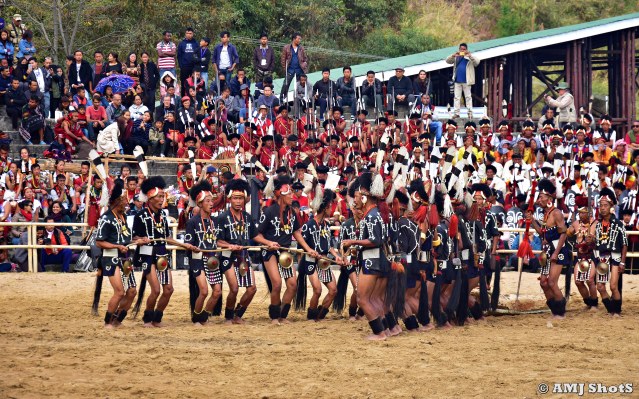
‘Tongten Senbu’ – Only tool they use is Dao. Then for seven days the process of bringing tree from forest to village starts. These are brought through indigenous process.
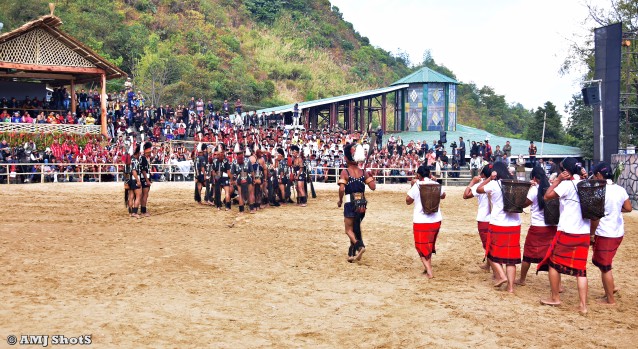
‘Tongten Senbu’ – In all these days women and girls bring foods and drinks for the youth who toe the log. Its almost a festival for them.
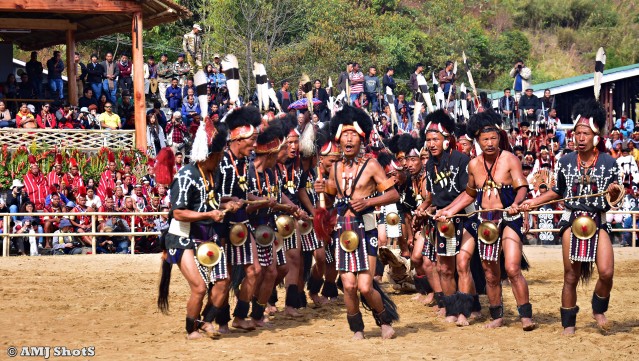
‘Tongten Senbu’ – Once the log is brought to the village expert woodcarvers create the drum and do the traditional art work on them.

‘Tongten Senbu’ – After a small ritual the drum is placed near the Morung or dormitary for regular use.

Chang Nagas leaving the main arena after performing ‘Tongten Senbu’ process.
The traditional Chang cuisine is non-vegetarian, and comprises a variety of meats and fish. Rice is the staple food of the tribe. let’s see their traditional way of fishing – ” Kaishi Lakshibu ” ….
“Kaishi Lakshibu” – During winter season, after the hardships of harvesting, the villagers engage in many celebrations. The major one is this Kaishi Lakshibu. The whole village decides to go for fishing in nearby river, using an indigenous technique called ‘Ejung Tsen’. For that, they uses a special type of local fruit from the wild – Kai. After fixing the date for fishing, the Chieftain sends boys to pick up Kai fruits from wild. Then, the villagers go to the river with bamboo pots and the men folk immerse these pots in water and fill them with wild Kai fruits. After that, they start grinding those fruits and pouring water into the mix. This process turns the river water in to reddish colour. Slowly, the fishes get dizzy and stays still above in water. This makes the catch easier. Women folk are responsible for catching these fishes. The folk songs sung by men folk during this occasion translates into ” We pay our enemies with fishes in the river. We are sending disaster to you. Oh, fishes… you have no way to escape because the enemies had surrounded you and you are feeling dizzy also. All fishes….. please, converge”

Tribal chief of Changs leaving the main arena after performing Kaishi Lakshibu – Traditional way of fishing among Chang Nagas.
Milk, fruits and vegetables were not a major part of the traditional Chang food habits, but have been adopted widely in the modern times. Rice beer used to be of high social and ritual importance, but has largely been abandoned after the conversion of Changs to Christianity.
Naknyu Lem is the major traditional festival among the six festivals of the Changs. According to the Chang mythology, the ancient people had to remain inside their homes for six days due to extreme darkness. Naknyu Lem is held to celebrate the light on the seventh day. On the first day, the domestic animals are slaughtered, the villages are cleaned, and firewood and water are stocked.
On the second day (Youjem, dark moon day), the tribals exchange gifts and food items, and play sports like, top-spinning, tug-of-war, high jump, long jump, climbing of oiled poles, and grabbing big lumps of cooked meat hung in rows along a bamboo rope strung at height. Women play a musical instrument called kongkhin. The paths and the houses are decorated with leaves, and a shrub called Ngounaam is planted in front of the house to ward off the evil spirits. At sunset, seeds called Vui long are buried inside the rice husks and burnt around the house. Fragments of the exploding seeds moving away from the house are considered a good omen. If the fragments bound back towards the house, it is a bad omen. People don’t go out of their homes at sunset, as it is believed that the spirit Shambuli Muhgha visits the village, and harms anyone outside the house. On the third day, the village and the approach roads are cleaned. Later, the paths leading to the fields and neighbouring villages are cleaned.
Most of the Naga folk songs are related to the harvesting and sowing seasons, in connection with their agri fields. ” Sekmou Chemmoubu Otuang Onet “ is one such rhythmatic song sung by the Changs to ease up their tiring workloads and pace up the cultivation process, while working in their agri lands…..
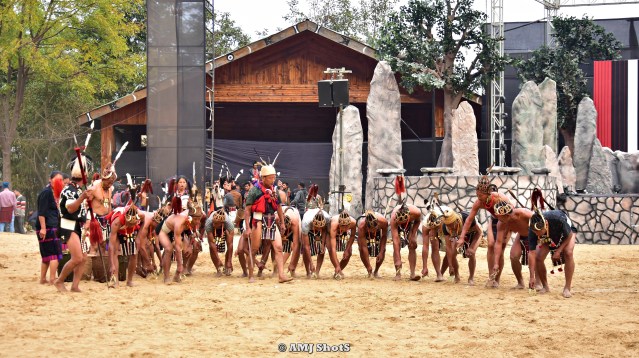
Chang Nagas singing Sekmou Onet, a cultivation folk song while enacting the tilling process in their agri lands.

The village Chief encourages men folk to pace up their working by performing the folk cultivation song – Sekmou Onet
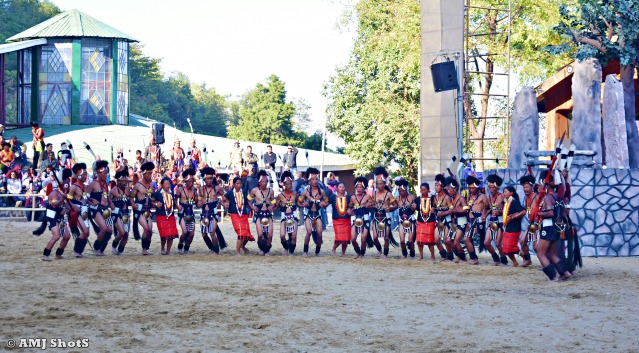
Men and women folks of Chang tribe performing a folk song with dance – ‘Sukem Chia’. This song is sung during celebratory occasions where the wealthy citizens of their village would offer Mithun for the festive season.
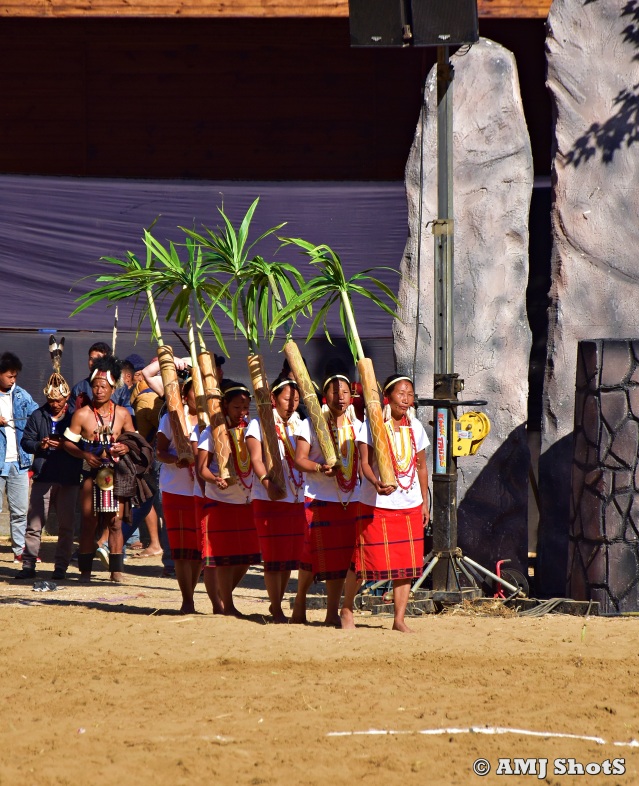
Women folks of Chang tribe dressed up in their traditional attire to perform a folk song – ‘Sao Chia’
The traditional Chang society is patrilineal, and the males inherit the land and the positions of authority. Nuclear families are predominant in the Chang society. The marriage is called chumkanbu, and remarriages are permitted.
5. Garo Tribe of Nagaland
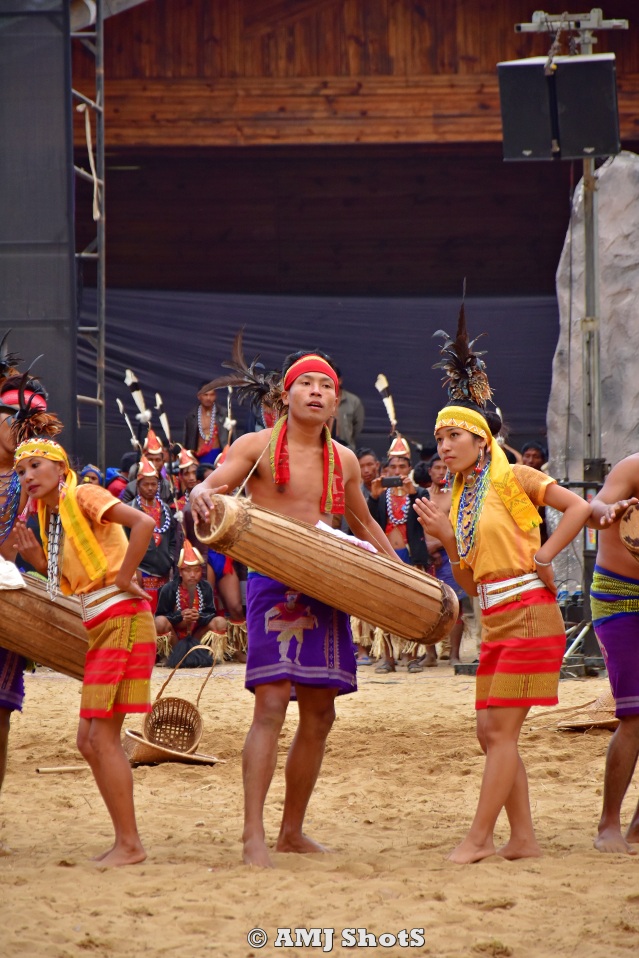
A moment from the ‘Quarrel Dance of Garo Tribe’
Garos are an indigenous Tibeto-Burman ethnic group from the Indian subcontinent, notably found in the Indian states of Meghalaya, Assam, Tripura, Nagaland, and neighboring areas of Bangladesh, who call themselves A·chik Mande (literally “hill people,” from a·chik “bite soil” + mande “people”) or simply A·chik or Mande. They are the second-largest tribe in Meghalaya after the Khasi and comprise about a third of the local population. The Garos are one of the few remaining matrilineal societies in the world.
The Garos are mainly distributed over the Garo Hills and Khasi Hills of Meghalaya, Ri-Bhoi Districts in Meghalaya, several districts such as Karbi Anglong districts of Assam and Dimapur district in Nagaland State. Their substantial numbers (about 200,000) are also found in few districts of Bangladesh which includes its capital Dhaka. It is estimated that total Garo population in India and Bangladesh together is about 1 million. Garos are also found scattered in the Indian state of Tripura. Garos form minorities in West Bengal, as well as in Nagaland. The present generation of Garos forming minorities in these states of India do not speak the ethnic language anymore.

A traditional Garo Morung – Garo Nokpante
Large part of the Garo community follow Christianity, with some rural pockets following traditional animist religion known as Songsarek and its practices. Their ancient animistic religious beliefs and practices consists with deities who must be appeased with rituals, ceremonies and animal sacrifices to ensure welfare of the tribe. Garo tribal religion is popularly known as Songsarek. Their tradition “Dakbewal” relates to their most prominent cultural activities.
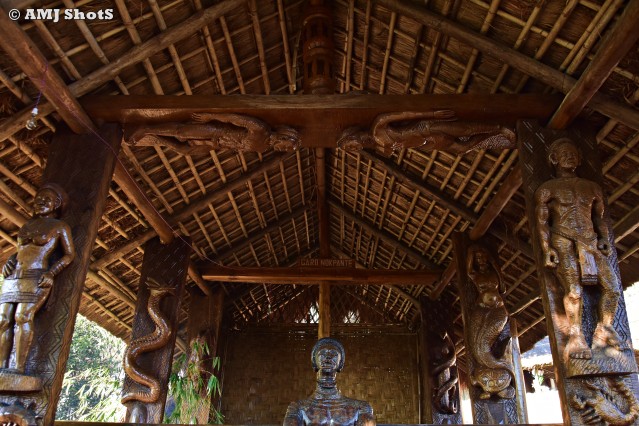
Garo Nokpante – In the Garo habitation, the house where unmarried male youth or bachelors live is called Nokpante. The word Nokpante means the house of bachelors. Nokpantes are generally constructed in the front courtyard of the Nokma, the chief. The art of cultivation, arts, and cultures, and games are taught in the Nokpante to the boys by the senior boys and elders.
Garo language belongs to the Tibeto-Burman language family. The language was not traditionally written down; customs, traditions, and beliefs were handed down orally. It is believed that the written language was lost in its transit to the present Garo Hills. Garo language/script was written on the skins of cows; while on the way their ancestors faced famines so they cooked them. The written language/script was lost. The Garo language has dialects – In Bangladesh, A·beng is the usual dialect written in Bengali script, but A·chik is used more in India. A·we has become the standard dialect of the Garos written in Roman script. A·we is used in Garo literature and, hence, for the translation of the Bible. The Garo language has some similarities with Boro-Kachari, Dimasa, and Kok-Borok languages. The modern official language in schools and government offices is English.

Inside Garo Nokpante – Wooden sculpture of a Two-headed man (facing opposite to each other)
According to one oral tradition, the Garos first immigrated to Garo Hills from Tibet (referred to as Tibotgre) around 400 BC under the leadership of Jappa Jalimpa, crossing the Brahmaputra River and tentatively settling in the river valley. The Garos finally settled down in Garo Hills (East-West Garo Hills), finding providence and security in this uncharted territory and claiming it their own.
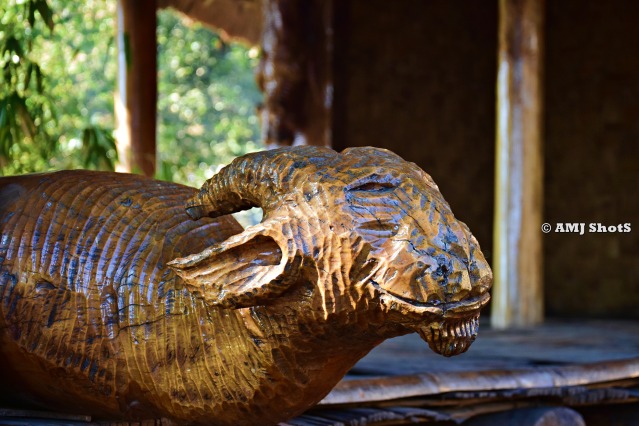
Inside Garo Nokpante – At the end of one of the wooden frames, the shape of a mountain goat’s head is carved out.
The earliest written records about the Garo dates from around 1800. They were looked upon as bloodthirsty savages, who inhabited a tract of hills covered with almost impenetrable jungle, the climate of which was considered so deadly as to make it impossible for a white man to live there. The Garo had the reputation of being fierce headhunters, the social status of a man being decided by the number of heads he owned. In December 1872, the British sent battalions to Garo Hills to establish their control in the region. The attack was conducted from three sides – south, east, and west. The Garo warriors (Matgriks) confronted them with their spears, swords, and shields. The battle that ensued was heavily unmatched, as the Garos did not have guns or mortars like the British Army.
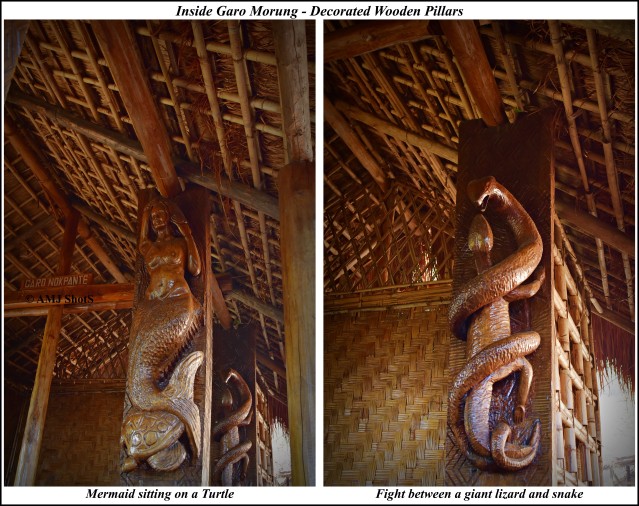
Garos are one of the few remaining matrilineal societies in the world. The individuals take their clan titles from their mothers. Traditionally, the youngest daughter (nokmechik) inherits the property from her mother. Sons leave the parents’ house at puberty and are trained in the village bachelor dormitory (nokpante). After getting married, the man lives in his wife’s house. Garos are only a matrilinear society but not matriarchal. While the property is owned by women, the men govern the society and domestic affairs and manage the property.
Their staple cereal food is rice. They also eat millet, maize, tapioca etc and rear cows, goats, pigs, fowls, ducks etc. and relish their meat. They eat other wild animal like deer, bison, wild pigs etc. Fish, prawns, crabs, eels and dry fish are a part of their food. Their jhum fields and the forests provide them with vegetables and roots for their curry. Bamboo shoots are esteemed as a delicacy. They use a kind of potash in curries, which they obtained by burning dry pieces of plantain stems or young bamboo locally known as kalchi or katchi. After they are burnt, the ashes are collected and dipped in water; they are strained in conical shapes in a bamboo strainer. Besides other drinks, country liquor plays an important role in the life of the Garos.
Garo festivals are based on the agricultural cycle of crops. The harvesting festival Wangala, also known as the 100-Drum festival, is the biggest celebration of the tribe happening in the month of October or November every year. It is the thanksgiving after harvest in the honor of the god Saljong, provider of nature’s bounties. Beautiful Garo girls known as nomil and handsome boys pante take part in ‘Wangala’ festivals. The pantes beat a kind of long drum called dama in groups and play bamboo flute. The nomils with colorful costumes dance to the tune of dama and folk songs in a circle. Most of the folk songs depict ordinary Garo life, God’s blessings, beauty of nature, day-to-day struggles, romance, and human aspirations.
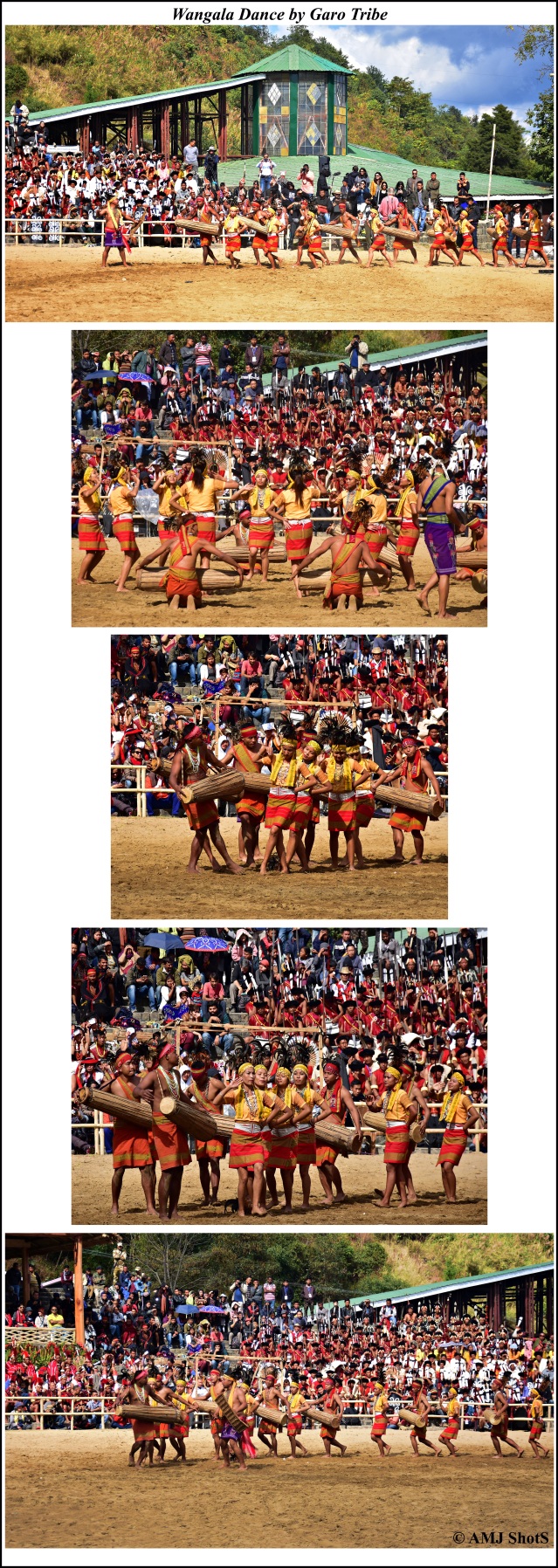
” Wangala Dance ” of Garos – Also known as The Hundred Drums Festival or Wanma Rongchua. In this post harvest festival, they give thanks to Misi Saljong (also known as Pattigipa Ra’rongipa), the sun god, for blessing the people with a rich harvest. Chambil Mesaa or the Pomelo Dance are performed during Wangala festival. Dama Gogata, the dance with drums, flutes and assorted brass instruments by men and women in colourful dresses and proud headgear – a picture which is synonymous with visuals of Wangala – is performed on the last day of the days-long celebration
Rugala (Pouring of rice beer) and Cha·chat So·a (Incense burning) are the rituals performed on the first day by the priest, who is known as ‘Kamal’. These rituals are performed inside the house of the Nokma (chieftain i.e. the husband of the woman who holds power over an a’king) of the village. Wangala is traditionally celebrated for two to three days – or up to a week – by two or three collaborating villages; though recently it has been celebrated for one day in metropolitan areas as an attempt to conserve the ancient heritage of the Garo tribe and to expose the younger generation to their roots.
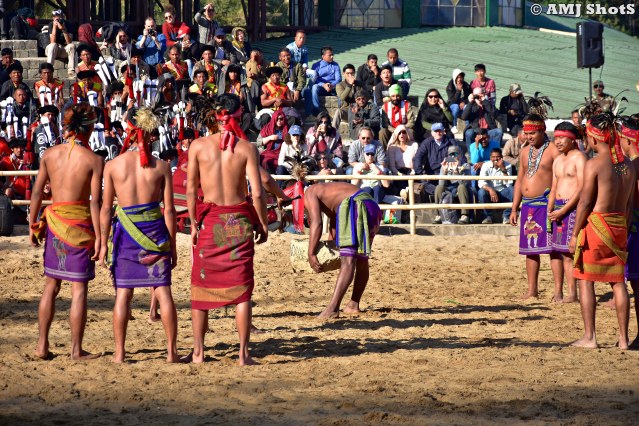
‘Ro’ong Dea’ – An indigenous stone lifting game of Garos

Ro’ong Dea – This loosely resembles the modern weight lifting. A smooth round stone weighing about 100 kg or more is placed among the spectators. Anybody from among the spectators can come forward and give a try in lifting the stone. The participants try to lift it as high as possible. Needless to say that the player, the participant that lifts it highest, is the winner and is deemed to be the strongest man in the village.

A Garo Naga challenging the members of other tribes and audiences to participate in Ro’ong Dea challenge.

Praising the Winner – A Zeliang Naga successfully completes the Ro’ong Dea challenge.
Garo Ornaments includes Nadongbi or sisa (made of a brass ring worn in the lobe of the ear), Nadirong (brass ring worn in the upper part of the ear), Natapsi (string of beads worn in the upper part of the ear), Jaksan (bangles of different materials and sizes), Ripok (necklaces made of long barrel-shaped beads of cornelian or red glass while some are made out of brass or silver and are worn in special occasions), Jaksil (elbow ring worn by rich men on Gana ceremonies), Penta (small piece of ivory struck into the upper part of the ear projecting upwards parallel to the side of the head), Seng·ki (waistband consisting of several rows of conch-shells worn by women) and Pilne (head ornament worn during dances only by women).

“Quarrel Dance” of Garo tribe – This dance reflects the quarrel between the clans of Garos; Sangma (Intelligence) and Marak (Power). Two persons holding a millam (sword) and sepi (shield) try to overpower each other. After the feud, the women folk performs a folk dance and making of peace follows.
One another indigenous game performed by Garos was ‘Jaktongsika’ – A test of strength between two men of Garo tribe…..
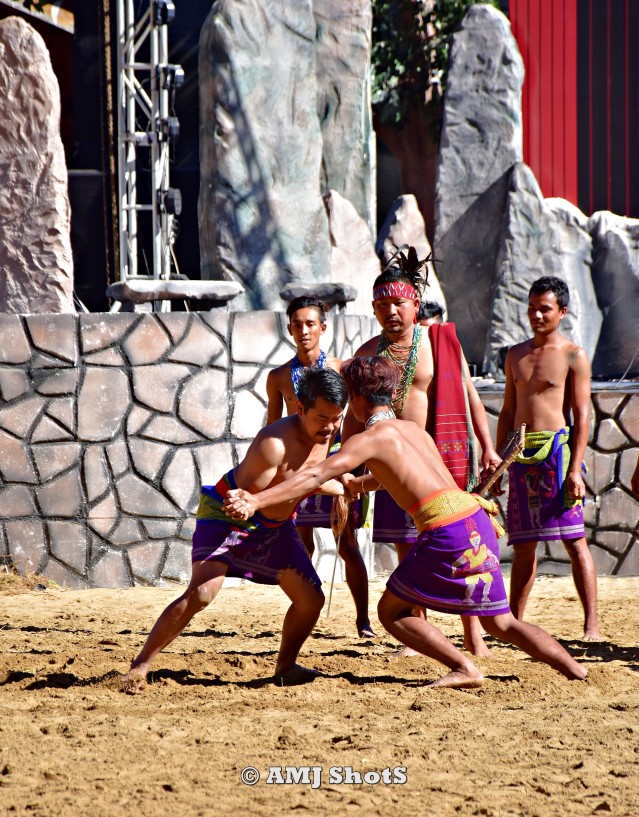
Jaktongsika – An indigenous game showing the test of strength between two Garo men. The game is played inside a circle, guided by tribal referee. The participants are allowed to use their hands only. They need to push the opponent out of the marked circle.
Garos have their own weapons. One of the principal weapons is a two-edged sword called mil·am made of one piece of iron from hilt to point. There is a cross-bar between the hilt and the blade where a bunch of ox’s tail-hair is attached. The other types of weapons are shield, spear, bow and arrow, axe, dagger, etc.
Garo musical instruments can broadly be classified into four groups. Idiophones (Self-sounding and made of resonant materials) like Kakwa, Nanggilsi, Guridomik etc. Aerophone (Wind instruments, whose sound come from air vibrating inside a pipe when is blown ) like Adil, Singga, Sanai, Kal, Bolbijak etc. Chordophone (Stringed instrument) Dotrong, Sarenda, Chigring or Bagring etc. Membranophone (With skins or membranes stretched over a frame) Am·being Dama, Chisak Dama, Atong Dama etc.
6. Kachari Tribe of Nagaland

Kachari Women performing their folk dance – “Bai Dima”
Kachari or Cachari is a generic term applied to a number of ethnic groups, predominantly in Assam, speaking Tibeto-Burman languages or claiming a common ancestry. They are the most widespread tribe of Northeast India. The Kachari denotes tribes like Bodo, Dimasa, Chutiya, Sonowal, Hajong, Lalung (Tiwa), Rabha, Garos and Tripuri (Debbarmans, Reangs, Jamatia) which have their common origin. They are considered to have reached the Brahmaputra valley via Tibet and settled in the foothills of the eastern Himalayan range which includes the whole of Assam, Tripura, North Bengal, Meghalaya, some in Bhutan and Nepal, Arunachal Pradesh, historic Dimapur of Nagaland, and parts of Bangladesh. They may also found in Jiribam District of Manipur and Hills of Mizoram, there known as Bru (Reang), a sub-tribe of Tiprasa (Tripuri). In Kalika puran (script during 11 century), Kachari had been mentioned as ‘Bhumiputra’ (Indigenous inhabitant) of ‘Pragajyotishpur‘ (Assam in present days). The Kachari Kings believed that they were descendants of Ghatothkach, the son of second Pandava prince Bhima and Hidimba.
The Kacharis that we seen in Nagaland are Dimasa Kacharis, especially in Dimapur district. Dimasa mythology says that they are the children of Bangla Raja (Earthquake God) and the great divine bird Arikhidima. Bangla Raja’s six sons— Sibrai, Doo Raja, Naikhu Raja, Waa Raja, Guyung Brai Yung, and Hamyadao and Arikhidima are their ancestors, and in Dimasa belief, are ancestral Gods. They are called Madai in Dimasa. Evil spirits born of the seventh egg of Arikhidima are responsible for a disease, suffering, and natural calamities.
Ancient Dimasa tradition maintains that sixty thousand ( 60,000 ) Moon months (Lunar months) ago, they left their ancestral land when it suffered a severe drought. After long wandering, they settled at Di-laobra Sangibra, the confluence of the Brahmaputra and Sangi or Di-tsang. There they held a great assembly. The place is in the present West Bengal area where the River Ganga and the Brahmaputra join, and where the Kacharis established their first seat. Over time, their kingdom spread over large territories.

Traditional Kachari Morung – Kachari Nohdrang. Nohdrang named in Dimasa called club is placed in the middle or centre of their village or punji. In Dimasa, the village system is called Nohlai meaning a cluster of houses and the whole village with its population is called Raji. Dimasa tend to live on river banks and next to streams. Therefore, Dimasa Kachari villages are on hills, with thirty to fifty, though sometimes (rarely) as many as four hundred houses. The houses are built in two facing rows. The houses, with a timber superstructure, mud-plastered bamboo walls, and thatched roof are called Noh-Dima. Each families in a village has a few fruit trees – like Guava, mango, Jack fruit, plaintain and others. Dimasa houses use a floor plan called Noh-Dima that partitions the structure into a drawing room, sleeping room, kitchen room, and granary. A place for pounding rice is called Thengkhikho in Dimasa. Santho-rimin is another kind of pounding rice tool. Dimasa use a household article like to keep water used the bamboo and for cooking use silver utensil,spoon made of wood and Dish made of wood and banana leaf and other, a house for latrin, bath room and others also.
The name ‘Dimasa’ may mean either of two definitions. Firstly, Dimasa may stand for “Dimba-sa” meaning “children of Hi-dimba”. Secondly, it may also stand for “Dima-sa” meaning “children of the big river” referring to Brahmaputra river (known as Dilao in Dimasa), where “Dima” means river and “Sa” means children. Kacharis appear to be one of the earliest indigenous ethnic groups of northeastern India. Most independent tribal communities in this region are of Kachari origin. ‘Dimapur’ was derived from Dimasa Kachari words Di-meaning “water,” Ma-meaning big and Pur-meaning “city” or “township” in Dimasa-Kachari dialogue.
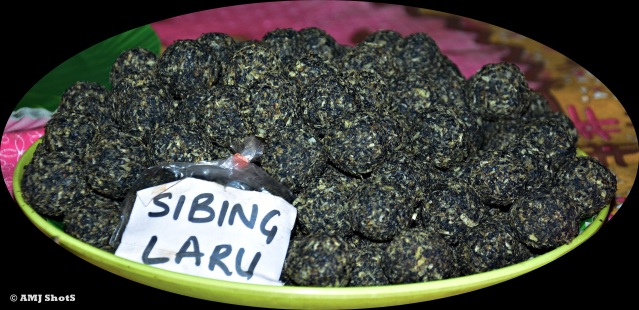
Sibing Laru – Sesame balls of Dimasa Kachars. A traditional food item made from Sesame seeds.
Facing Ahom aggression, they further migrated southwards, on to the Dhansiri valley and established their capital at Dimapur presently in the state of Nagaland after a short stint at Kachomari pathar about forty kilometers from Dimapur. It was here that the Dimasa Kachari undertook an arduous task of state building and flourished for several hundred years till 1536 when they shifted their capital to Maibang at the present day district of Dima Hasao District (Old name “North Cachar Hills”) of Assam. Historical relics of Dimasa Kachari royaldom still exist in and around Dimapur, particularly in the Dimapur fort called Kachari Rajbari, which in spite of the constant ravages of human encroachment, show that the Kachari at that period had attained a state of the result of bricks making. Among the large tanks Podum Pukhuri, Bangle Pukhuri, Bamun Pukhuri, Raj Pukhuri, Jor Pukhuri and others still survive to this day. It is said in one folklore that during the fight with Ahom, The Dimasa Kachari King had dumped gold and other precious metals in some of these tanks and believed to have told his subject that long after he left, a day would come when a male Mithun would come from the hills and dig up this gold by its horn, which would weigh mound (about 240 kg) and that would be the time when Dimasa Kachari rise again and prosper. From Dimapur, the royal family of Kachari in their last leg of migration moved to Khaspur of Kachar district of Assam. The Dimasa Kachari Kingdom was finally annexed by the British East India company along with Assam following the Yandabu Treaty.
Coming back to the festival scenes, Kachari people demonstrated an indigenous game called the “Reemin Nehlaiba” ……

Reemin Nehlaiba – This indigenous game is played by the Dimasas during social gatherings, and weddings. The term ‘Reemin’ refers to the pole used for pounding and ‘Nehlaiba’ means to push and knock each other.

Winning moment in Reemin Nehlaiba…. The player who pushes the opponents out from the demarcated circle or gets his opponent down is declared the winner.
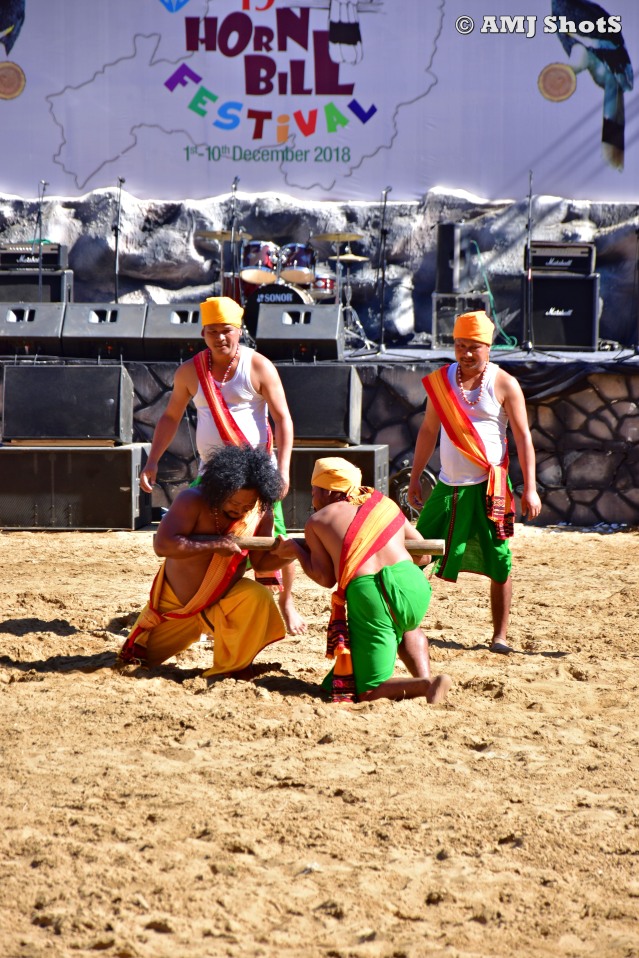
Reemin Nehlaiba – Another chance given. This time, can he make it???
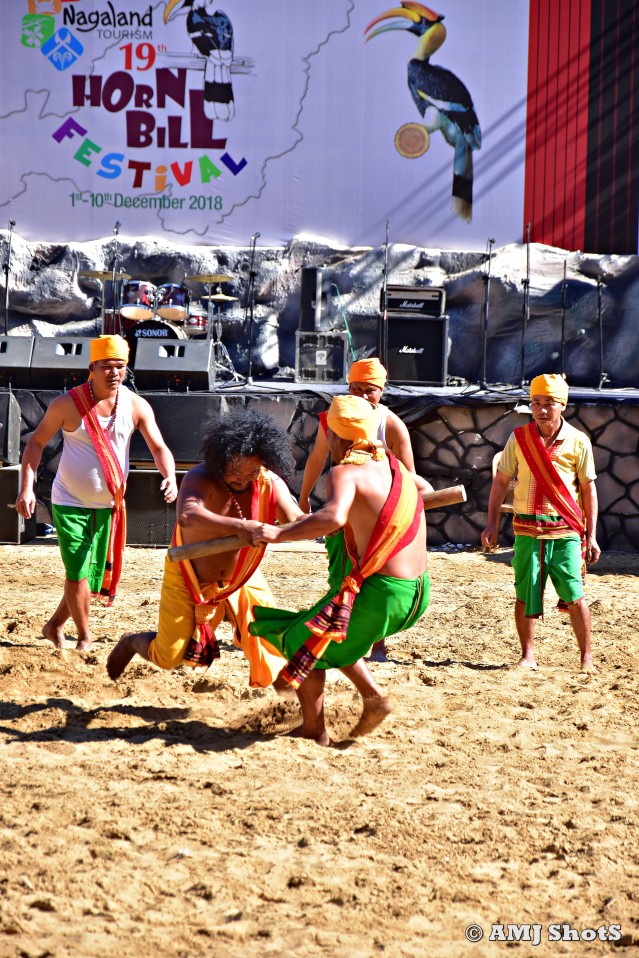
Its payback time in Reemin Nehlaiba…. Wow! That’s a come back….
Many Dimasa consider themselves to be Hindus although they have their traditional gods and goddesses. Among the six ancestral gods, Sibrai being the eldest, is the most important and during worship his name is to be uttered first. Sibrai is equated with Hindu Siva and Ranachandi with Parbati or Kali. In a Dimasa society, it is believed spiritual life, Spirit is a soul. Dimasa believe traditionally the rebirth of soul after death.
The whole Dimasa kingdom in bygone days was divided into twelve religious areas called Daikho. There are twelve priests for twelve Daikhos. The priest of a Daikho is called Zonthai. He have supreme authority in matters of deities and religion. Dain-yah is the one who sacrifice animal. Hojai performs the rituals over the twelve Zonthais of twelve Daikhos, there is a principal priest or chief priest called Gisiya. The selected person will get the Zonthaiship only when Gisiya offers him holy water called Dithar (Di-gathar). The Dimasa concept of heaven and hell is also very faint. according to their belief Firinghi is heaven, Damra is the land for the dead where the dead persons retain their original form. Manner is a human virtue inherent in man’s character, also and passed from father to son and mother to daughter.
Agricultural is the principal occupation and main source of livelihood of the Diamsa Kacharis. Dimasa were compelled to adopt shifting cultivation, commonly known as jhum, in hilly areas. Tracts of plains land suitable for permanent cultivation lying here and there between the ridges are very few. The Dimasa mainly cultivate maize, sesame, cotton and others. Many Dimasa families cultivate pineapples, oranges, cotton and mustars to a limited extent. In the jhum site itself a house to store the harvested paddy is erected and this house is called Mandu. They developed many folk songs and and dances, to ease up their work loads during cultivation in agri fields. One such folk song with dance is “Kharamjang Bai – Hadubani” …..
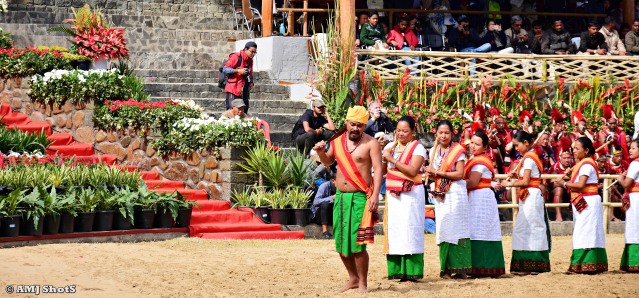
Kharamjang Bai – Hadubani – This is a folk song with dance performance related with the Hoeing and Tilling of Kachari lands.

Kharamjang Bai – Hadubani of Dimasa Kacharis- It literally means ‘cultivating with drum beats’. Depicting hoeing and tilling of jhum fields by villagers for cultivation of paddy and other crops.
Bushu is an important festival celebrated by Dimasa with the celebration of great pomp and splenduor among the Dimasa. Bushu is celebrated after completion of harvest. Bushu, the word gives the meaning such as Brai-Sibrai is a supreme God in Dimasa society. So, in this way, the entire harvesting new paddy is offered first to the Brai sibrai madai for peace of the human kind is called Bushu. Phangsla, an artistically designed gate, is erected at the village entrance for the Bishu festival. Bushu festival consists of three kinds, namely Surem Bushu observe for three or five days, Hangseu manaoba Bushu is observed for seven days and Jidab Bushu is for only one day. Gajaibao is selected as a head of the festival. He is in charge of the festival. Meats of animals and birds killed are consumed in a communal feast on the very day. Bushu is followed by singing accompanied by the rhythm of Kharams (drums), Muri, the wooden buggle continues first to third days without stop. Man and woman, Boys and Girls and others with their traditional dress spends whole night by dancing in the festival.
Dance forms of the Dimasa Kachari are complex in character. They are strictly dependent on instrumental music. No songs are used. Kharam (drum) follows the rhythm of the Muri (fife) and so also the dancers. Though one may find the music from Muri to be monotonous, there are variations with noticeable microtones for different dance forms. That is why young men practice dancing at Nodrang during leisure hours and the village children follow the rhythm and stepping at a distance from an early age.
One such dance form is “Bai – Maijai (Dance of Rice – Sieve or Plate)”….

Bai – Maijai (Dance with Rice – Sieve or Plate) – Bai means Dance. It means a cultural performance with Stone Siever once a time during Dimapur reign, so called Baimaijai. Now-a-days its unable to perform with Stone Siever. So Cultural performer conducts with Plate or Dish during Festival time.
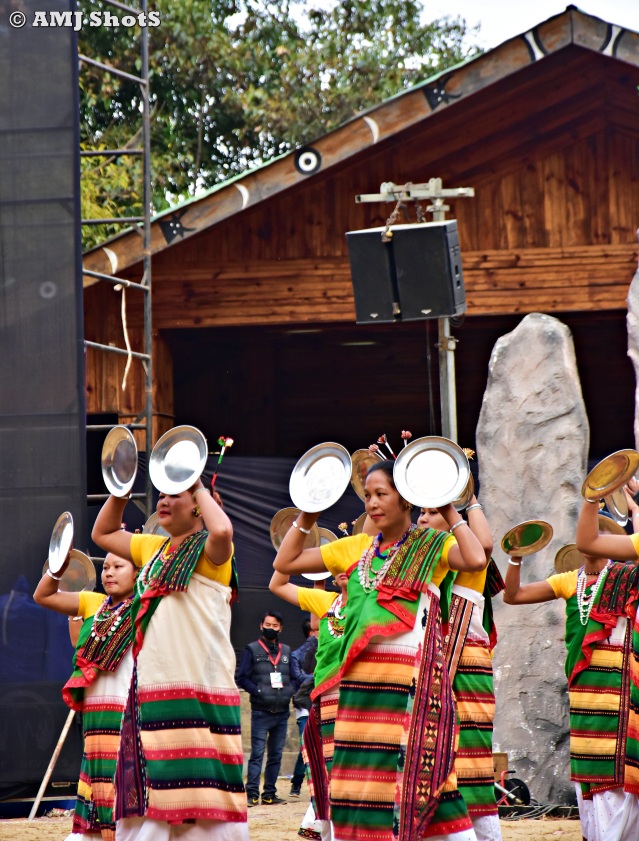
Bai – Maijai dancers balancing the rice plates on their hands. This dance is performed in olden times upon receiving news of victory, the women folks of the village goes half way to receive the victorious warriors. With rock sieves in their hands portraying the invincibility of their home coming heros, the women folk dance jubilantly in celebration of the momentous event.
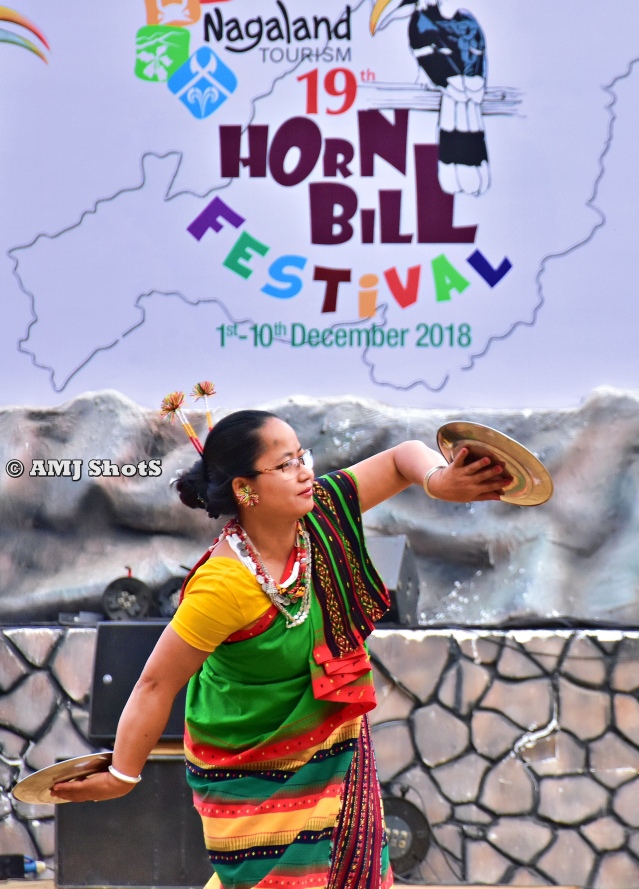
A Bai – Maijai dancer displaying the art of balancing. So graceful…
Another such dance is the “Baikhon or Nai Jubu” – A serpentine dance of Kachari tribe….

Bai Khon or Bai Jubu – A serpentine dance form of Dimasa kacharis. It imitates the crawling of a Python. This is mainly performed during festive occasions such as Bushu, marriage ceremonies and any other happy merry making sessions.
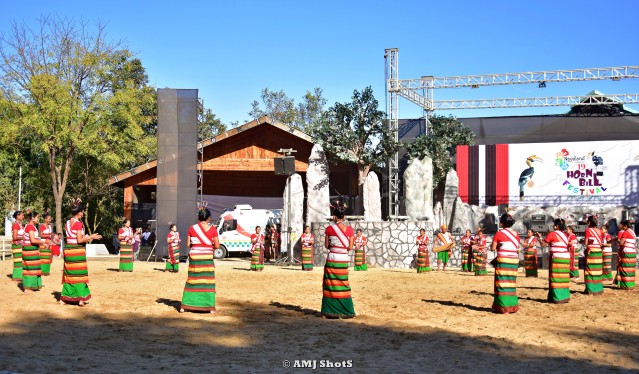
Women folk of Dimasa Kachari performing the signature dance form of their community – Bai Dima ; Bai means Dance and Dima means Dimasa. Dresses used are Rijamphain ( white cloth with worn from chest to knees), Rijamphain beren (ramai) – chest wrapper with stripes of bright colours like white, green (sometimes deep blue), black, yellow (sometimes orange) and red; worn only on special occasions (marriage, dance, festivals) and Rigu (wrapper or lower garment of various colours, worn from waist to ankle).
The Dimasa have a patriarchal society. But in spite of that they have three types of property namely paternal property, maternal property and common property. The paternal property consists of real estates, weapons, cash money and the cattle. The maternal or mothers property consists of jewellery, clothes and looms with their accessories used by the mother. The common property consists of the cooking utensil, brass-metal dishes and bowls and other household equipment. According to the customary law of inheritance of the Dimasa, while the paternal property is inherited by the sons, the maternal property is inherited by the daughters and common property is shared by the sons and daughters equally.
7 . Khiamniungan Nagas

Khiamniungan Nagas playing their traditional Log Drum
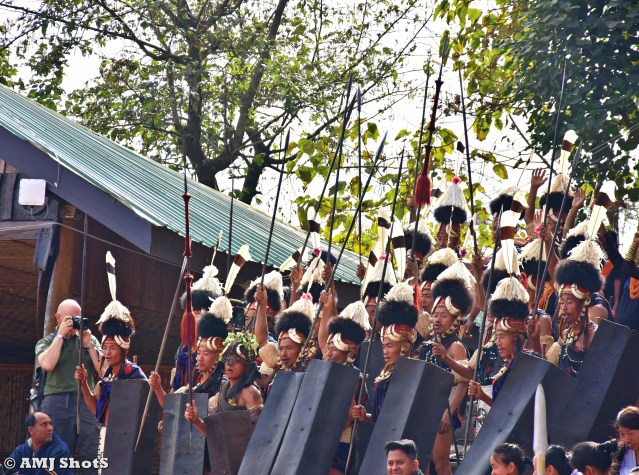
A War cry scene of Khiamniungan Tribe during Roll calling session in the Main arena.
The Khiamniungan tribe or the water people is one of the major tribe among the Nagas, with habitation both in India (Noklak district of Nagaland) and Myanmar. Geographically, the land of Khiamniungans is located in the Eastern part of Nagaland and in the North-Western part of Myanmar. The nomenclature of the tribe ‘ Khiamniungan’ is a compound word formed by three words; ‘Khiam’ means water, ‘Niu’ means great and ‘Ngan’ means source. Thus, the meaning of the term Khiamniungan is ‘source of great water or river’. The nomenclature derives from the biggest river of the land (laang) and to the river to which it ultimately confluence (Chindwin). The main river formed from the watershed of Khiamniungan area is ‘Laang’ known as ‘Zungki’ in the downstream that ultimately flows into the Chindwin river in Myanmar. They were also called Kalyo-Kenyu (“slate-house dwellers”) during the British Raj days.

Khiamniungan Nagas relaxing in front of their morung during lunch time.
Like that of other Naga tribes, the origin of the Khiamniungans (before the British Raj days) is totally uncertain, and the only source of information about their ancestors & oral traditions is in form of folktales and myths. The people of Khiamniungan trace back their origin to a place called ‘Khiamngan’. Legend says that there was a great flood. There upon people began to go up into higher elevation. As the flood subsides they descend downhill and started the first settlement of the new era at ‘Khiamngan’. The Khiamniungans after living for three consecutive generations in Khiamngan gradually moved to different directions to form several hamlets/villages. One group migrated to a place known as Lumoking and further to formed Pathso and Peshu ranges. Likewise another group migrated to Nokhu thangsoun and gradually wemt northward to form the present Thang and Wolam ranges. Whereas, one group who got settled at a place known as Shiadkhan and finally to form Nokhu range. Later on with the increase of population, migration to the further East started and eventually extended up to the Northern bank of Chuhoongan (Chindwin) river and beyond in Myanmar.
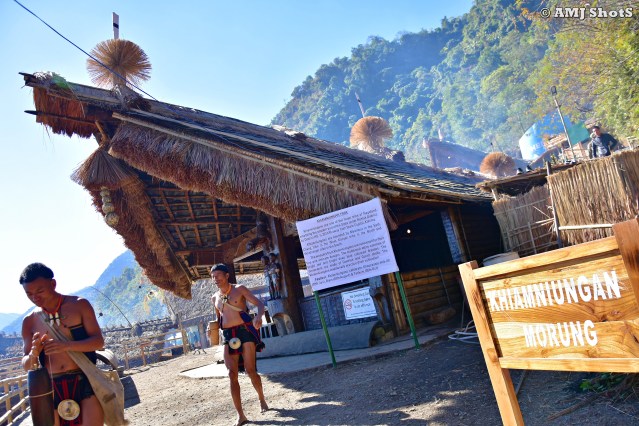
Khiamniungans in front of their traditional Morung. Morung architecture is as diverse as the house architecture of Nagas. Morungs are known for the woodcarvings, size or any other special decoration such as front rafters from which fronds of grass or can are hung.
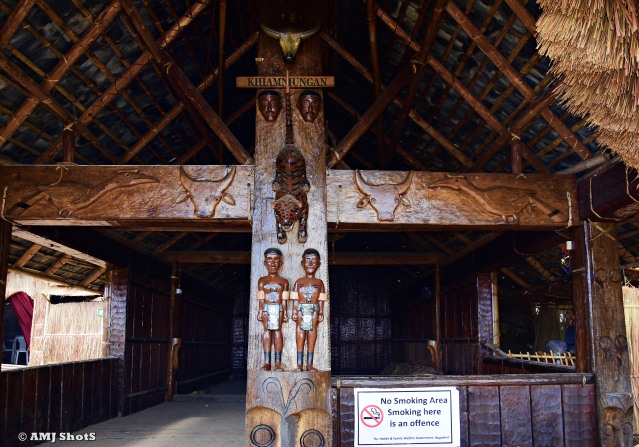
Khiamniungan Morung – These grand buildings were once, positioned at the village entrance and fiercely guarded. Apart from family, living in a morung was the most important means of education. At puberty, young boys and girls were admitted to dormitories separated by gender. Elders conveyed the Naga customs and traditions to the youth through folk music and dance, folk tales and oral tradition, woodcarving and weaving. Announcements of meetings, the death of a villager, or warnings of impending dangers were made from the morungs by the beating of immense handmade log drums. Forced acculturation by Westerners destroyed Naga architecture in order to suppress the transmission of its practices and traditions to younger generations.
The traditional Khiamniungan village had eight important people:
1. Nokpao or Nyokpao (war leader)
2. Puthsee or petchi (peace maker, elder)
3. Ampao, Meyo, meya (priest)
4. Kieo lomei (doctor)
5. Ain (priestess and oracle)
6. Shoalang or sonlan (blacksmith)
7. Paothieo or paothai (story teller)
8. Ainloom (the keeper of a supposedly magical stone; the stone is said to warn of any impending disaster such as a fire or a raid, by moving out of its basket or by creating a sound through striking another object).
By the early 1990s, only the Puthsee, the Shoalang and the Ainloom remained relevant, others being remembered mainly as part of books and oral tradition.
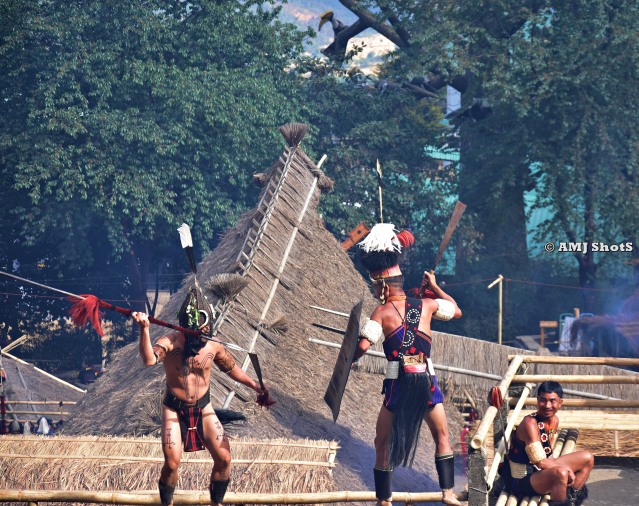
Khiamniungans recreating a fight scene with spear, dao and shield above log drum, entertaining the tourists.
Among all Naga communities, the Khiamungan emerge as culturally, territorially and structurally the most coherent group. A moiety system divides the whole tribal population called mele into two moieties or kao groupings. These two moieties are named as Lam and Shiu.

Display of a fight scene with traditional weapons by Khiamniungan Tribe
Khiamniungan (Khiamngan, Khiamniungan) is a Sino-Tibetan language spoken by the Khiamniungan people in east-central Noklak District of Nagaland in northeastern India and in northwestern Burma. The majority of the Khiamniungans in India are known to Pathso-sui which remains the main language within their geographical area.

An youngster from the Khiamniungan tribe practicing for Bamboo Stilt Race.
Their ornaments are simple but pretty. A necklace of beads with numerous layers is generally worn round the neck. The beads may be made of some kind of stone or shells. The ears are decorated with a tuft of cotton wool or red paper or anything else depending upon the individuals fancy. The armlets are of ivory or brass. In earlier days, human hair was very much sought after and women with flowing locks were the worst sufferers, but now goat’s hair is generally used.
The Khiamniungan tribals, who traditionally practised jhum cultivation (slash and burn agriculture), celebrate the Miu festival at the time of sowing. They offer prayers for a good harvest. Miu is a bonding festival, with the main purpose of building and reinforcing relations between a maternal uncle and his nephews and nieces. Maternal uncle offers special prayers to deities for granting prosperity and power over enemies to his nephews and nieces.
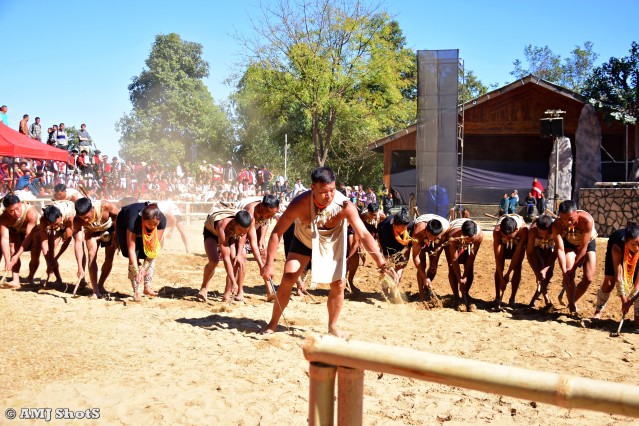
Khiamniungans showing their ways of Tilling up the agri fields and sow seeds for a good harvesting.

A khiamniungan using his traditional dao for sowing seeds in a tilled up land.
After a good harvest, Khiamniungans celebrate by feasting together with Zothu (rice beer), Okhe (stronger version of Zutho) and rice. During these times the Khiamniungan group perform a folk song “Ho-e Tsu”…..
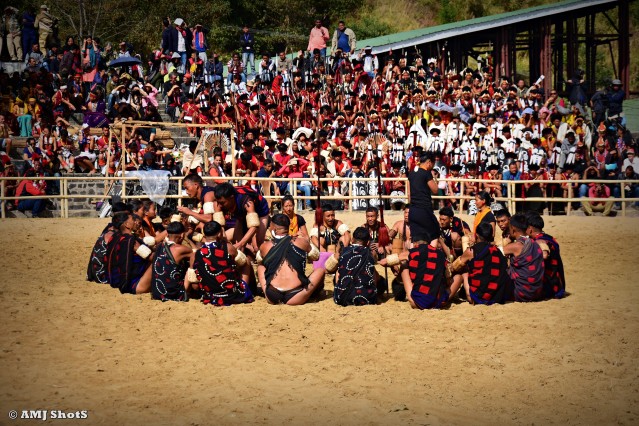
Its Feasting time – Celebrations of Khiamniungans after a good harvest in their jhum fields. Ho-E Tsu is an emotional folk song sung by them during ‘Shai’, a feast.
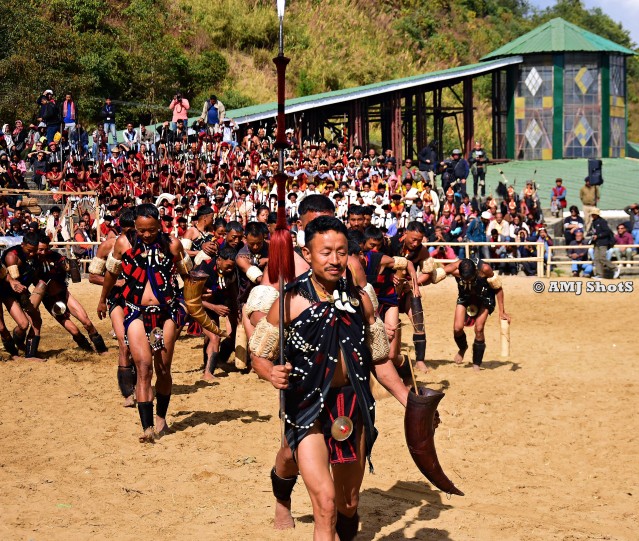
Like all Nagas, Khiamniungans drink Zutho in these big Bison horns and large bamboo cups.

Drunken Khiamniungans leaving the main arena after a good feast. Where most food stalls in the Hornbill festival sell a diluted and much lighter version drinks for tourists, the tribesmen often go for something much stronger. it tastes similar to how a neat Whiskey does.

Its happy times for these crazy Khiamniungans!…. A good feast, beautiful folk song (Ho-E Tsu) and stimulation of Zutho filled in their stomachs. Really an exciting scene for the outsiders.
“Khio Lak Tsuhang” is a warrior dance rarely performed in their village for invoking the almighty and getting blessings from their almighty. The villageonly organises this dance, when there is bad things happen like mentally ill and dumb people increase in number, epidemics, poor harvest etc.

Khiamniungan tribe showing “Phen Lou” – Its a folk song with dance performed during the Selection of a new Log from the forest for making their traditional Log Drum.
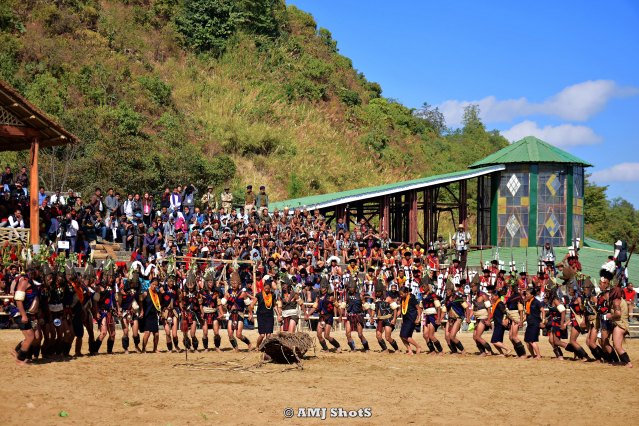
While performing Phen Lou, different types of beats and rhythms indicate different meanings and alarms.
Unlike several other Naga tribes, the advent of Christianity had little impact on the Khiamniungan for a long time, due to their remote location. The first Khiamniungan to convert to Christianity was Khaming, in 1947. Thereafter, a number of Khiamniungans converted to Christianity. After the coming of the new education system, social system, modernization and Christianity, there have been drastic changes in their social life.
When khiamniungans retreats from a successful battle, they perform “I-Yah” , meaning ‘Victory song’ and some rituals to satisfy their war deities. Victorious warriors return back to the village with heads and hands of enemies won in the battle and singing some ritual songs. Arriving at the village, the warriors hang those slayed enemy heads on bamboo poles and place them in an erected stand. Then, they loudly announces their victory in battle.
Tsokum is the harvest festival of Khiamniungans. Traditionally in villages, Tsokum festival is celebrated in the first part of October to invoke blessing for a rich harvest. During the festival, each and every family offer prayer and make sacrifices by killing domesticated animals to God for the fertility of crops, bountiful harvest, to bless the livestock and grant good health to human beings as well. The harvested food grains from the new Jhum field is brought and tasted only after the celebration of Tsokum. Further, the activities of collecting new materials for building houses and granaries begin after the festival. Also on this day, womenfolk from each family prepare and brew rice beer.
8. Konyak Nagas
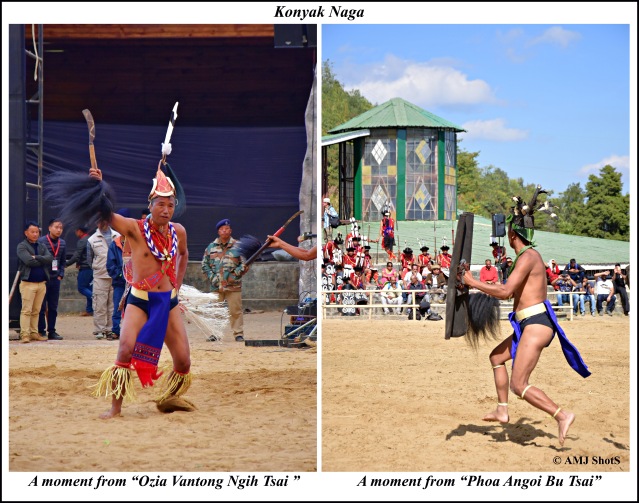
Konyak Nagas, a headhunting tribe surviving to this day in India, in the northernmost Mon district of Nagaland. They are easily distinguishable from other Naga tribes by their pierced ears; and tattoos which they have all over their faces, hands, chests, arms, and calves. They are called the land of Angh’s. They have the largest population among the Nagas. The Konyaks can be found in Myanmar, in the Tirap and Changlang districts of Arunachal, and in the Mon district of Nagaland, India. They are known in Arunachal as Wancho Konyak. The Konyak language belongs to the Northern Naga sub branch of the Sal, subfamily of Sino-Tibetan. Headhunters are a term that arouses respect and fear. The human head represents the core of our personality and the source of our spiritual strength. But for Konyaks, they were more than just trophies. According to their mythology, the head contains soul strength and power. Konyak warriors did not cut off the heads just to kill, they were killed to get them. They believe that headhunting was a necessarily act, not only to gain respect from their community but also from spirits too. When the practice of agriculture started, head hunting was a mean to attain bountiful crops. Head taking was also means of taking and controlling the soul of dead. As their belief suggests, the decapitated force passes on to the warrior, his clan and the goods he holds.
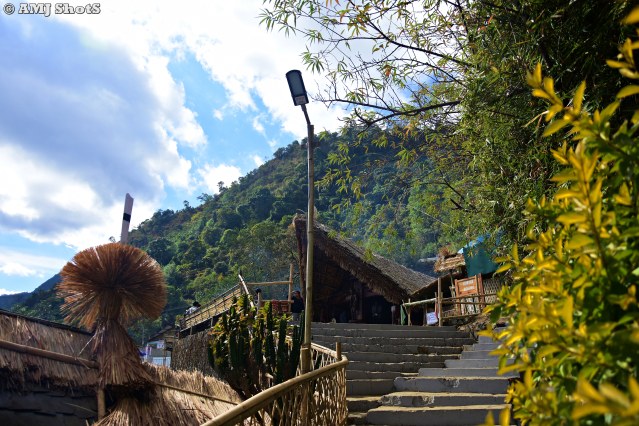
Way to Konyak Morung
It’s not difficult to recognize the last living Konyak headhunters. As an honourary mark, a young man would receive a prominent facial tattoo when he managed to take an enemy’s head. It was believed that by taking the head of an enemy as trophy, you would gain some of his power and soul. Those enemies’s heads were then hanged on the sacred ritual tree at the entrance of every villages. This was a common practice until Christianity reached them and turn those violent rituals into dust.
The Konyaks hunted human skulls because they believed only these could guarantee the fertility of their fields and people. This belief has not ended but today the skulls have generally been substituted by wooden heads, and the rituals still persist. Some rather recent head hunts have been unofficially reported. When meeting the members of this tribe you can sometimes easily feel the violent past in their blood, which makes you realize how not far away from now it actually is.. Still don’t mess with them. Period. Last reported head hunting mission was in 1970, in Myanmar.
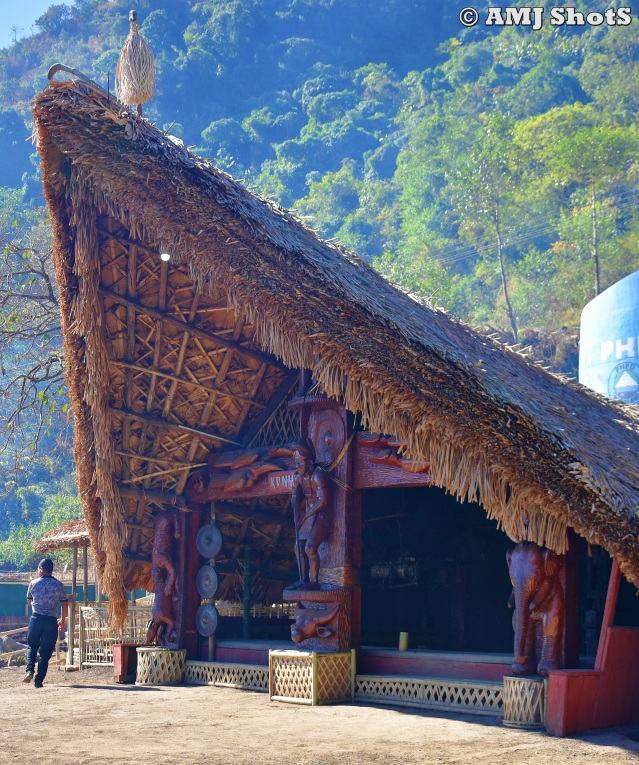
Traditional Konyak Morung or Longhouse, where they kept their wooden log drum called ‘Shum’. Shum is used to warn residents from an impending raid or for the death of a village member or to relay important messages between neighbouring villages. Symbols carved in the drum represents the history of village.Size and number of ornaments attached to the shum represent wealth and prestige of inhabitants.
Konyak tribe is known as the “face – tattoo tribe” to the outside world. Tattooing started as a form of adornment to beautify and ornament the body. Tattoos for the Konyak people was like wearing a uniform with distinguished designs that distinguished between members of a particular group, village, clan or individual as a means of identification. It displayed the distinction between a warrior and a common man, a person of aristocratic clan from other clans, an unmarried girl from a woman who is betrothed, etc. It was an event to celebrate the cycle of life of the coming of age or the transition from childhood to pubescence and adulthood, accompanied by rituals and ceremonies. Tattoos are a mark of valour and triumph in accomplishments in the warfare. During the heydays of tattooing practice, the tribespeople went about bare and did not cover themselves which made the tattoo marks prominently visible. This exhibit showed the distinction and meanings of the tattoos. Therefore, there was no Konyak person who was seen or went about without the permanent indelible patterns imprinted on their bodies.
For men tattoos and head-hunting were inseparable, to take on the enemy and bring back the head was the highest achievement for the Konyaks. In this way the warriors deserve a facial tattoo which symbolises courage and strength. The number of collected heads will be reflected in the diverse decorative tattoo patterns. These were worn like a medals of honour, as an identity and status.
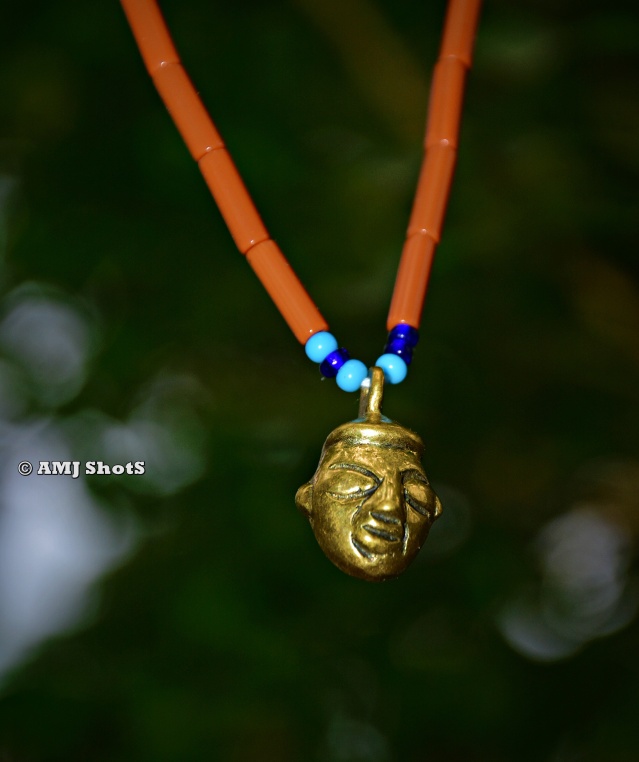
The brass necklace that every Konyak wears on his chest shows a tattooed face. The tattoo on a Konyak warrior’s face could be done only by the chieftain’s wife. The process often took more than 10 hours and was an extremely painful affair.
Tattoos for the Konyak females mark their physical journeys. Tattooing was confirmation of the coming of age of transition from one stage of life to the other that announce their place in the society of sexual maturity, marriageability and marital status (toitaipu). However, certain tattoos were placed as an honour of paying homage for the achievements of the father, brothers or male relatives in a headhunting raid. Just as her mother, older sisters and aunts before her it was mandatory for a Konyak girl to get the indelible stain on her body.
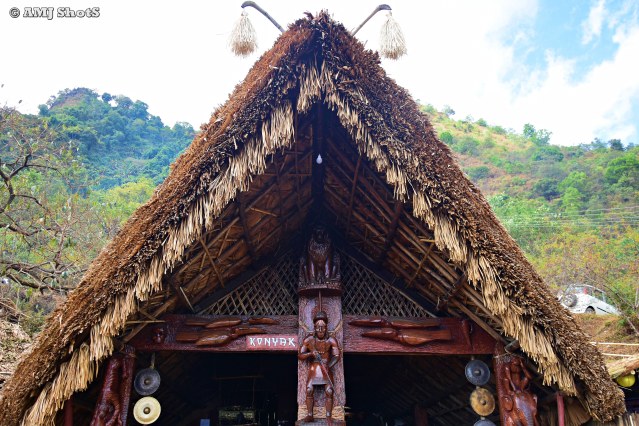
Konyak Morung – Back in the days, the tribesmen would carve a nearly-possible image of their deceased family members on the wooden frames of doors and windows, as a memory — the only way to remember them. Konyaks are famous for their wood carvings also. Once, they were the masters of wood crafts in the region and carved many sculptures presenting motifs from their everyday life like hunting and war.

Wooden carvings inside Konyak morung – Statue of singing monkey sitting above an elephant.
Konyaks built villages in strategic locations, mostly on hill tops. From there, they could easily monitor the surroundings and defend themselves against the attacks from enemy villages. It is the bamboo bridges that connects these villages with lower grounds. So, in local wars, they were the first ones to be destroyed. Longwa is the current largest village in the Mon district.
Konyak cottages in the village is set on an oval design with rooms for specific purposes. In the centre of the cottage, there is always a fire place and above it, layers of stands are designed for keeping and drying meats, vegetables and firewoods. Unlike other Nagas, the Chieftain of Konyaks posses a specific bed made from a single tree trunk. The gongs in the houses represent their wealthiness in the society. The outer walls of cottages adorned with skulls of hunted and sacrificed animals. Most of the skulls are from a local hybrid cattle ‘Mithun’. The size of the skulls, the horns and their number indicate the wealth and social status of owner.
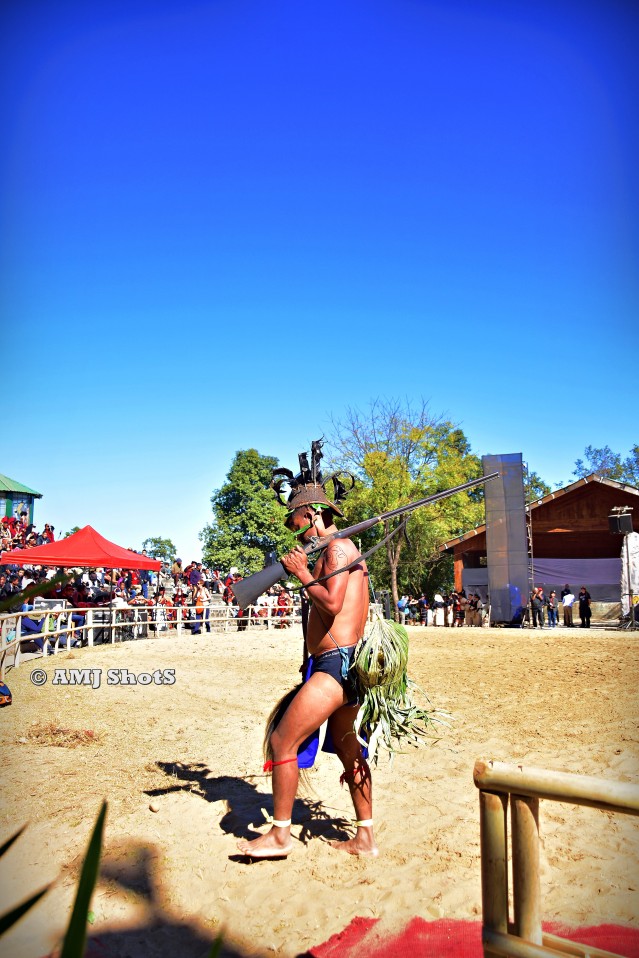
Konyak Naga with a Muzzle-loading Gun. Konyak tribe used muzzle-loading guns for their hunting, even before the arrival of Britishers. A muzzle-loading rifle is simply defines as any rifle loaded by inserting a projectile and propelling charge through the muzzle, or front end, of the gun. The Konyaks are very intelligent and ‘inventive’ tribe among the Nagas. They are the only tribe who make their own muzzle loading guns and gun powder for the weapons from simple indigenous ingredients.
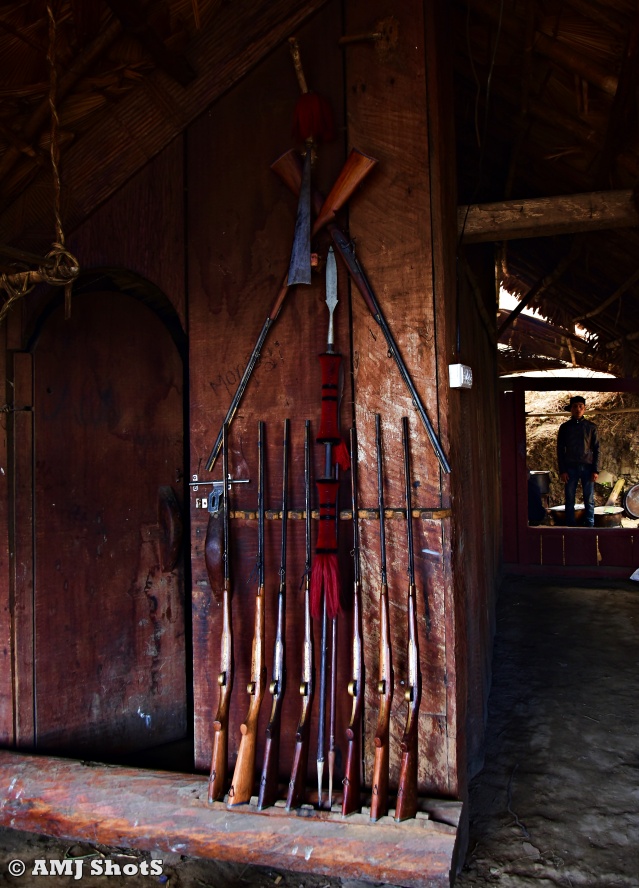
A collection of Muzzle-loading Guns, Dao and Spears arranged inside Konyak morung
Let’s see the “Traditional Gun firing practice of Konyaks”…..

Konyaks showcasing “Zansingbu Zanglan” – The practice of gun firing on their enemies with muzzle-loaders.

Konyaks performing Zansingbu Zanglan – Carefully, watching the movements of their enemy and getting ready to fire.
In Konyak tribe, each village had unique form of governing systems. The societies consisted of egalitarian communities. But a hereditary chief (Ahng) can be seen.This Chieftain can have from 3 to 6 other sub-chiefs, according to the village size, in order to maintain his social and war supremacy. Every sub-chief was in charge of a different part of the village and reports to the Chieftain. All chiefs were easily recognizable because of the clear blue beads on their legs. The more blue beads layers they wear, the most powerful and respected they were. They used to get bribes from the conquered villages all around, even sometimes 50km away from their own village, beating drums on huge carved dead trees to pass messages from villages to villages. The Chieftain’s house was always at the top-center of village.

Lamphoon Moarao Man Thoa Haap – A war skill game played by konyaks.
Konyaks were originally animists, believing in many different spirits. But all these spirits were ruled over by one God called ‘Kay Wang’. Konyaks were the last among the Naga tribes to accept Christianity. Christian missionaries and British colonialists convinced or forced the Konyaks to Christianity, in order to make them giving up the habit of cutting off human heads, hence conquer them easily. The Konyak tribe resisted christianization and modernization for longer than most other Nagas tribes because wars and headhunting were an essential part of their ritual life in the past.
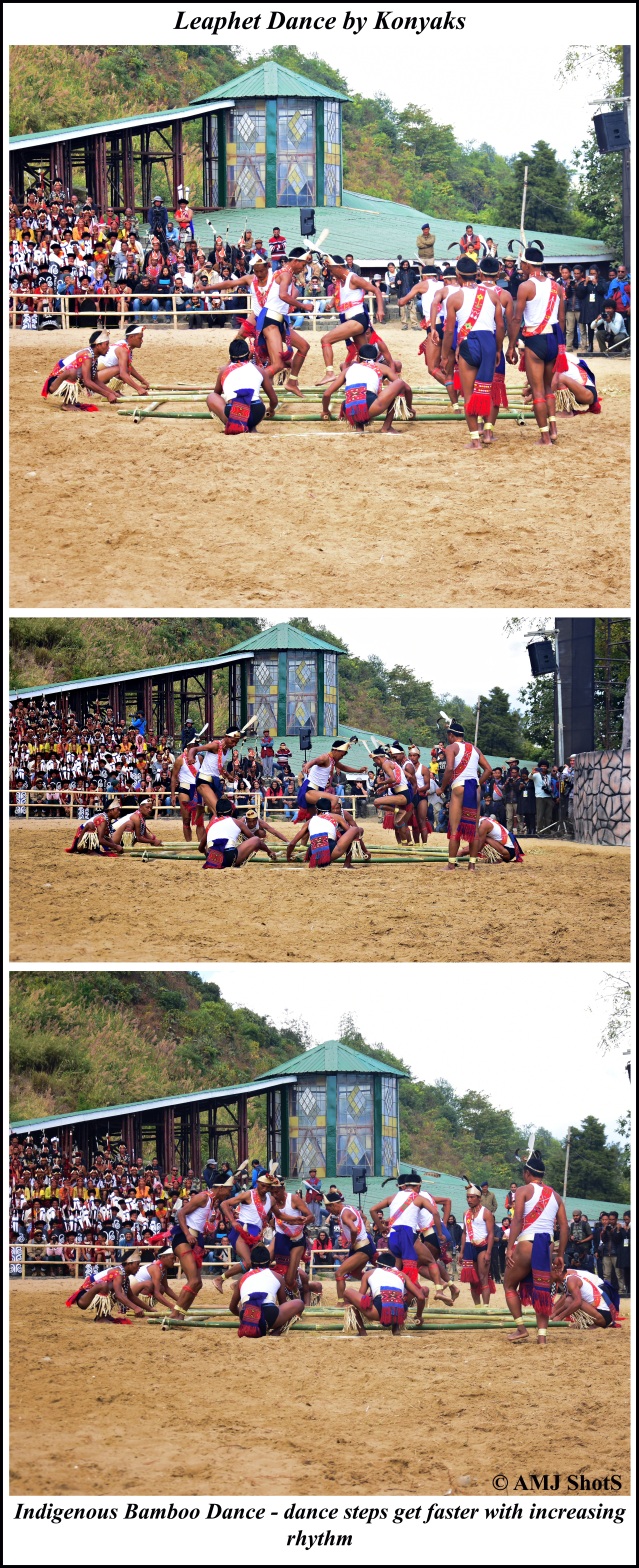
“Leaphet Dance” – Konyak troupe performing an indigenous bamboo dance which is characterised by the use of bamboo staves, kept in cross horizontal forms on the ground. This dance is a part of physical training imparted to the youngsters.
The Konyaks plantation system, as most the Nagas tribes, is the slash-and-burn cultivation. As its name can tell, this type of cultivation destroys the jungle and its entire biotope, forcing big wild animals, such as bears, panthers and tigers which used to live in this area, to totally disappear. Marriages are monogamous, except for the Chieftain of the village, as he could have several wives and concubines.
Konyak troupe demonstrating “Phoa Angoi Bu Tsai”, or Top spinning dance. This dance is played when an old field is being abandoned for a new one; singing songs to the old field.
Aoling Festival (sometimes spelt as Aoleng) is the most important festival celebrated by the Konyak Naga people and held in the first week of April in the Mon district of Nagaland. The Aoling Festival celebrates the arrival of spring and prays for a good upcoming harvest. The celebrations coincide with the start of the Konyak New Year. However, dates can change as the festival is celebrated in villages across the district with no defined schedule. You have to ask around about where and when events are taking place when you get there. The main purpose of the Aoling Festival is to welcome in the spring and new year and to pray for a good harvest. During the Aoling Festival many rituals take place including dancing, feasting and sacrifices that are meant to appease the divine spirits in order to bless the land with a good harvest. The first 3 days of the Aoling festival are called Hoi Lah Nyih, Yin Mok Pho Nyih and Mok Shek Nyih. These days are spent preparing for the festival by weaving traditional cloths, collecting the animals that will be sacrificed and preparing food and rice beer for the festival. The fourth day, known as Lingnyu Nyih, is the most important day, in which all the members of the Konyak tribe dress up in their best colorful traditional tribal clothes and jewellery. The fourth day is the most interesting to watch as the whole day is spent dancing, singing and feasting as a community and the indigenous dances that they perform symbolize the tribe’s history as headhunters. The final two days of the festival are called Lingha Nyih and Lingshan Nyih. This time is dedicated to spending time with family and cleaning the whole village and also individual houses.
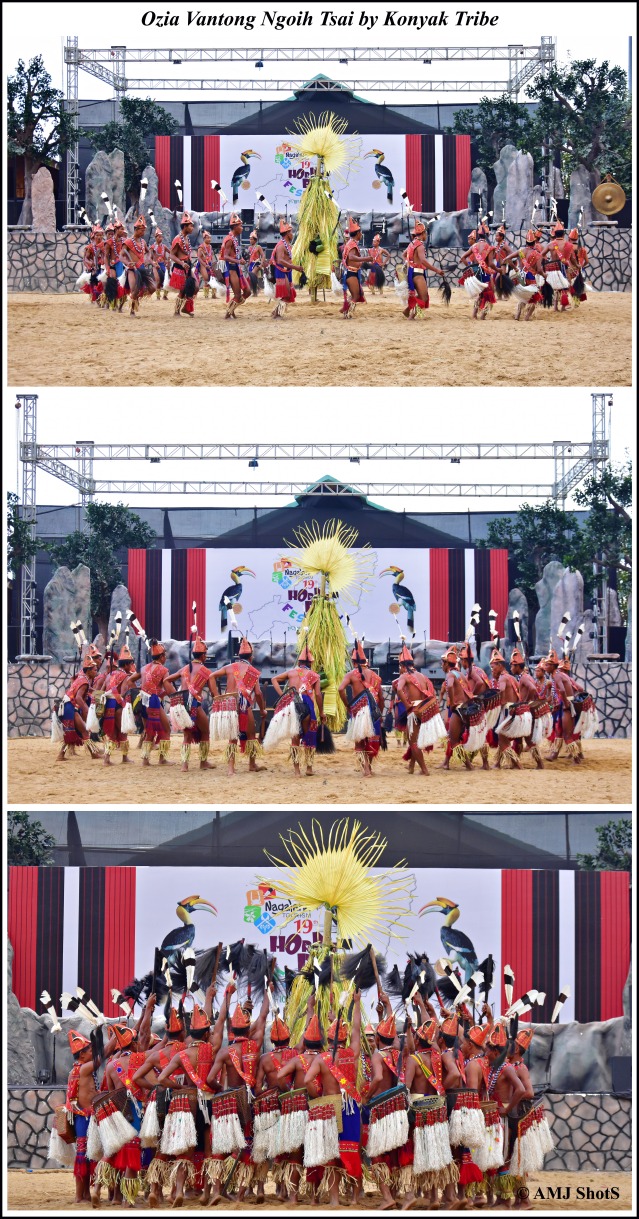
“Ozia Vantong Ngoih Tsai” (A folk song with dance) – This song and dance was performed around the Zangvun (A decorated bamboo pole) under which they lay all the trophies from a war raid as a sacrifice to the gods. “Lulu Yeinu & Oyuh Meilo”, is the traditional dance performed by the Konyak tribe around the Zangvun signifying the God of blessings. When festivals are over, the farewell song is also sung around this Zangvun.
The tradition of Opium smoking is an important part of Konyak culture, which was introduced by British raj to downgrade their skills and smartness in earlier days (1870’s). In a world, where the hunter at any time could become a victim himself, opium could give an illusion of security and happiness for a moment. It became even more important as the Konyaks tried to accept the end of their old ways of life. Today opium is smoked by all men, using ritual pipes made from bone or bamboo, called ‘Kite Sang’.
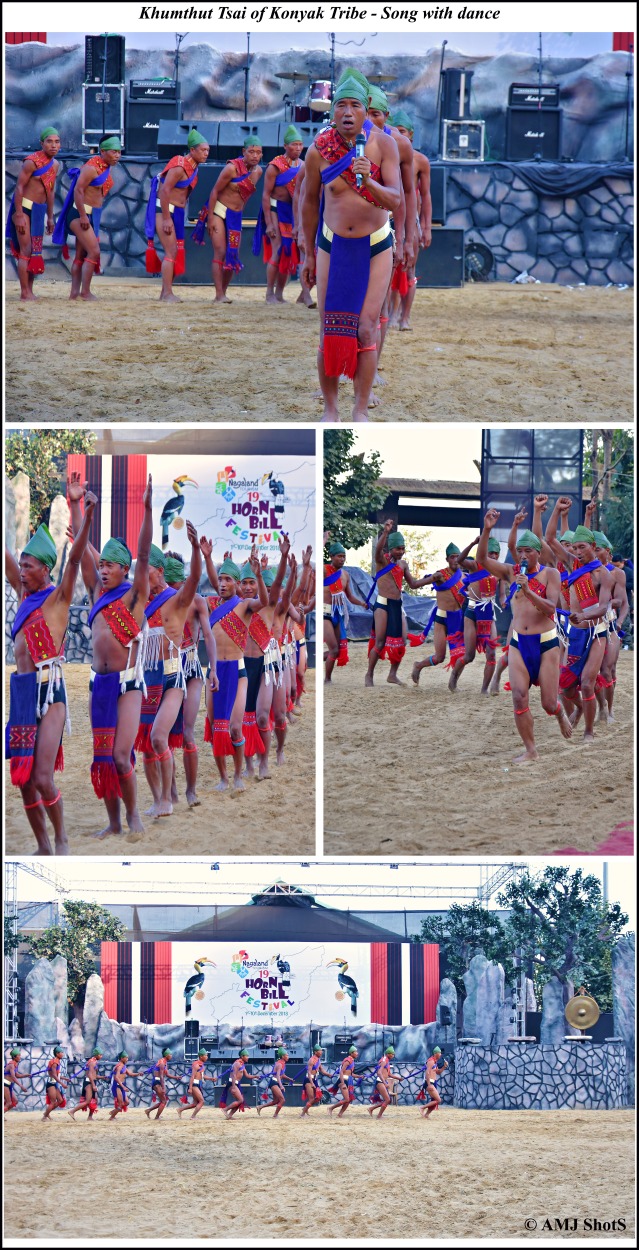
“Khumthut Tsai” of Konyak Nagas – A folk song with sung dance, as they play the log drum, there are different rhythms of beats signifying different meaning.
The most respected Ahng (Chieftain) among Konyak Nagas is Rhonggang Konyak, popularly known as Khaopa (Born in 1923 – died in 4th September 2001). He was the Chieftain of Sheanghah village, survived by 4 Ahngyas (Queens), 18 wives, 19 sons, 7 daughters and 59 grand childrens. He was a true hero of konyaks who hunter 36 heads. During his period, the followers hunted 130 heads….. Thats how ferocious, Konyaks were!…….
9. Kuki Tribe of Nagaland

“Kuki Tribe” of Nagaland. The male of Kuki tribes wear colourful Sangkhol, a jacket, and a pheichwam. Nih-san is worn by the women folk. Bilba, Hah-le-chao is the ornaments worn by the Kuki women.
The Kukis constitute one of several hill tribes within India, Bangladesh, and Burma. As Chin in the Chin State of Myanmar and as Mizo in the State of Mizoram in India are a number of related Tibeto-Burman tribal peoples spread throughout the northeastern states of India, northwestern Burma, and the Chittagong Hill Tracts of Bangladesh. In Northeast India, they are present in all states except Arunachal Pradesh. This dispersal across international borders is a culmination of punitive actions made by the British during their occupation of India.The origin of Kuki tribe is full of myths and mythologis. They are the mixed group of tribes who entered India from Burma and Central Asia. According to the traditional myth the Kukis are believed to originate from the Bowles of the earth or cave called Chinlung or Khul. The Kukis form a part of the great Mongolian race. They belong to the Tibeto-Burman family of the Tibeto-Chinese race.
During World War II, seeing an opportunity to regain independence, the Kuki fought with the Imperial Japanese Army and the Indian National Army. led by Subhas Chandra Bose but the success of the Allied forces over the Axis group dashed their hopes.
Patraitic custom is followed in the society that is the son inherits the father’s property. Physically they are stout and strongly built. The Village Headman is in charge of the village and they follow their old custom, habits and traditions. Kuki males are good hunters. Let’s see the Celebrations of Kuki tribe after a successful hunt fom the wild – “Savai Lhun”…..
Savai Luhn of Kukis is a celebration after the return of a successful hunter from the wild. After a successful hunt in the wild, the Kuki hunter carries the hunted animal all by himself and heads back to the village. There he marches around along with his relatives with joy and pride. Then, the Chieftain acknowledges the successful hunt and offers him rice beer. Following it, the hunter jumps around, shouting his declaration of having dominance among the other village members. Finally, the whole village celebrates the success with folk songs and dances.
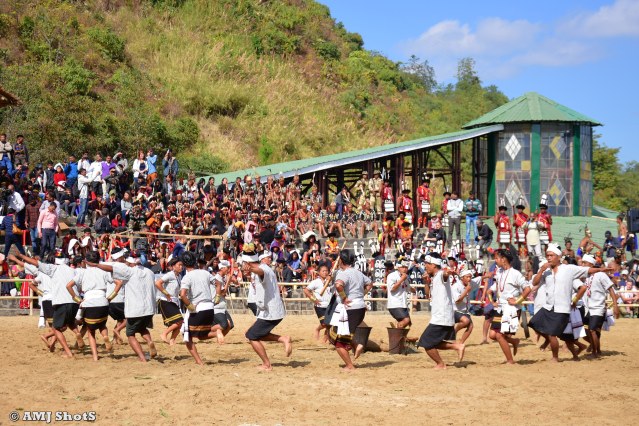
Savai Lhun – The celebration of Kuki tribe after a successful hunt in the wild.
Among Kuki tribe, Sawm is a community centre for boys – was the centre of learning in which the Sawm-upa (an elder) did the teaching, while Sawm-nu took care of chores, such as combing of the boy’s hair, washing of the garments and making the beds. The best students were recommended to the King’s or the Chief’s service, and eventually would achieve the office of Semang and Pachong (ministers) in their courts, or Gal –lamkai (leaders, warriors) in the army.
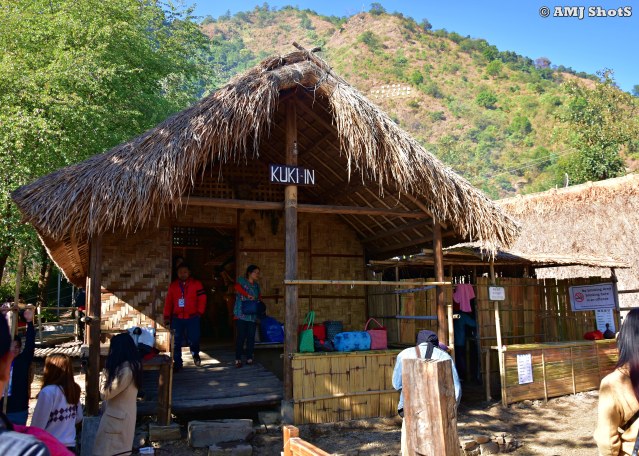
Lawm (Lom or Kuki Morung) – Lawm (a traditional type of youth club) was an institution in which boys and girls engaged in social activities for the benefit of the individual and the community. It was also another learning institution. Every Lawm has a Lawm-upa (a senior member), a To’llai-pao (an overseer or superintendent) and a Lawm-tangvo (assistant superintendent). The institution also facilitated the transmission of both technical as well as practical knowledge to its members, especially with regard to particular methods of farming, hunting, fishing and sporting activities such as Kung–Kal (high jump, especially over a choice mithun), Ka’ng Ka’p, Ka’ngchoi Ka’p (top game), Suhtumkhawh (javelin throw using the heavy wooden implement for pounding-de-husking-paddy) and So’ngse (shot put). The Lawm was also a centre where young Kuki people learned discipline and social etiquette. After harvest season, the Lawm meet is celebrated with a Lawm-se’l and, as a commemoration, a pillar is erected. The event is accompanied by dance and drinking rice-beer, which sometimes continues for days and nights.
Each Kuki tribes has a number of clan. Marriage within the same clan is discouraged and inter clan marriages are permissible. Bride price is present. They follow patriarchal system and the sons inherit the father’s property. Kuki tribes are ruled by hereditary chief who possess unlimited power. He is considered to be the supreme of the village.
Agriculture is the main occupation of the Kuki tribe. They produce their crops by Jhum cultivation. They are good horticulturists. They grow pineapples, lemons, gingers etc. they are good at craftsmanship also. The Kuki tribe lives in hill top and houses are of cluster type and build with wooden platform.
Suhta Lam, Lom Lam, Jangsha Lam, Jangsha Lam and Vakol Lam are few main folk dances of Kukis. ‘Lam’ means dance in Kuki dialect. Kuki women used to wear Khamtang, Pong Mong Vom, Len Boung Thom, Nih San, Pon Lem Nei, Pon Lem Nei, Hahle Chao and Bil Kam traditionally. Men’s traditional dresses are Saipi Khup, Thang Nang, Pondum, Ponlhe, Boi-tong, DelChen, Tuh-Pah.

“Suhta Lam” (bamboo dance) of Kukis – This dance is generally performed near the ‘Sawm (Som) Buh’ (bachelor’s dormitory), in which all the young boys of the village sleep together at night. dance in order to recruit strong and able young men to his military unit. It is a dance performs with the help of a wooden pole, which is used for the husking of paddy. Four young men holding the wooden rod claps the wooden pole against the ground while four able young men dance, encircling the wooden rod.
Sutha Lam, originated from the story of a village chief’s daughter and an orphan boy who were lovers. The chief asked the boy to undergo a test. His test was to jump in and out of the ensuing gaps successfully to the measure of speed timed by the drum. He successfully got through the test by singing “chom chomdoh in” which means “jump in, jump out”.
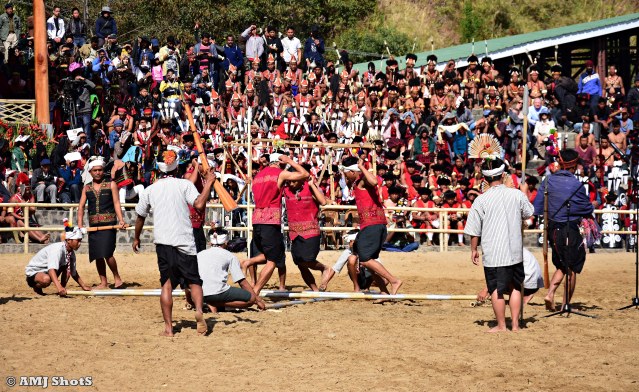
Suhta Lam of Kukis – Later on this dance is introduce to the member of the Som: a dormitory of young boys and girls. The dancer dances between four men or women who face each other from opposite side of a square, each pair holding two bamboos one each in one hand. As the one pair close their bamboos together, the other pair parts theirs at right angles and so in alternately in varying time. The dancer has to skip from the spaces formed by the closing bamboos into those formed by the parting bamboos in time to the singing and with enough agility to save his or her ankles from severe confusion. From then and now, Suhta Lam is performed in front of the Som Buh to punish the wrong doer among the members of the Som.
The main festivals of Kukis are Ai-San, Sel-bonchon, Lom Kivah, Mimkut and many more. Ai-San festival is related to hunting. In Kuki, Ai means wild turmeric which has very significant role in Kuki traditional rituals. This particular ritual is done to get blessing of ‘Allhimipu’ for hunter to attain success.
Sel-bonchon festival is about wrestling with Mithun. About sixty people gather around the Mithun and performed body- swaying movements with clapping. A few young boys then wrestled with the Mithun and try to excite the animal. This ritual is more fun and this is the platform where youths show their bravery and strength. After the game is over the Mithun bring back to the hunter’s house, performed Selangboh rite and then the Mithun is killed. After that Sel-mei-lah ritual is performed where one person is selected to stand by the hunter in the time of his misfortune. Then Mithun is chopped and distributed. The feast is celebrated with great merriment. The entire guest is served wine and meat. The singing and dancing continued till the morning which is called ‘Sajanha’. Next day there is ‘Lom’ ritual where ‘Lom Ihah na Ju’ (a special wine for youths) is prepared in the host’s house and they celebrate with ‘Lom Lam’ dance. This is the great Kuki ritual of Sa-ai.
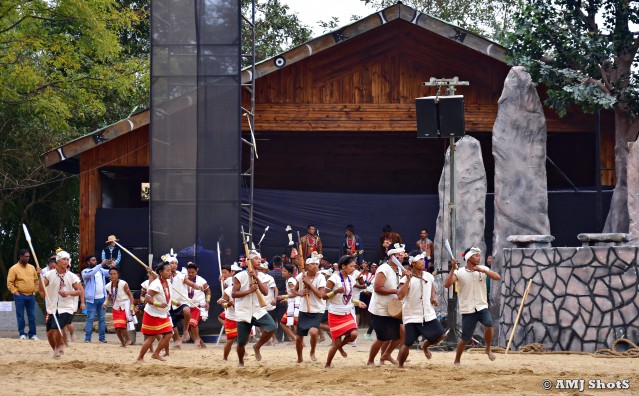
“Lom Lam” of Kukis – This dance is performed during the post harvest festival, Mimkut. It is performed in front of the Kuki Loms (Lawms). All the villagers including the widows participate in this dance. Then, the seniors of the village acknowledge the hard works of men folk, during the harvesting season and express their undying gratitude to them.
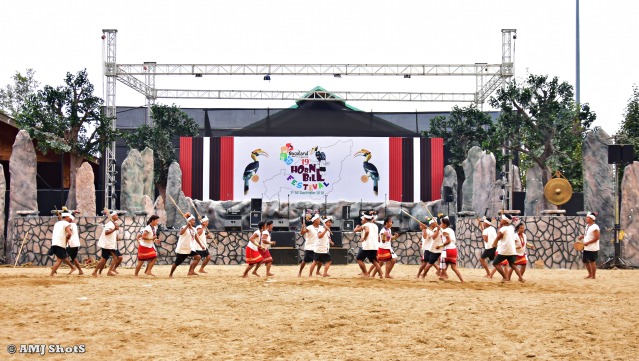
Lom Lam of Kukis – A festive dance during the post harvesting festival in the month of January, Mimkut.
Lom Kivah, another festival of Kuki’s to represent the integration of Kukis from ancestors’ times. Here also Mithun is killed and the festival is celebrated with drink ‘Ju’. Chavang-Kut This festival is celebrated in the autumn season ie in the month of November and December at the end of the harvesting season. In this festival they thank to God ‘Pathen’ for the guiding the whole year in their works of life. After that ‘Kut’ celebration is organized by the village Chief. In the morning the Priest of the village offer a sacrifice of white fowl for the evil spirit and make an incarnation. Villagers wear traditional dresses and the women folks bring their fermented rice beer in their pitchers. Several games like Bonkho, Suhkho, Kungkal, Selkal played till the noon. In the evening huge feast is served to all the villagers. Bon-fires are set and all the villagers enjoyed with rice beer till late night.
“Jangsha Lam” of Kuki tribe – A folk dance with song related with the story of a local hero ‘Jangsha’. The folk song describes the heroism of Jangsha in avenging the murderers, responsible for his father’s death. It’s a martial art dance.
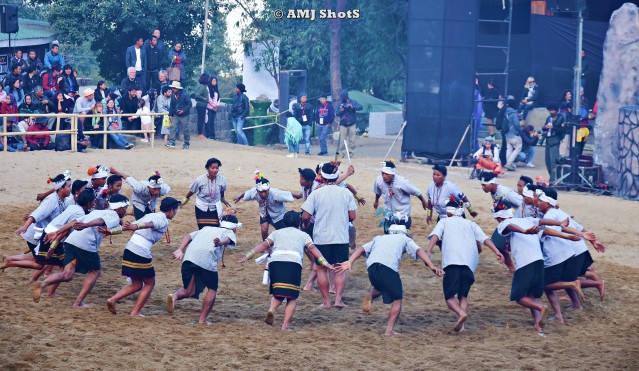
Jangsha Lam of Kukis showcasing the heroism of Jangsha Kuki
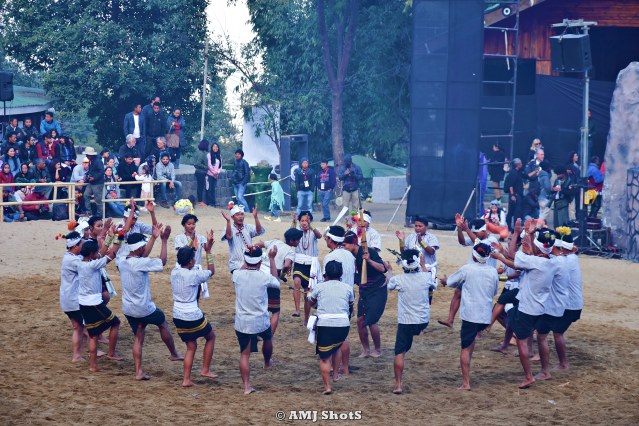
Kuki Troupe performing Jangsha Lam, a folk song with dance
Some of the important traditional musical instruments are – Kho’ng-pi (big drum), Kho’ng-cha (small drum), Dah-pi (gong), Pe’ngkul (trumpet), Gosem (bagpipe), Theile (flute), Se’lki (horn), Lhe’mlhei (a peculiar mouth instrument) etc. These instruments were useful not only for raising the festive spirit, but also for adding solemnity to certain serious occasions.

“Vakol Lam” (Hornbill Dance ) of Kukis – Vakol Lam is a dance (praising about the freedom of Hornbill bird) in which four couple arranged in a square cooperates to execute various figures. While the girls move with smooth shuffling steps, the boys brandishing their sword move with bending their knees. These shuffling steps continuous for three times and then a chorus of men and women who formed separate parallel line join them in the dance. Vakol Lam is a popular dance of the youth, performed at social events such as weddings, childbirth, village festivals etc.
Mimkut is a harvest festival of Kukis, celebrated for a week from the 17th day of Kuki month of Tolbol (January). It is said that Mimkut and other festivals started in order to appease Thilha, the demon. The village medicine man (Thempu) sacrifices fowls and performs a series of rituals to propitiate the spirit of the demon-god during this festival.
The selected moments shown above are from the cultural sessions, organised in the Kisama heritage village during Hornbill festival 2018. Exciting and intriguing scenes of remaining 8 Nagas will be added in Part 2 of this blog. Now its time to showcase some other fascinating experiences from the festival of festivals.
Other interesting traditions, competitions and art performances from Hornbill festival 2018 :
1.Traditional Fire making competition of Nagas
Fire making is an important tradition among Nagas. It is an act of survival in Naga villages because of the strong air conditioning effect of their tropical climate, sometimes as low as 3 – 4 degree Celsius…..

Traditional Fire Making competition of Nagas – Altogether 12 participants representing different tribes competed for the coveted title in their own traditional ways. The contest held on the 2nd day of the festival.
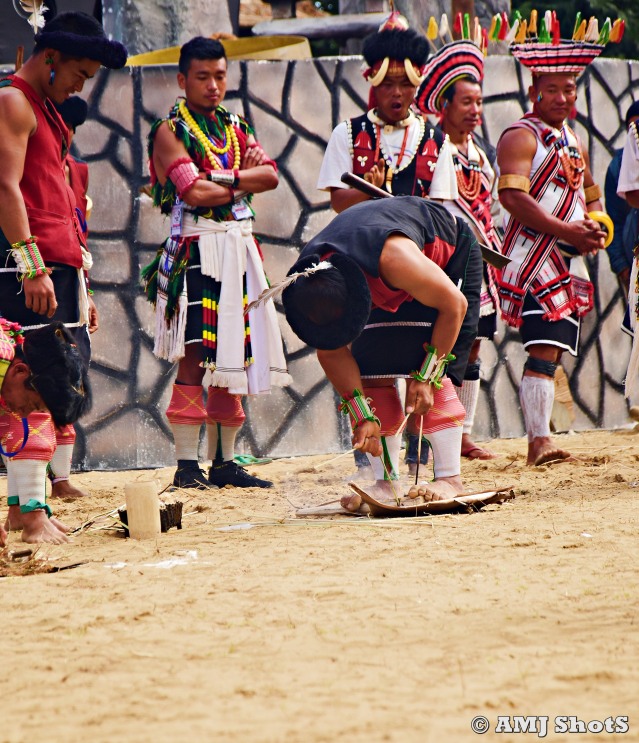
Efforts of Lhoupe Tepfo (from Chakhesang tribe) in fire making contest. Finally, he clinched the 2nd position by creating fire in 8 minutes.

Traditional Fire Making contest – Efforts of Litsase Sangtam, representing the Sangtam tribe.
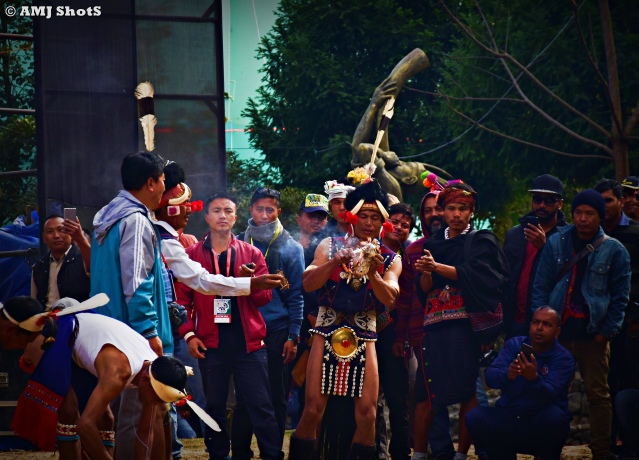
The winning moment of Litsase Sangtam, who emerged as the winner among 12 participants competing in the Traditional Fire Making competition.
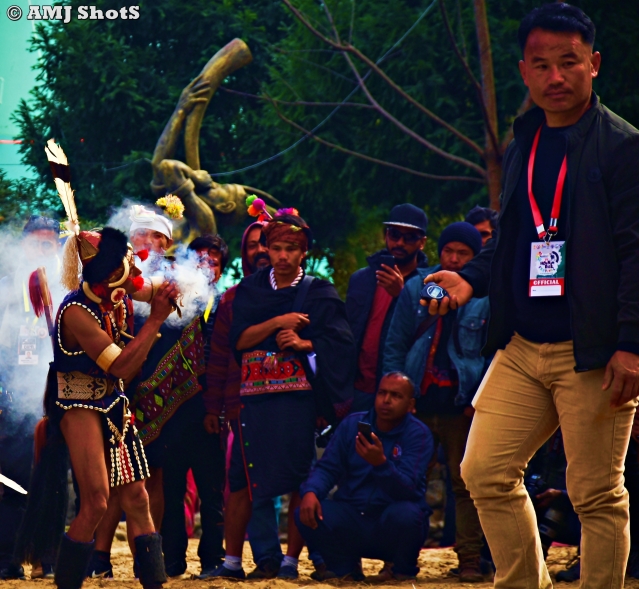
Litsase Sangtam, lits the fire in just 1 minute 40 seconds and clinched the 1st position. An amazing moment for the whole Sangtam tribe….
2. Performances of Korean Artists at Hornbill festival 2018
Exploring cultures, which have no boundaries in this world, can excites the traveler in you. This is an example for it…..
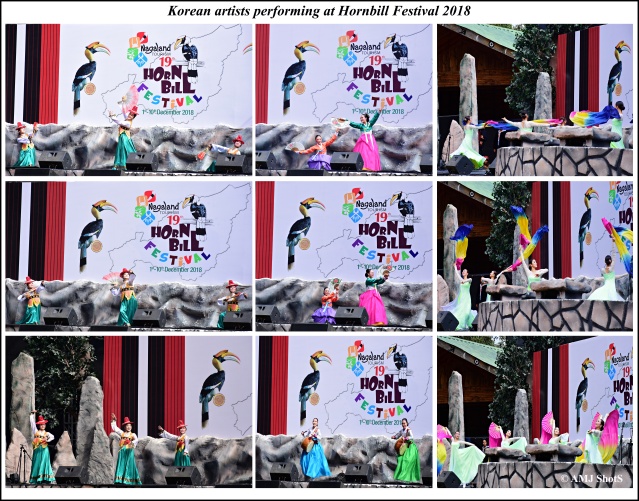
On the fifth day of the festival, people were astonished by spectacular performances of the visiting Korean cultural troupe who performed number of folklores, folk songs and dances showcasing vibrant colours in the Korean culture.
3. Bamboo Stilt Race competition of Nagas (5th day)
Sports can entertain the real man in you. As a part of sport entertainment in the Hornbill Festival, the Stilt Bamboo race organised by the Youth Resources Department was held at Kisama main arena. A total of 14 participants from each tribe took part in the event.

The Stilt bamboo race was a sport played by the men folk to race amongst themselves to test their strength, skill and flexibility. After two heats of race, the three winners of Stilt Bamboo Race 2018 were Wera Krome from Chakhesang tribe who emerged as the winner while Tosa from Konyak tribe and Imrongtoba from Ao tribe bagged the second and third positions respectively. The three winners also received cash prizes.
4. Juicy Pineapple Eating Contest for tourists (5th day)
Nature tastes better than anything in this world. So, Pineapple eating competition blew off with grand success with tourist enjoying the tasty and juicy organic pineapple grown in Nagaland. I think even watermelons can’t compete with Naga pineapples in the matter of juiciness.
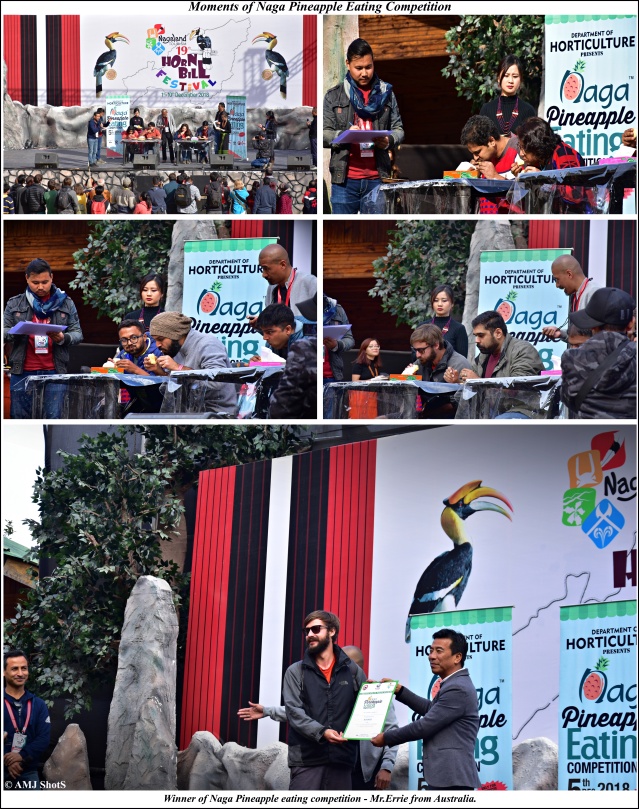
The event was organised for the first time by Horticulture department. Errie from Australia walked away with first prize finishing four enormous pieces of pineapple within one minute. He commented that the pineapples were juicy and the sweetest pineapple he had ever tasted before. Actually, Australia is the motherland of pineapples.
5. The Night Carnival at Kohima – ‘A festival favourite’
The Night Carnival is one of the regular features of the Hornbill Festival. It is an event where people throng various stalls that host everything from music to retail products to food. It extends from December 1st to 10. This time around, some organisations introduced more other carnivals at various locations in Kohima town. In addition to the regular night bazaar in the main town and High School junction, one will experience more happenings at the BOC Junction, right below the police headquarters and the WW II ‘tank park.’

In the main town, the Kohima Chamber of Commerce Industry (KCCI) is organiZing the night carnival. Like any other years, the main town’s road was closed to vehicles and has been made an open passage for people and revellers.
Visitors can browse through a variety of consumer products and items on sale including food, decorative items; tattoo shops, photography, automobile ticket booking counters; free testing for HIV; and many more. One can find a similar variety of novelties and consumables at the High School Junction as well. A nice atmosphere to experience the local Naga delicacies….
While live performances happen at the main arena in a ten days period, the entire state witness some other activities, which include badminton championship, angling, horse riding, kids carnival, offroad rally, peace rally, go kart racing, shooting competition, wrestling, boating, trekking, strongest & fittest man competition, Miss Nagaland competition, Naga chef competition and many more. A craft exhibition centre, photo gallery and an artist’s corner which display marvelous works of numerous artists. I can share some of them in my next chapter.
That’s it for the day. Time to close this chapter. A short withdrawal from these intriguing moments with a promise of return. While i sit back and thought about my relationship with this journey, a misfit traveler trying to settle together an authentic experience of a cultural festival that keeps a vibrant face and how those spirited colours changes my perspective of being supreme in this society. So,please, stay tuned for Part 2 of this journey……
****************************To Be Continued***************************
Categories: Festivals of India, Nature, Tribes of India











Thank you Amal MJ for bringing all the detail under one roof and for the wonderful pics.
LikeLiked by 1 person
You are welcome, my friend… Its only half of a 3 months work… Please, stay tuned for the 2nd part, which will be ready in a 2weeks time.
LikeLike
Wonderful work Amal. Very informative with fantastic photos. Love the way you represent. Great work. Hope to see more in future
LikeLiked by 1 person
So glad, you liked it. Its my pleasure to share these works, with people like you.
LikeLike
Wonderful virtual historical tour😊
LikeLiked by 1 person
Thank you so much😀👍✌
LikeLike
That’s superb. Very well covered. Do visit my website insightful.co.in to give your views.
LikeLiked by 1 person